Inbox and Environment News: Issue 598
September 10 - 16, 2023: Issue 598
Trafalgar Park Newport: Playground Renewal - Feedback Invited
- completing the comment form here
- emailing council@northernbeaches.nsw.gov.au
- writing to council marked 'Playground renewal - Trafalgar Park, Newport’ to Northern Beaches Council, PO Box 82, Manly NSW 1655.
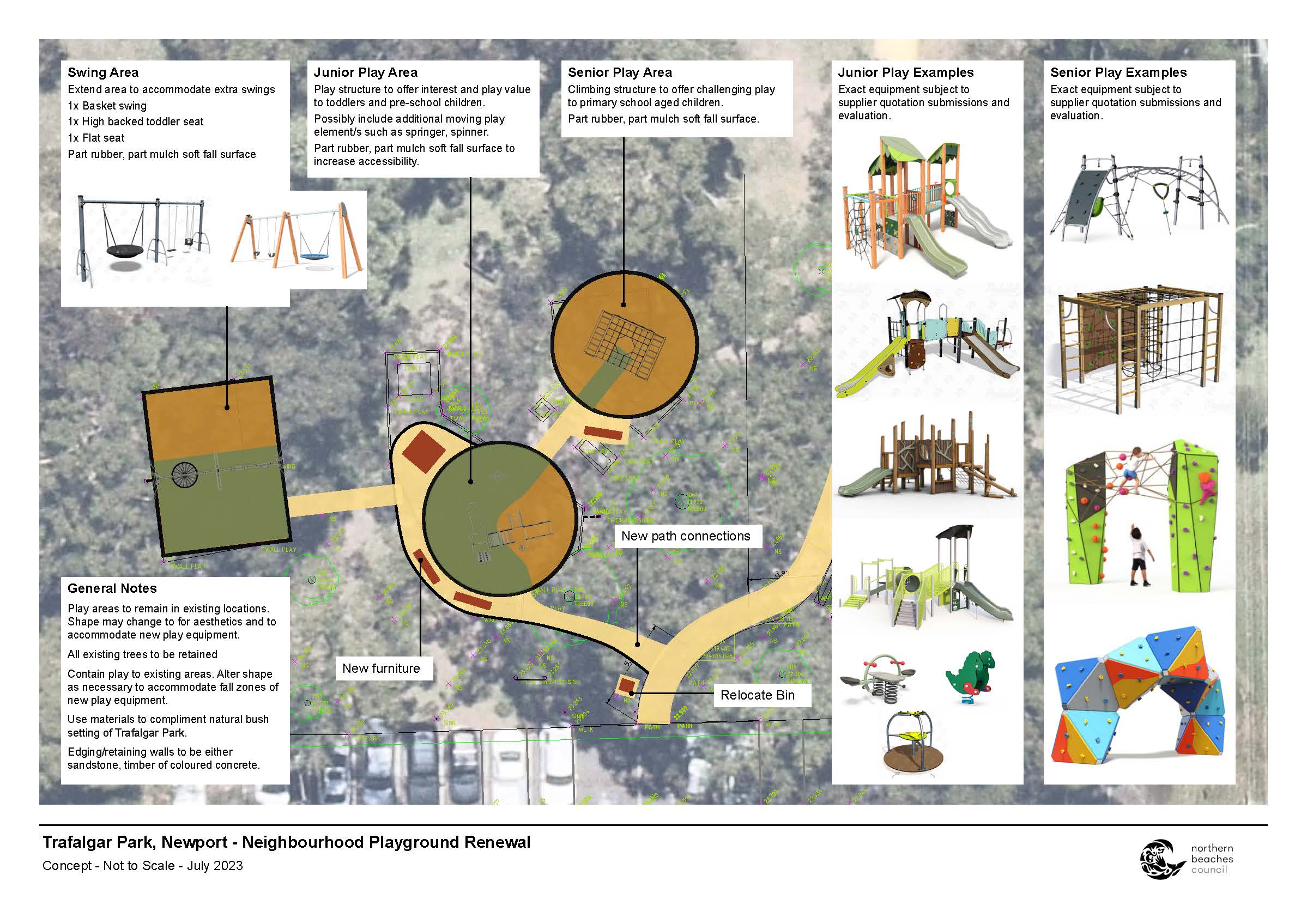
September Is Biodiversity Month: Time To Repair, Restore, Respect Our Plants And Wildlife
- go on a Bush walk in your area,
- look out for and after our wildlife and plants
- keep a nature journal or connect with nature,
- share your observations with the iNaturalistAU community.
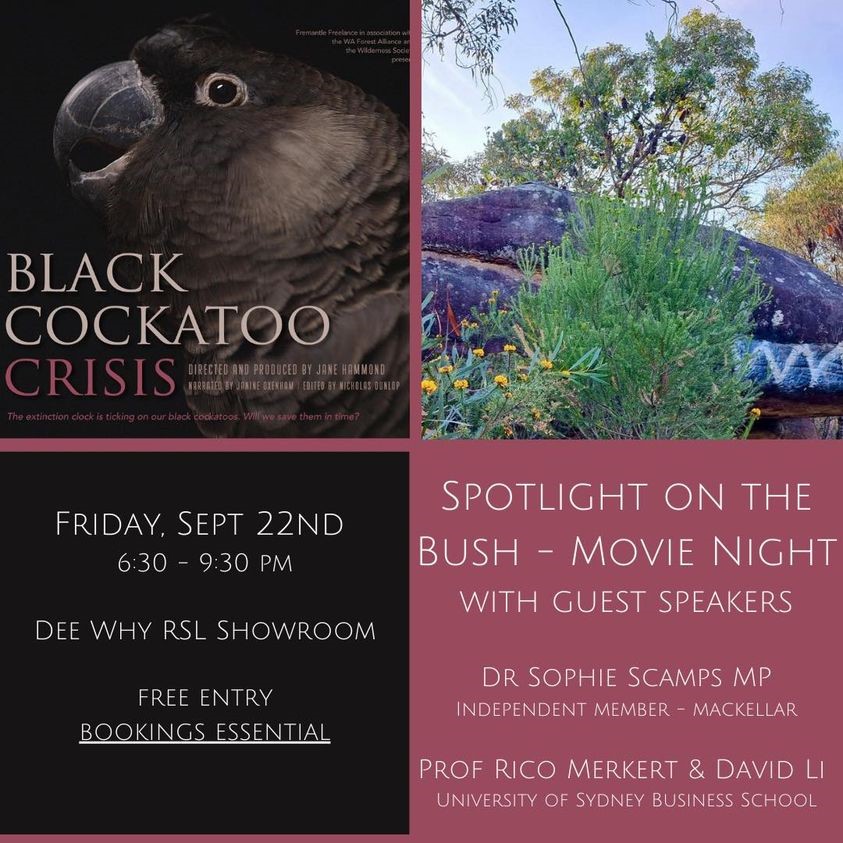
- 6:30 pm arrival for a 7:00 pm start
- 7:00 pm - 9:00 pm - Screening of Black Cockatoos Crisis Movie and Guest Speakers
- 9:00 pm - 9:30 pm - Social drinks
The Powerful Owl Project: It’s Fledging Time!
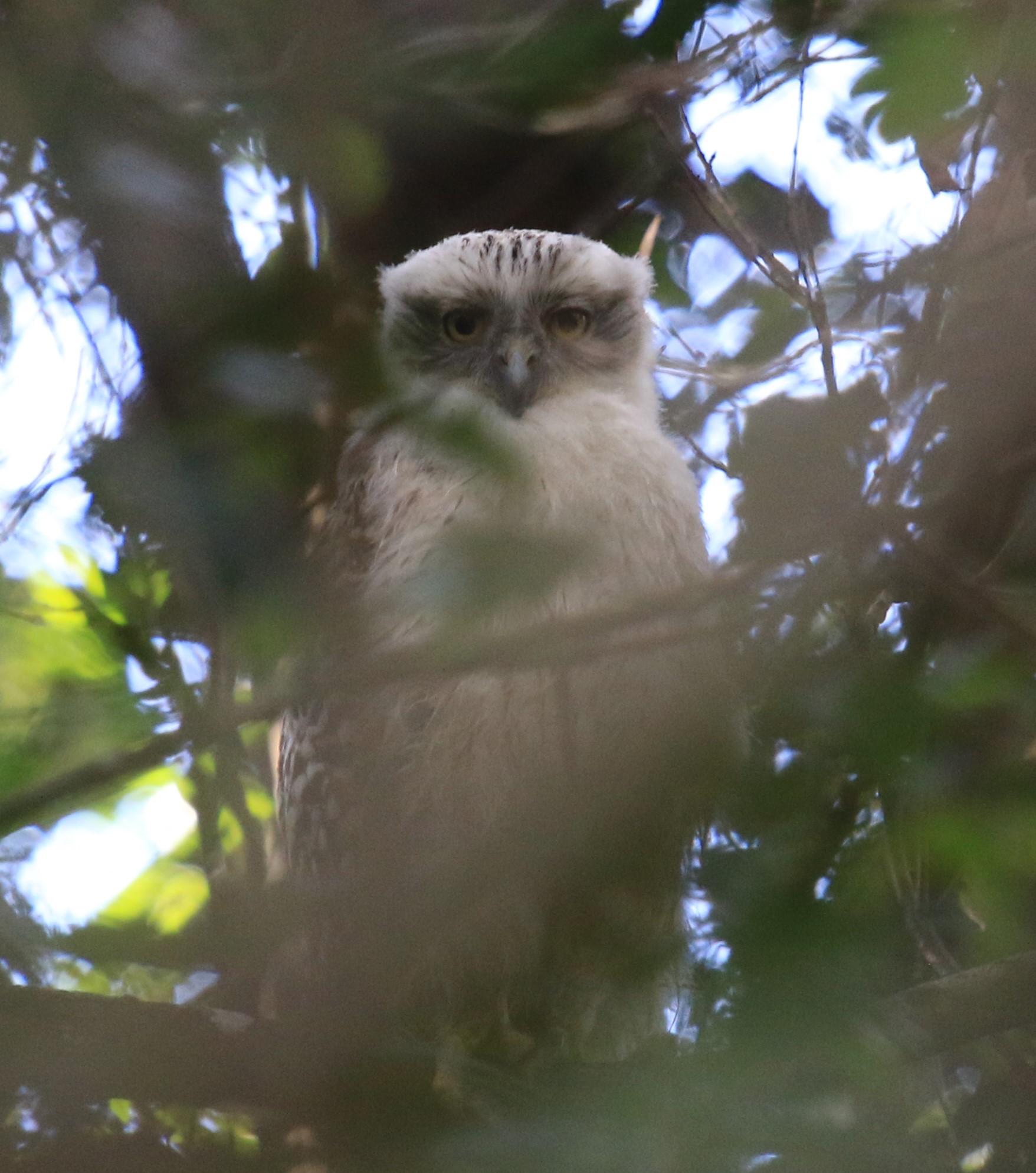
Stony Range Spring Festival 2023: Sunday September 10
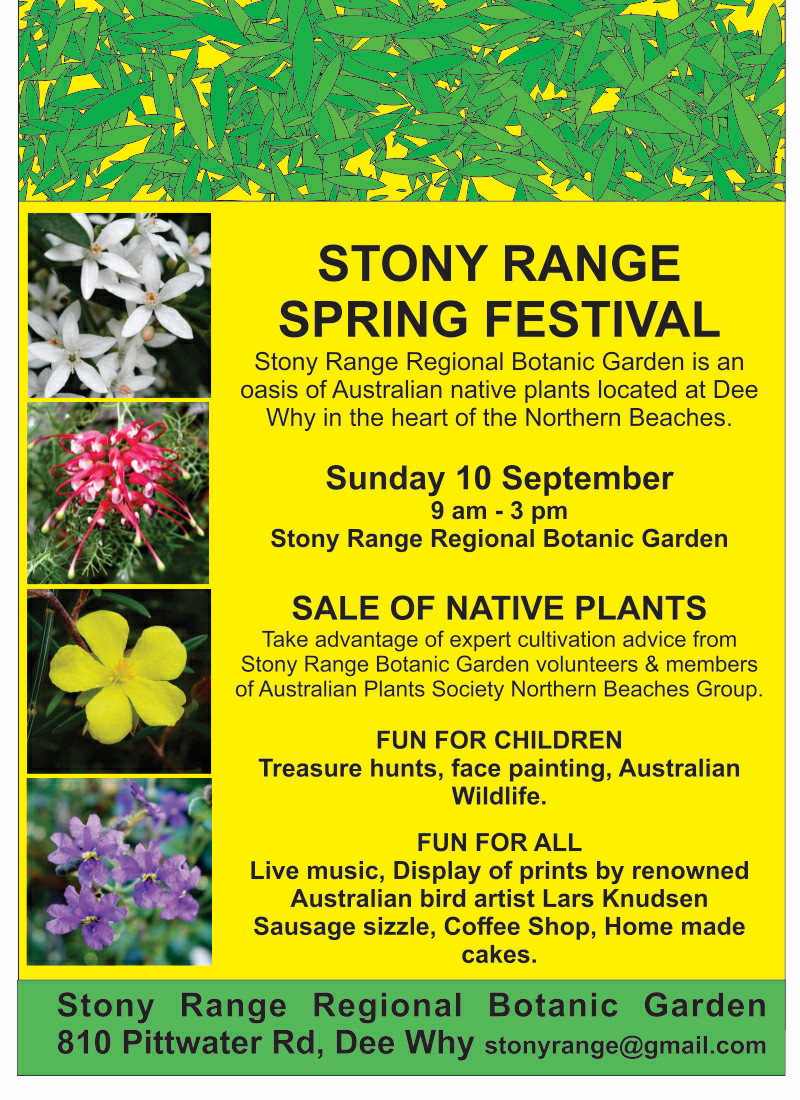
Bushcare Training Day At North Narrabeen
- Weed identification and best practice removal techniques
- Native plant identification and weed species including lookalikes
- Hands-on weed removal
- Bring along your unknown plant species for identification
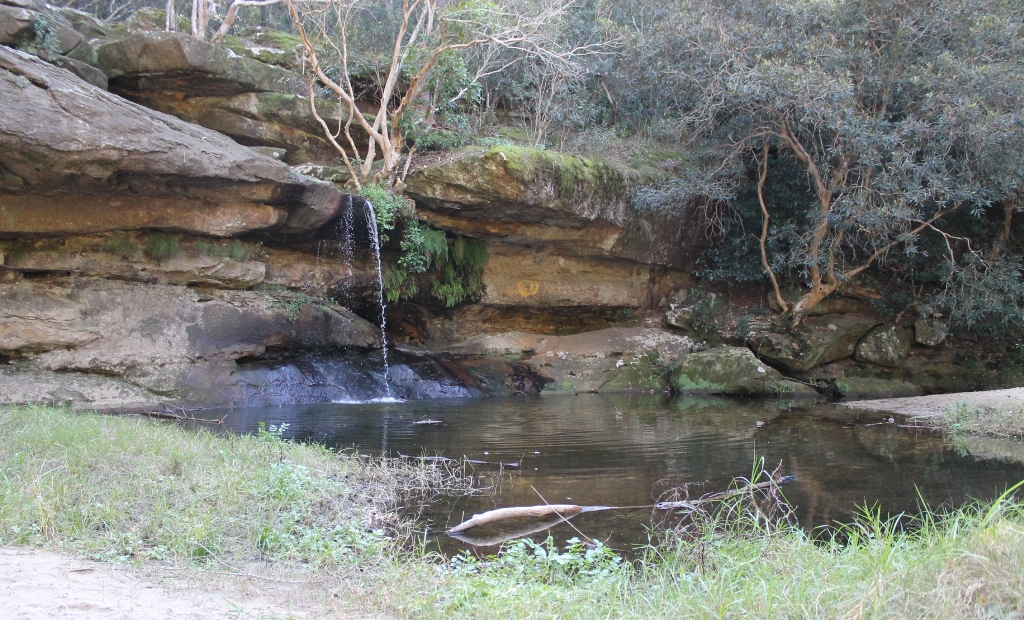
Get Ready Weekend 2023: Know Your Risk This Bush Fire Season

Northern Beaches Clean Up Crew: Newport Beach Clean Up - Sunday September 24
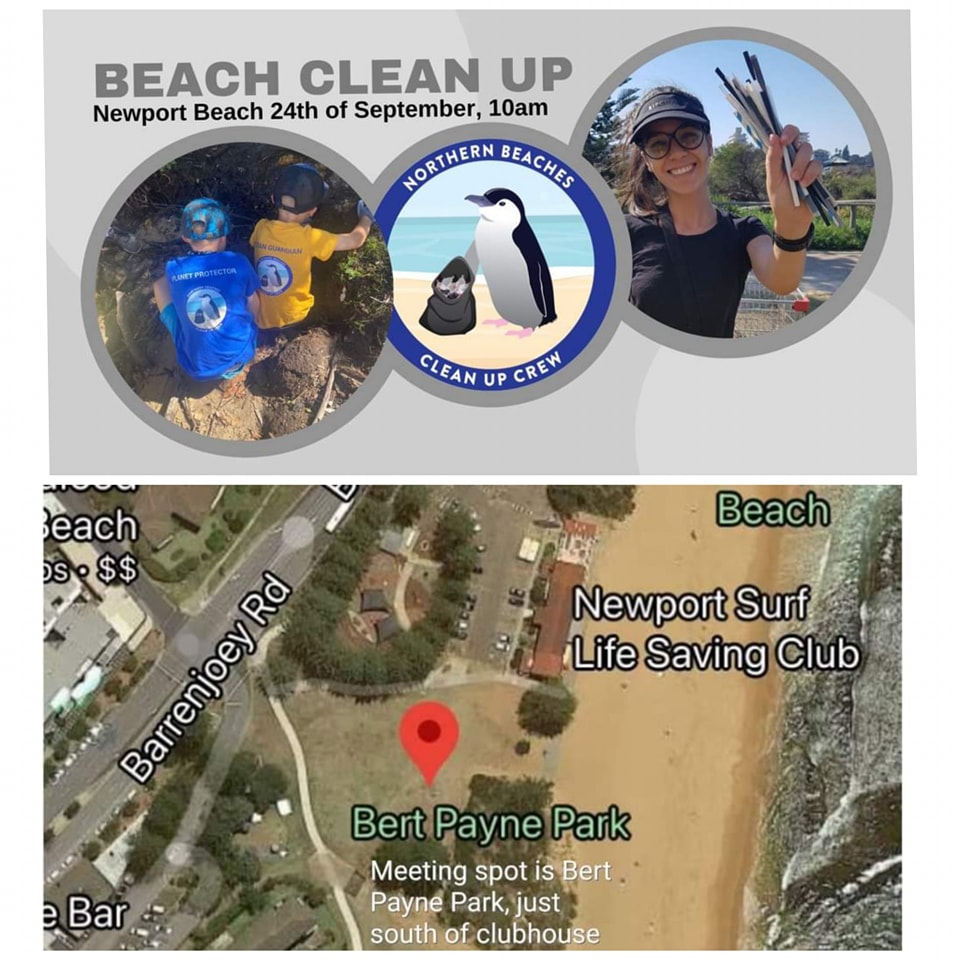
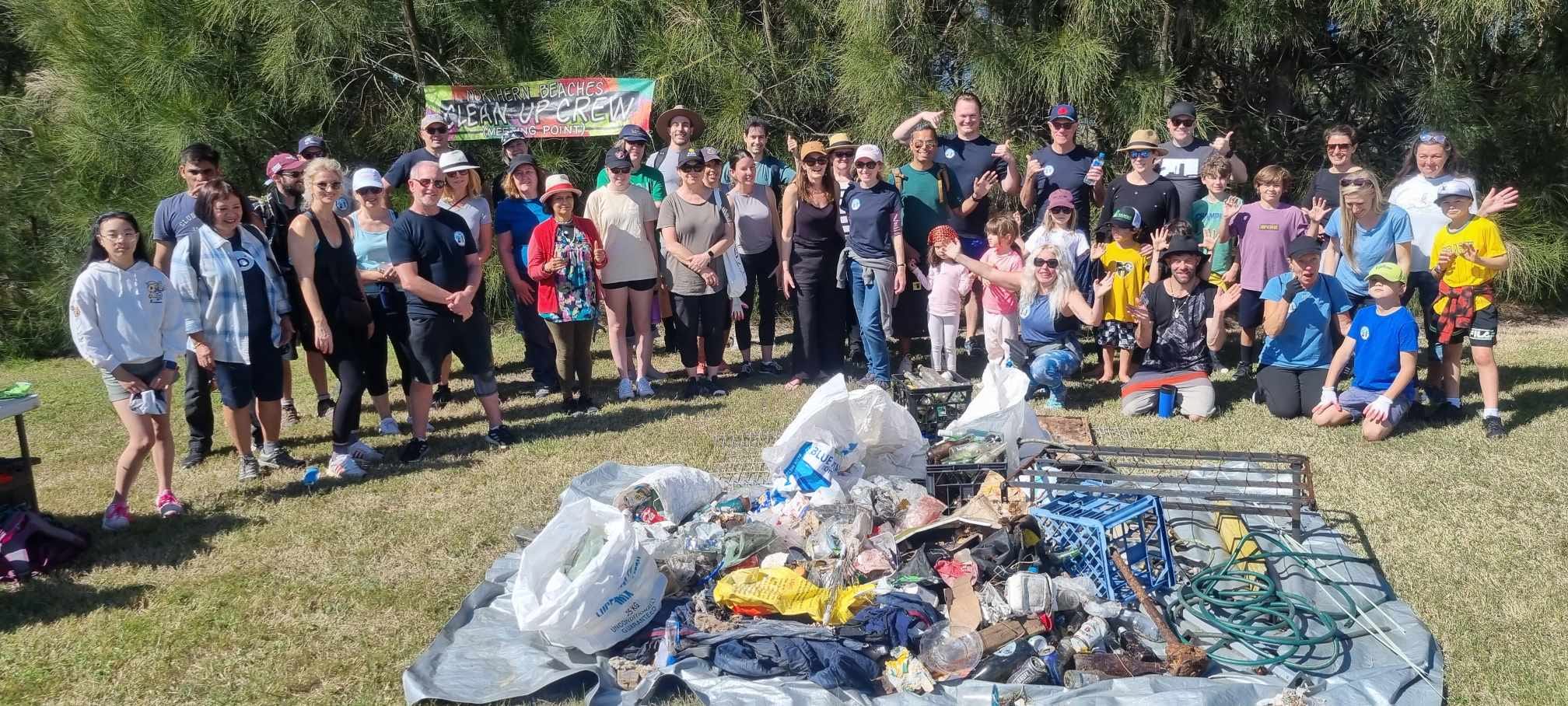

Palmgrove Park Avalon: New Bushcare Group Begins
 Palmgrove Park Avalon is a remnant of the Spotted Gum forest that was once widespread on the lower slopes of the Pittwater peninsula. This bushland’s official name and forest type is Pittwater and Wagstaffe Endangered Ecological Community, endangered because so much has been cleared for suburban development. Canopy trees, smaller trees and shrubs, and ground layer plants make up this community. Though scattered remnant Spotted Gums remain on private land, there is little chance of seedlings surviving in gardens and lawns. More information HERE
Palmgrove Park Avalon is a remnant of the Spotted Gum forest that was once widespread on the lower slopes of the Pittwater peninsula. This bushland’s official name and forest type is Pittwater and Wagstaffe Endangered Ecological Community, endangered because so much has been cleared for suburban development. Canopy trees, smaller trees and shrubs, and ground layer plants make up this community. Though scattered remnant Spotted Gums remain on private land, there is little chance of seedlings surviving in gardens and lawns. More information HERE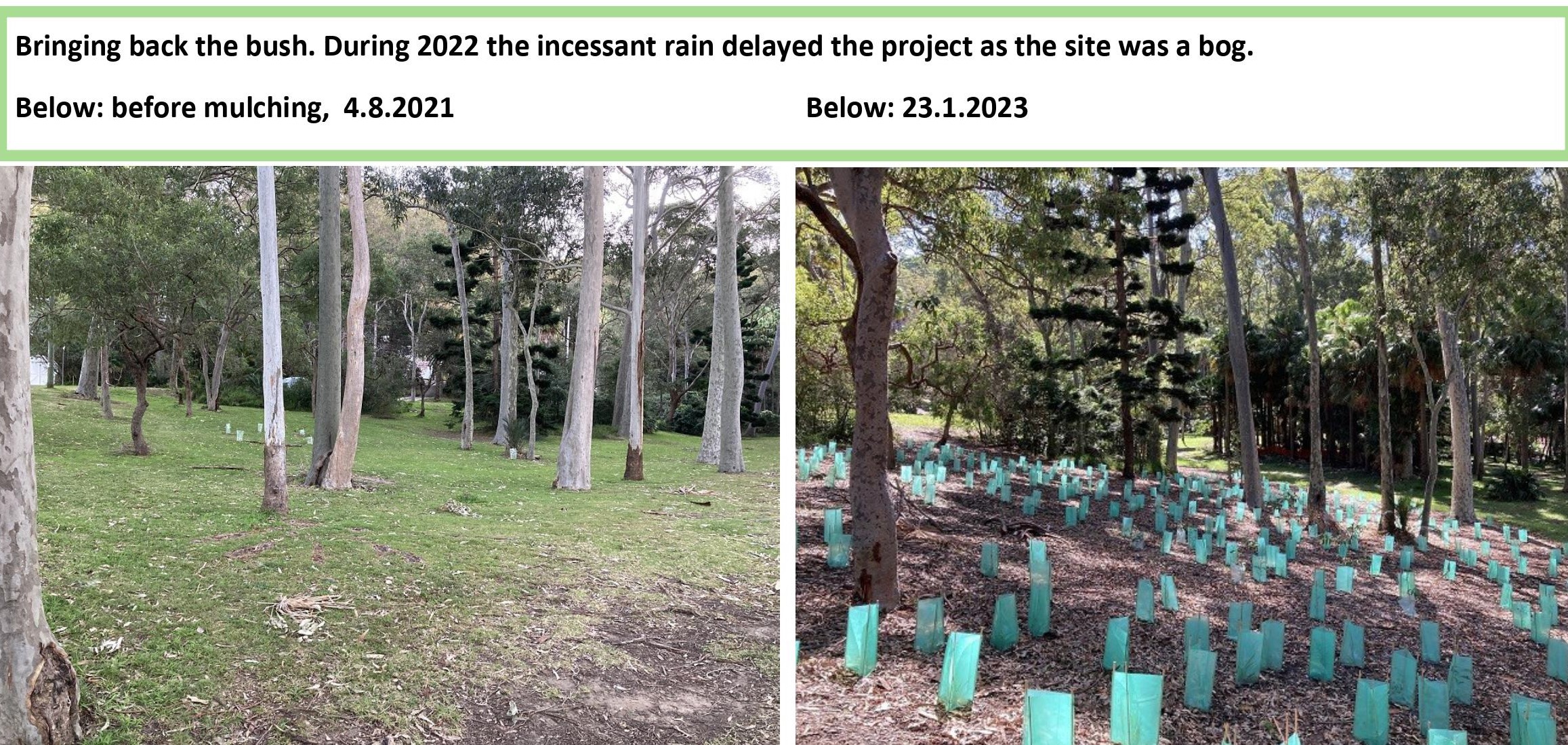
Avalon Dunes Bushcare Update: Next Session On October 1st
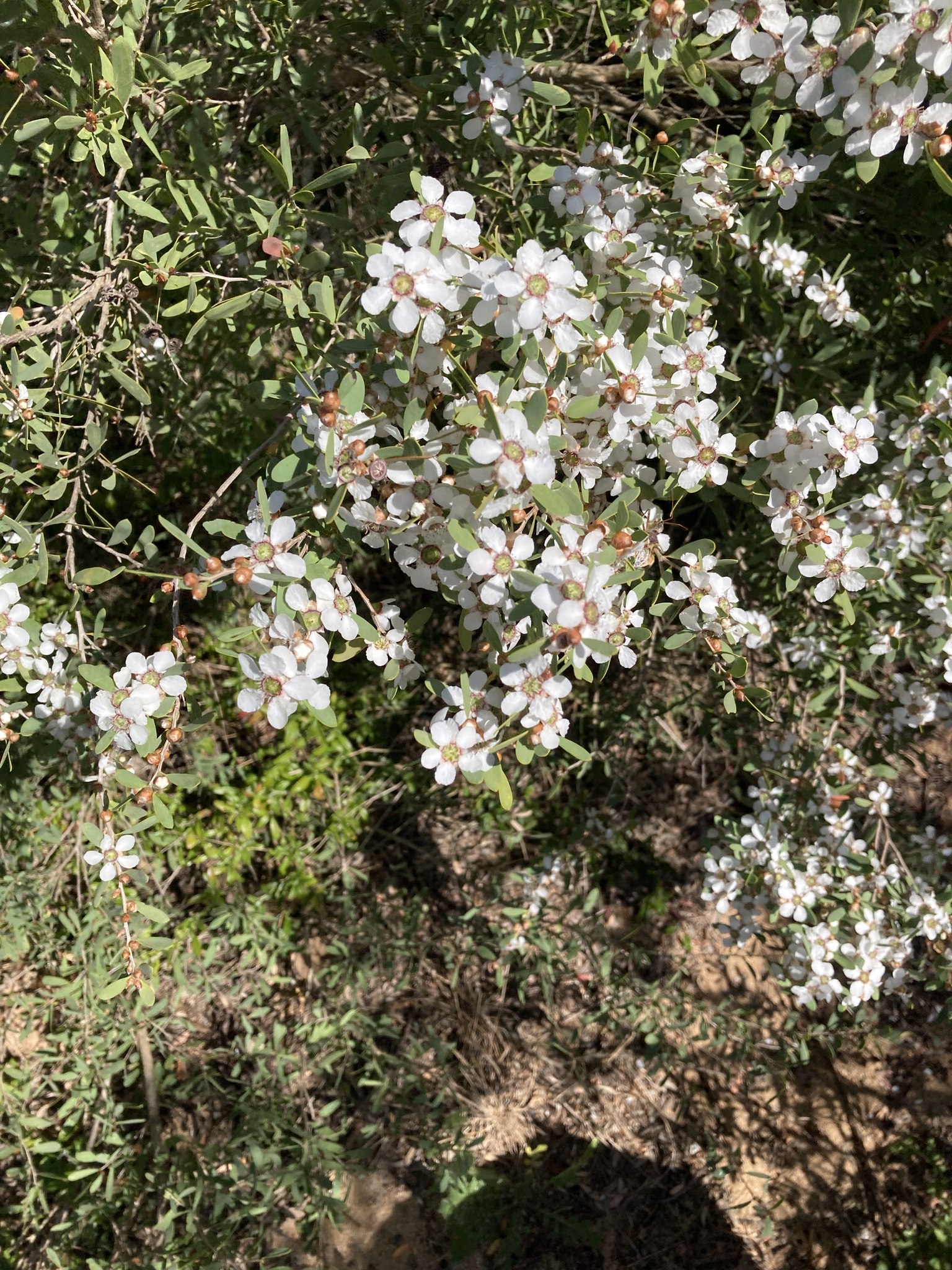
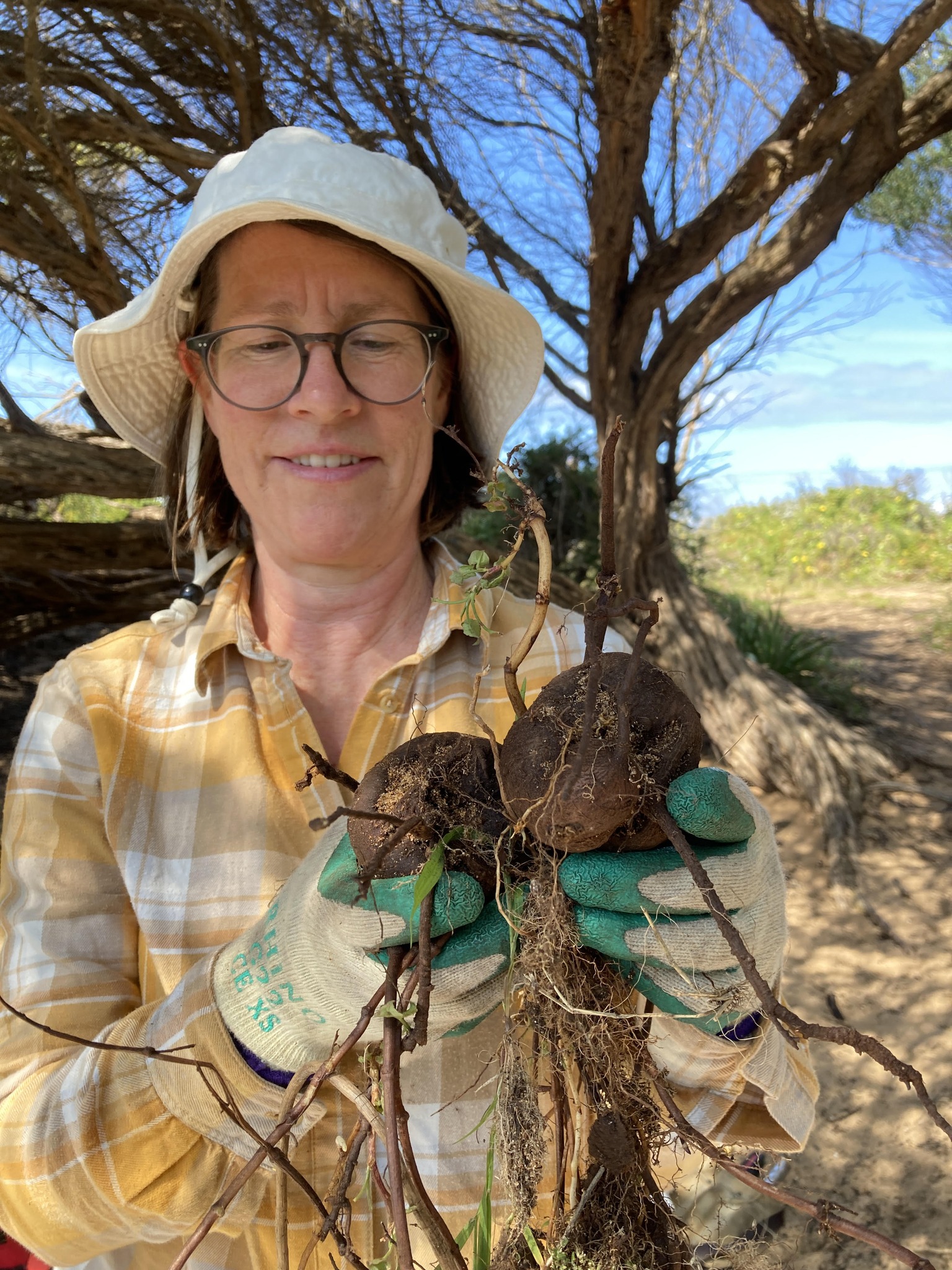

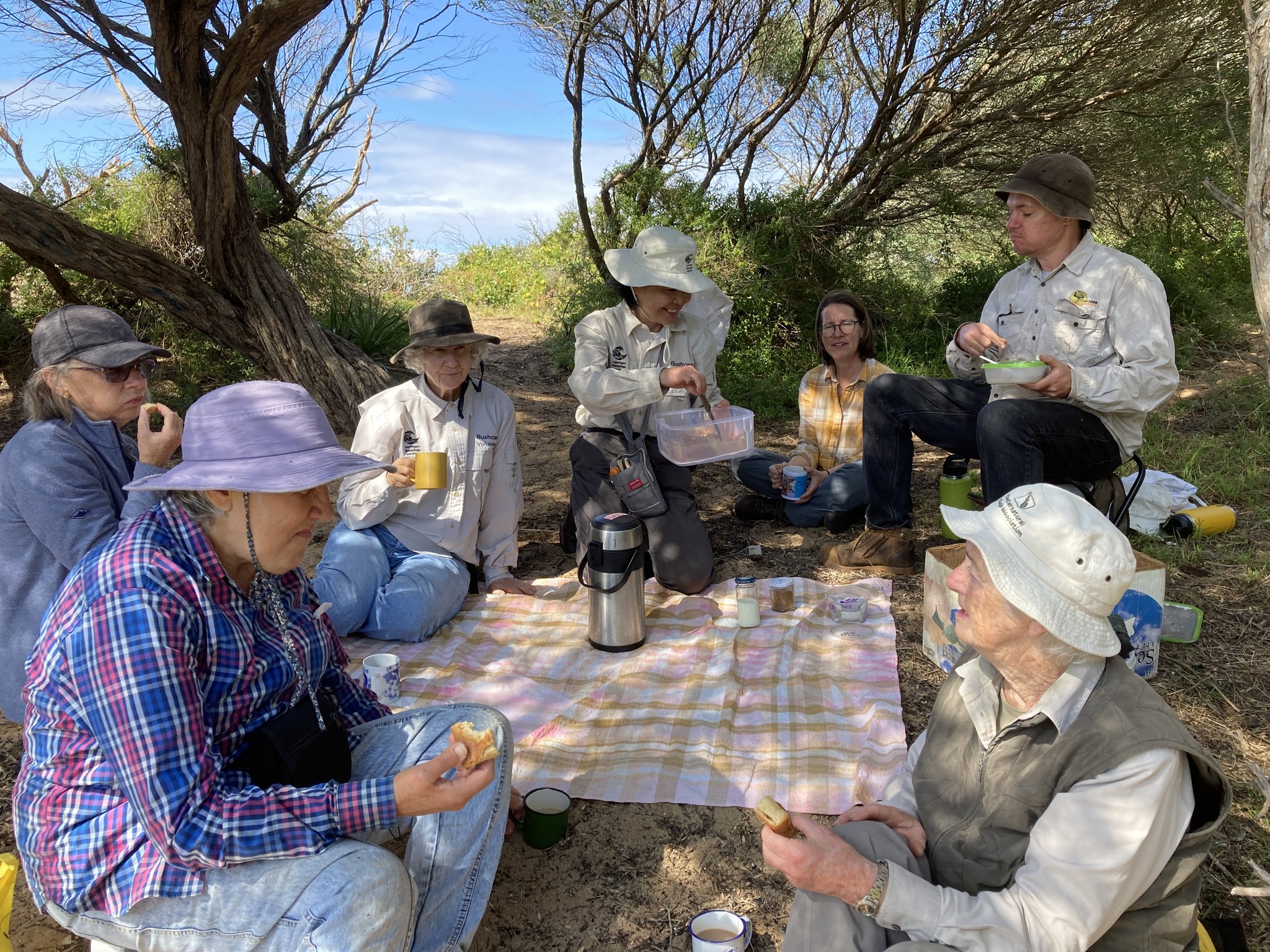
Tiny Carnivorous Critters: Researchers Discover Two New Aussie Mammals
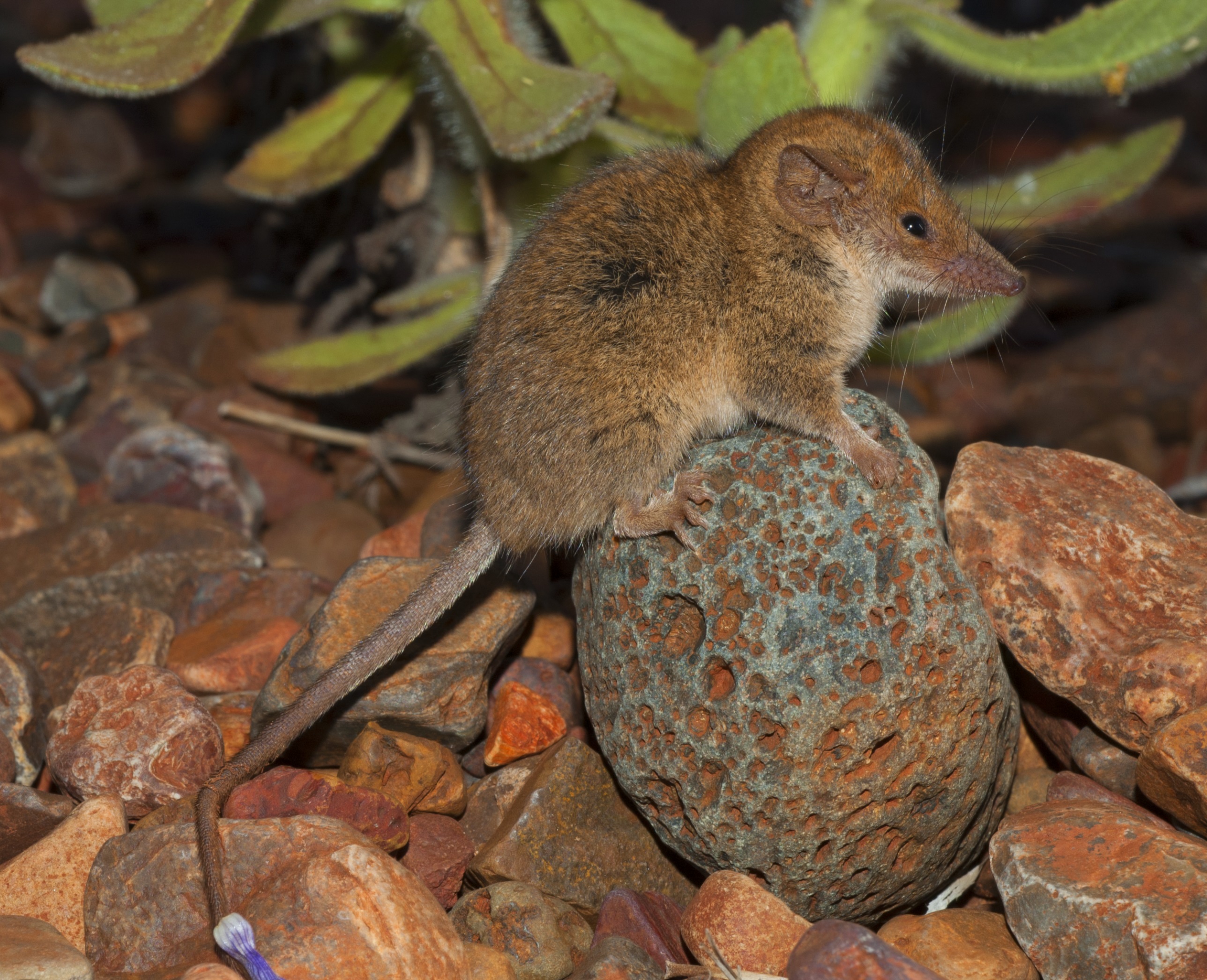
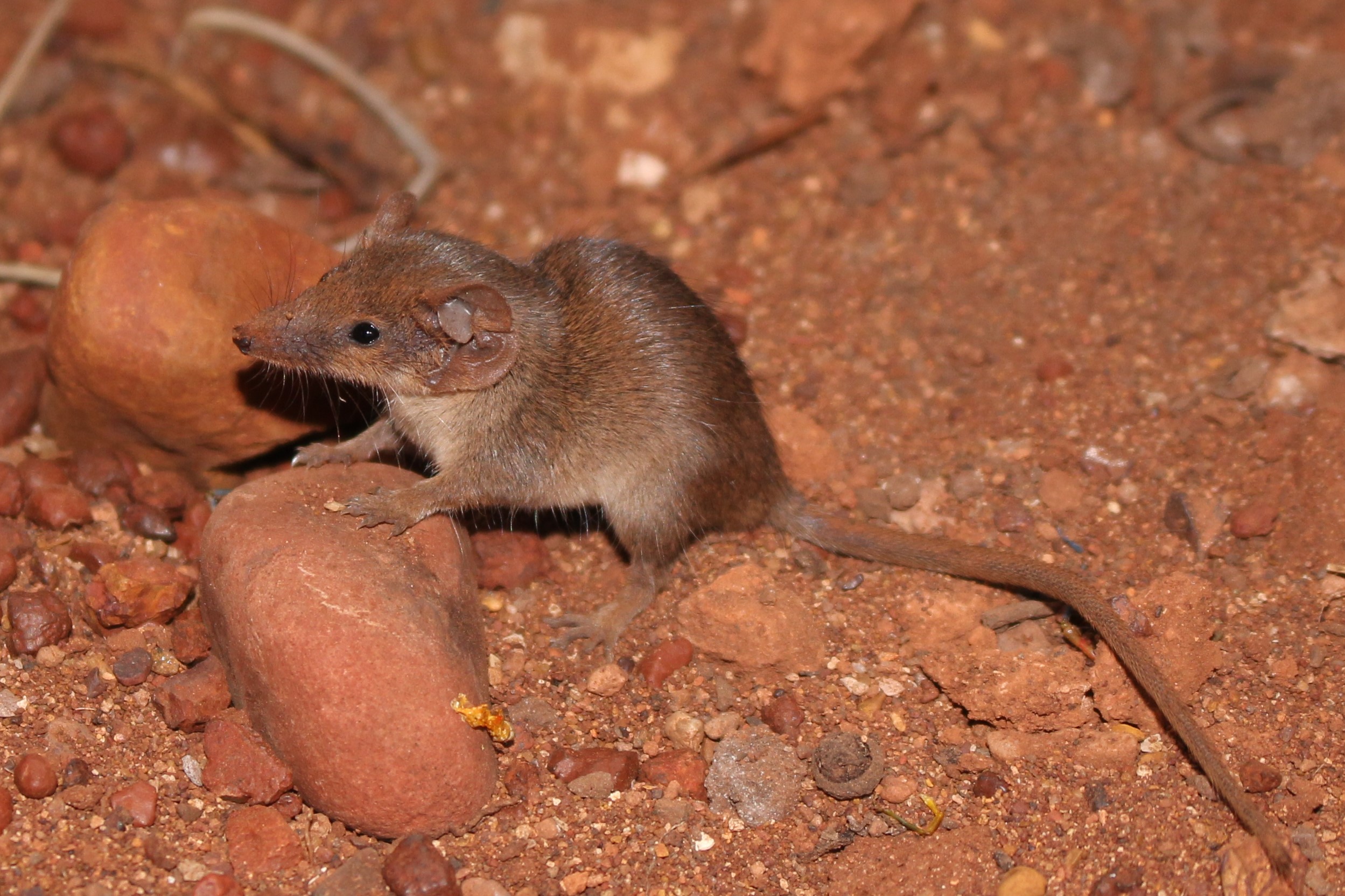
Seen Any Glossies Drinking Around Nambucca, Bellingen, Coffs Or Clarence? Want To Help?: Join The Glossy Squad
- a female bird (identifiable by yellow on her head) begging and/or being fed by a male (with plain black/brown head and body and unbarred red tail feathers)
- a lone adult male, or a male with a begging female, flying purposefully after drinking at the end of the day.

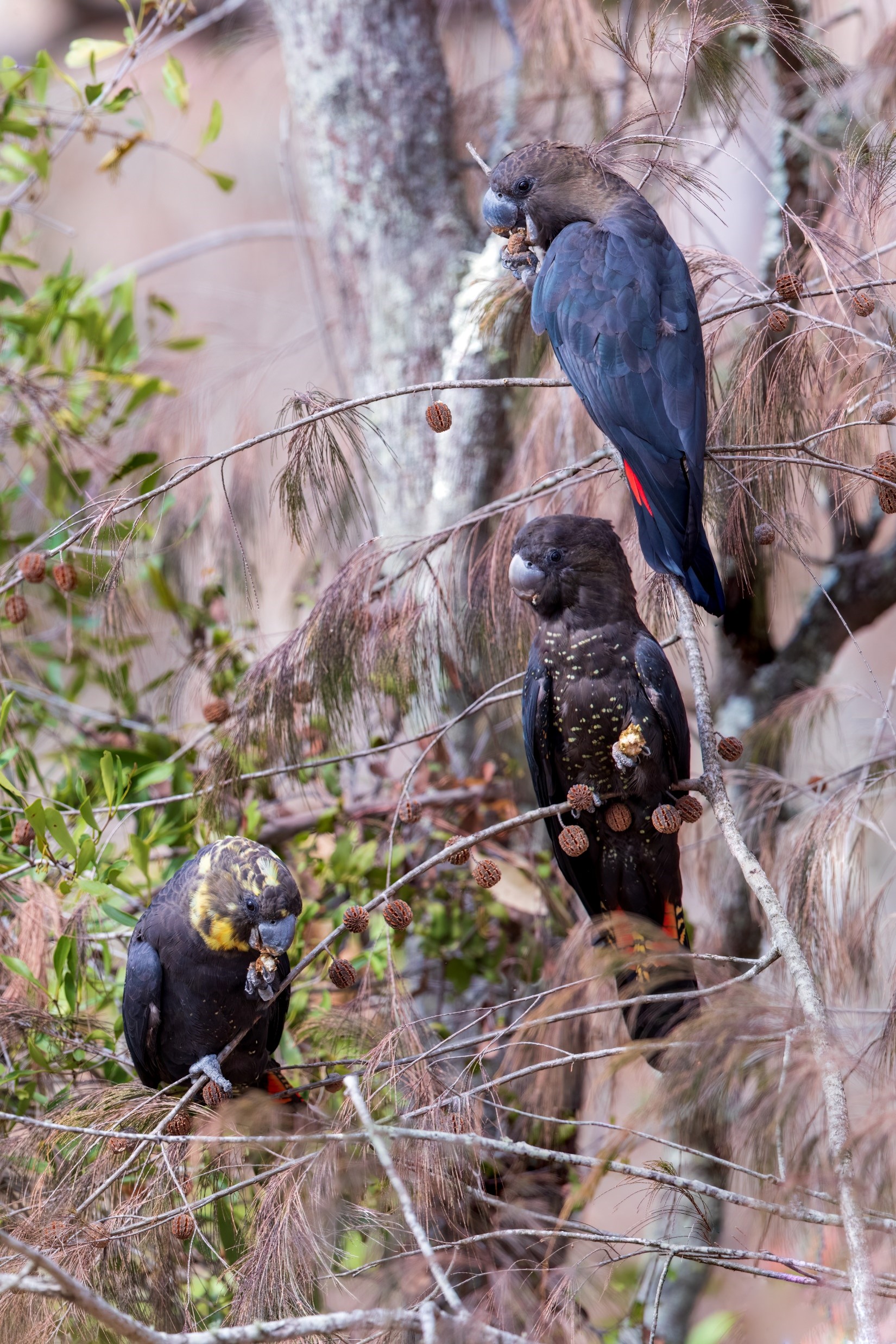
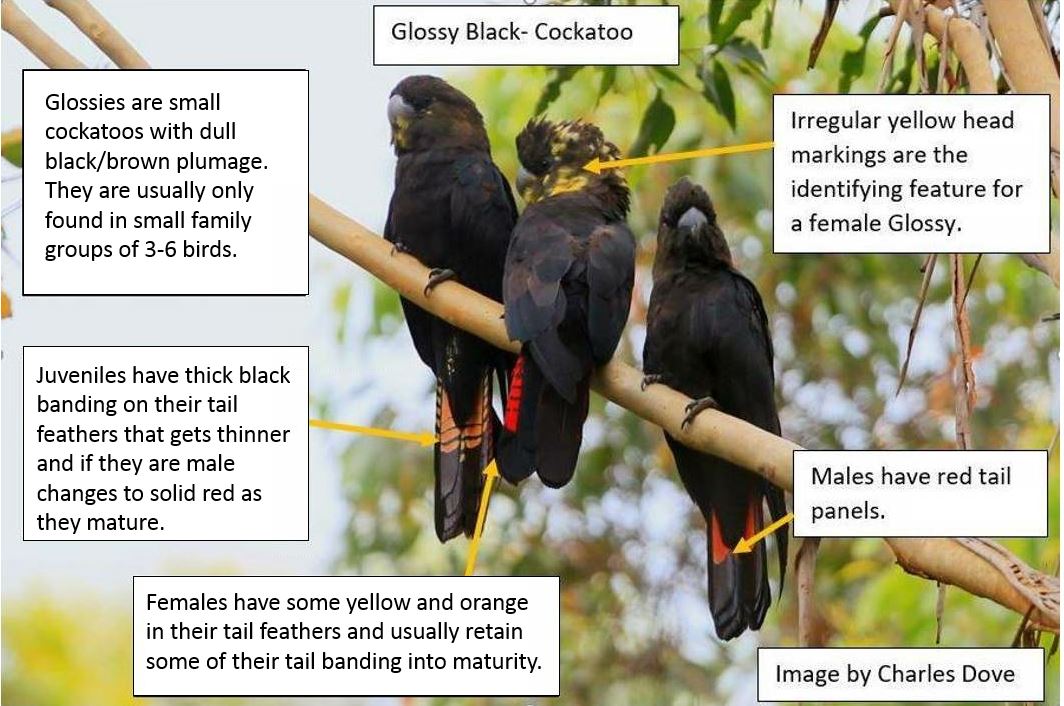
Statement From President Joe Biden On Protecting Arctic Lands And Wildlife In Alaska
$850,000 In Funding Open To Improve Fish Habitat
- removal or modification of barriers to fish passage
- rehabilitation of riparian lands (riverbanks, wetlands, mangrove forests, saltmarsh)
- re-snagging waterways with timber structure
- the removal of exotic vegetation from waterways and replacement with native plants
- bank stabilisation works
- fencing to exclude livestock.
Blue Mountains National Park And Kanangra-Boyd National Park Draft Plan Of Management: Public Consultation
- improving recognition of the parks significant values, including World and National Heritage values, and providing for adaptive management to protect the values
- recognising and supporting the continuation of partnerships with Aboriginal communities
- providing outstanding nature-based experiences for visitors through improvements to visitor facilities - including:
- Opportunities for supported or serviced camping, where tents and services are provided by commercial tour operators, may be offered at some camping areas in the parks
- Jamison Creek, Jamison Valley Walk-in camping Potential new camping
- Leura Amphitheatre Jamison Valley Walk-in camping Potential new camping
- Mount Solitary Jamison Valley Walk-in camping Potential new camping
- Maxwell’s HuC Kedumba Valley Cabin/hut Potential new accommodation
- Kedumba Valley Maxwell’s Hut (historic slab hut) - Building restoration in progress; potential new Accommodation for bushwalkers
- Government Town Police station; courthouse - Potential new Visitor accommodation
- write clearly and be specific about the issues that are of concern to you
- note which part or section of the document your comments relate to
- give reasoning in support of your points - this makes it easier for us to consider your ideas and will help avoid misinterpretation
- tell us specifically what you agree/disagree with and why you agree or disagree
- suggest solutions or alternatives to managing the issue if you can.
Areas Closed For West Head Lookout Upgrades
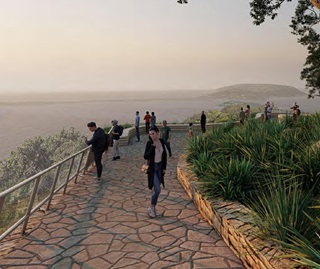 NPWS advise that the following areas are closed from Monday 22 May to Thursday 30 November 2023 while West Head lookout upgrades are underway:
NPWS advise that the following areas are closed from Monday 22 May to Thursday 30 November 2023 while West Head lookout upgrades are underway:
- West Head lookout
- The loop section of West Head Road
- West Head Army track.
Vehicles, cyclists and pedestrians will have access to the Resolute picnic area and public toilets. Access is restricted past this point.
The following walking tracks remain open:
- Red Hands track
- Aboriginal Heritage track
- Resolute track, including access to Resolute Beach and West Head Beach
- Mackeral Beach track
- Koolewong track.
The West Head lookout cannot be accessed from any of these tracks.
Image: Visualisation of upcoming works, looking east from the ramp towards Barrenjoey Head Credit: DPE
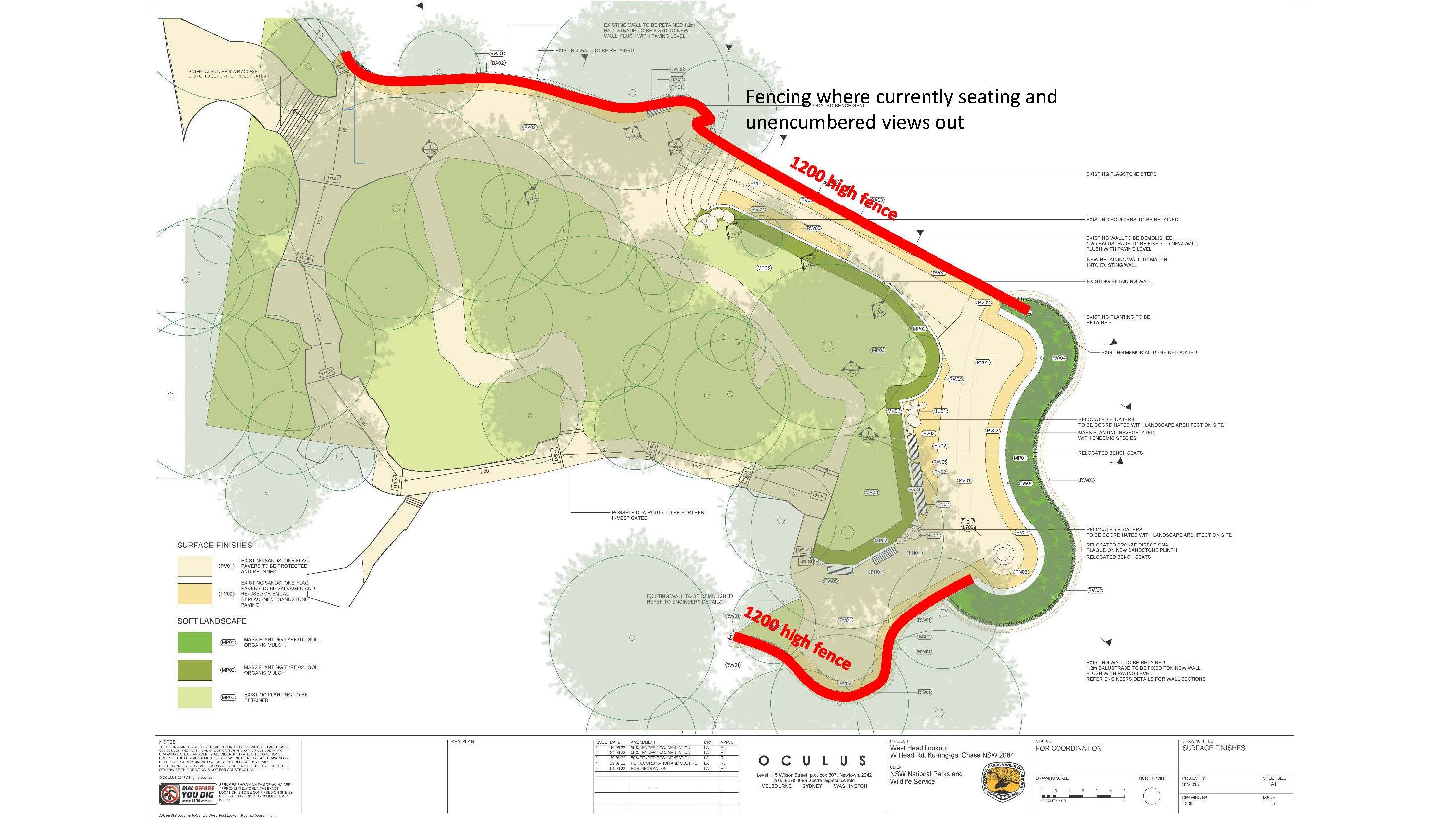
PNHA Guided Nature Walks 2023
Our walks are gentle strolls, enjoying and learning about the bush rather than aiming for destinations. Wear enclosed shoes. We welcome interested children over about 8 years old with carers. All Welcome.
So we know you’re coming please book by emailing: pnhainfo@gmail.com and include your phone number so we can contact you if weather is doubtful.
The whole PNHA 2023 Guided Nature Walks Program is available at: http://pnha.org.au/test-walks-and-talks/
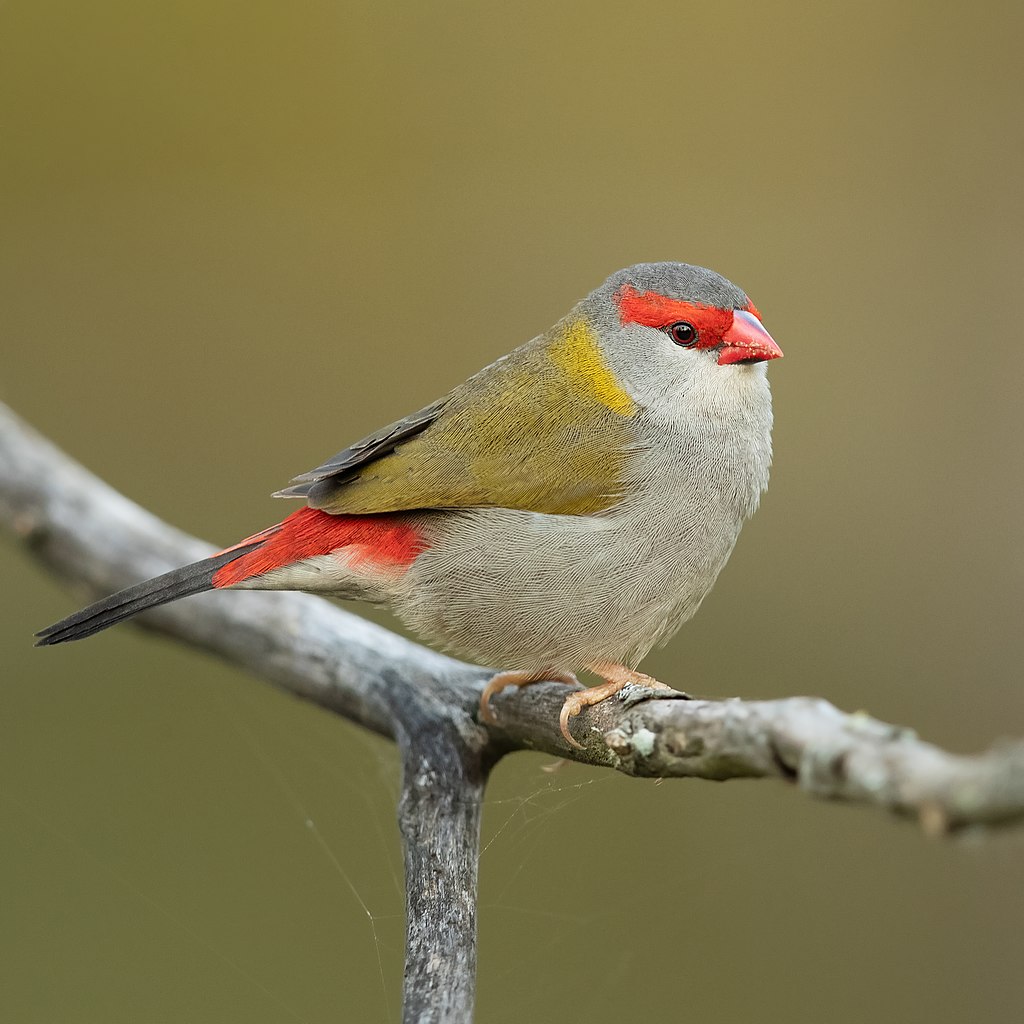
Red-browed finch (Neochmia temporalis). Photo: J J Harrison
Report Fox Sightings
%20(1).jpg?timestamp=1675893929686)
Marine Wildlife Rescue Group On The Central Coast
A new wildlife group was launched on the Central Coast on Saturday, December 10, 2022.
Marine Wildlife Rescue Central Coast (MWRCC) had its official launch at The Entrance Boat Shed at 10am.
The group comprises current and former members of ASTR, ORRCA, Sea Shepherd, Greenpeace, WIRES and Wildlife ARC, as well as vets, academics, and people from all walks of life.
Well known marine wildlife advocate and activist Cathy Gilmore is spearheading the organisation.
“We believe that it is time the Central Coast looked after its own marine wildlife, and not be under the control or directed by groups that aren’t based locally,” Gilmore said.
“We have the local knowledge and are set up to respond and help injured animals more quickly.
“This also means that donations and money fundraised will go directly into helping our local marine creatures, and not get tied up elsewhere in the state.”
The organisation plans to have rehabilitation facilities and rescue kits placed in strategic locations around the region.
MWRCC will also be in touch with Indigenous groups to learn the traditional importance of the local marine environment and its inhabitants.
“We want to work with these groups and share knowledge between us,” Gilmore said.
“This is an opportunity to help save and protect our local marine wildlife, so if you have passion and commitment, then you are more than welcome to join us.”
Marine Wildlife Rescue Central Coast has a Facebook page where you may contact members. Visit: https://www.facebook.com/profile.php?id=100076317431064
- Ph: 0478 439 965
- Email: marinewildlifecc@gmail.com
- Instagram: marinewildliferescuecc
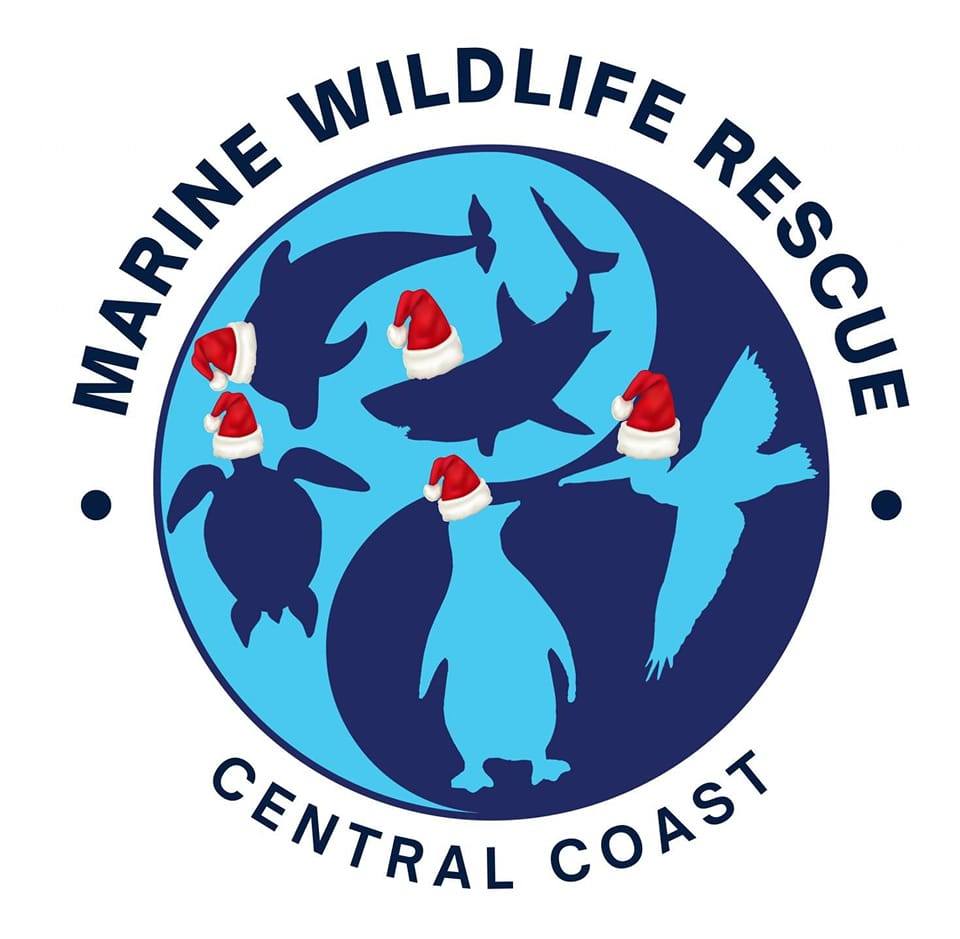
Watch Out - Shorebirds About
.JPG.opt1460x973o0,0s1460x973.jpg?timestamp=1663629195339)
Possums In Your Roof?: Do The Right Thing
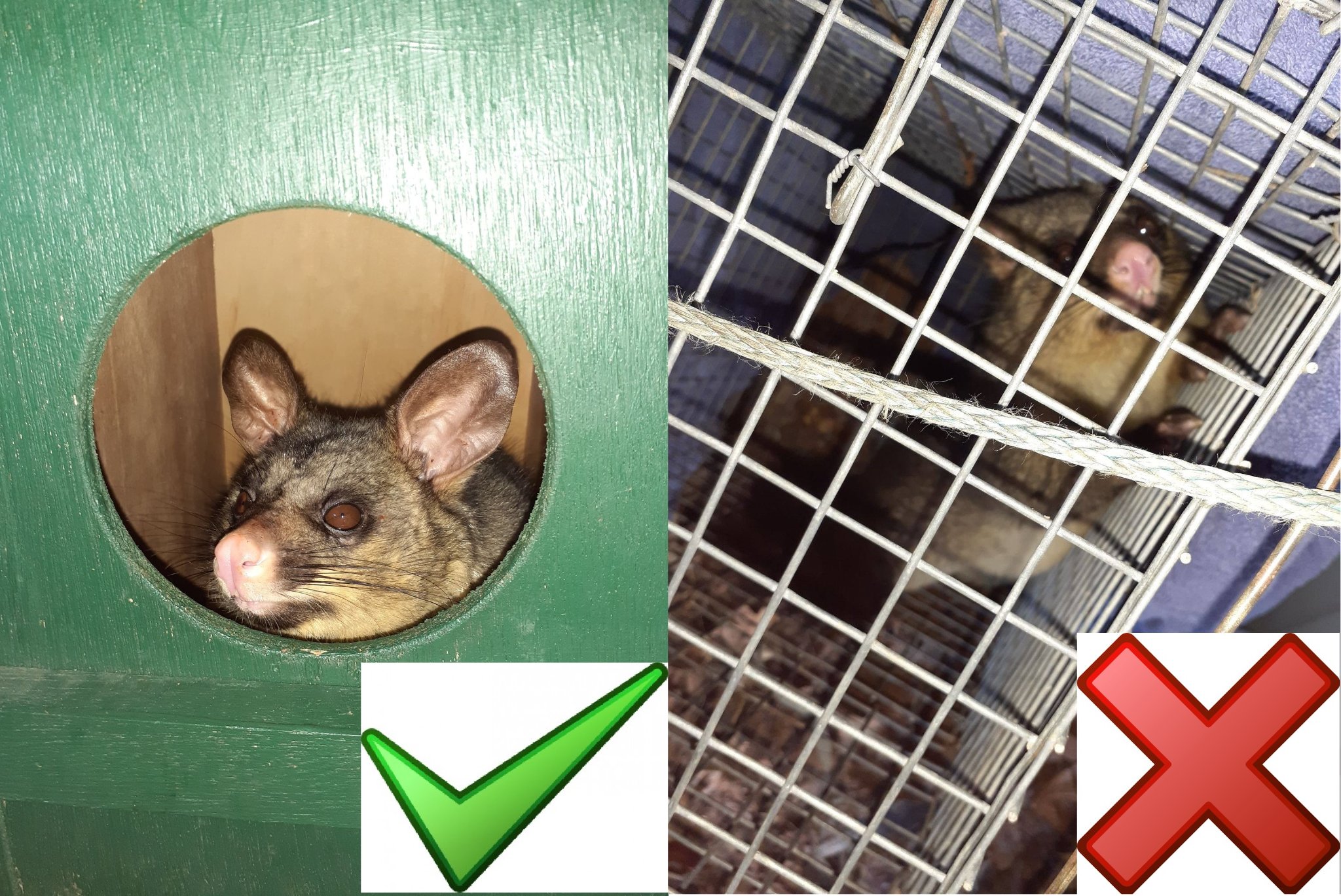
Aviaries + Possum Release Sites Needed

Bushcare In Pittwater
Where we work Which day What time
Avalon
Angophora Reserve 3rd Sunday 8:30 - 11:30am
Avalon Dunes 1st Sunday 8:30 - 11:30am
Avalon Golf Course 2nd Wednesday 3 - 5:30pm
Careel Creek 4th Saturday 8:30 - 11:30am
Toongari Reserve 3rd Saturday 9 - 12noon (8 - 11am in summer)
Bangalley Headland 2nd Sunday 9 to 12noon
Bayview
Winnererremy Bay 4th Sunday 9 to 12noon
Bilgola
North Bilgola Beach 3rd Monday 9 - 12noon
Algona Reserve 1st Saturday 9 - 12noon
Plateau Park 1st Friday 8:30 - 11:30am
Church Point
Browns Bay Reserve 1st Tuesday 9 - 12noon
McCarrs Creek Reserve Contact Bushcare Officer To be confirmed
Clareville
Old Wharf Reserve 3rd Saturday 8 - 11am
Elanora
Kundibah Reserve 4th Sunday 8:30 - 11:30am
 Mona Vale
Mona Vale Mona Vale Beach Basin 1st Saturday 8 - 11am
Mona Vale Dunes 2nd Saturday +3rd Thursday 8:30 - 11:30am
Newport
Bungan Beach 4th Sunday 9 - 12noon
Crescent Reserve 3rd Sunday 9 - 12noon
North Newport Beach 4th Saturday 8:30 - 11:30am
Porter Reserve 2nd Saturday 8 - 11am
North Narrabeen
Irrawong Reserve 2nd Saturday 2 - 5pm
Palm Beach
North Palm Beach Dunes 3rd Saturday 9 - 12noon
Scotland Island
Catherine Park 2nd Sunday 10 - 12:30pm
Elizabeth Park 1st Saturday 9 - 12noon
Pathilda Reserve 3rd Saturday 9 - 12noon
Warriewood
Warriewood Wetlands 1st Sunday 8:30 - 11:30am
Whale Beach
Norma Park 1st Friday 9 - 12noon
Western Foreshores
Coopers Point, Elvina Bay 2nd Sunday 10 - 1pm
Rocky Point, Elvina Bay 1st Monday 9 - 12noon
Friends Of Narrabeen Lagoon Catchment Activities

Gardens And Environment Groups And Organisations In Pittwater
Are Murray-Darling Basin Rivers Getting The Water They Need To Stay Healthy?: Only 31% Of Sites Have Achieved Targets Needed To Keep Them Alive - The Rest Are In Decline
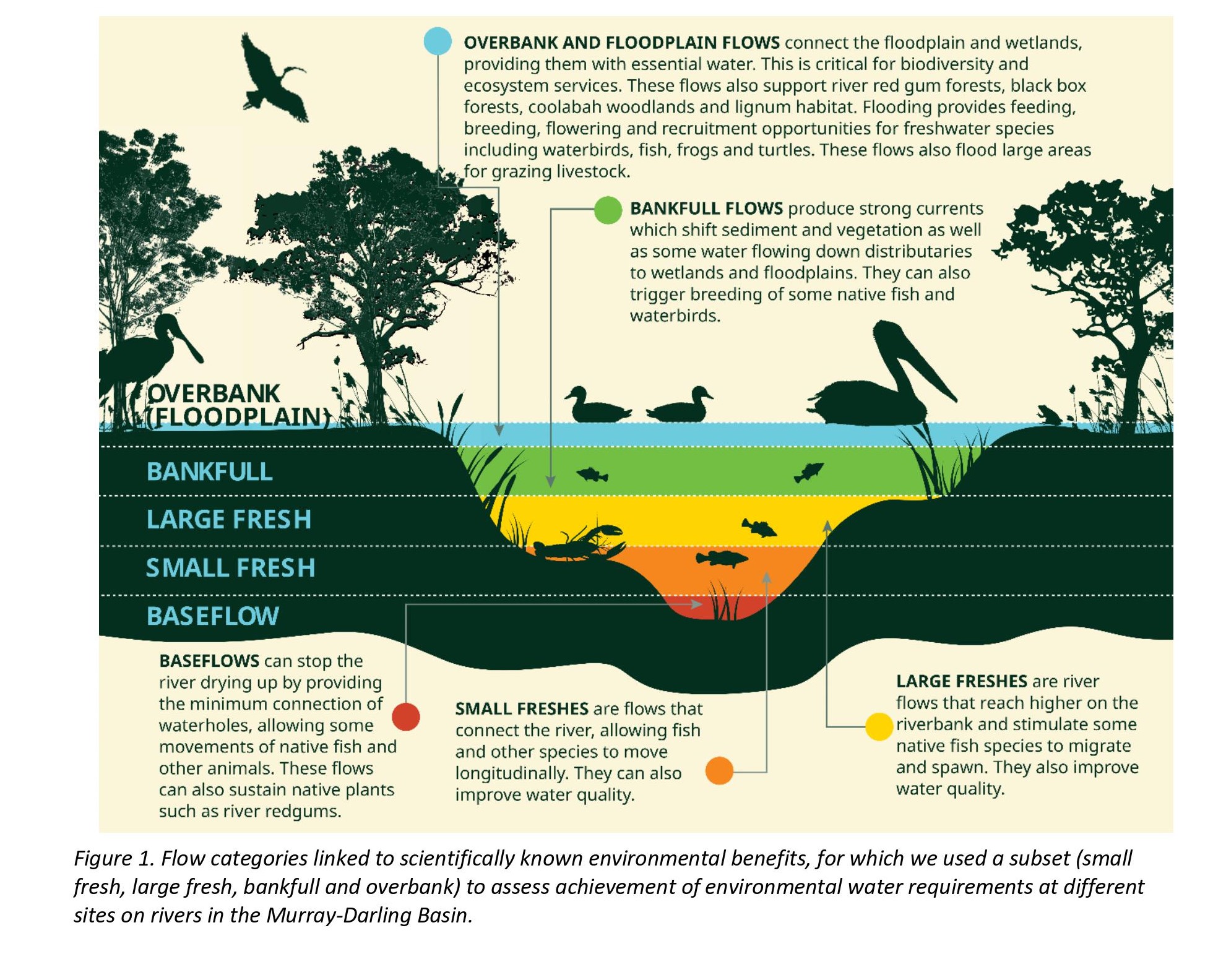
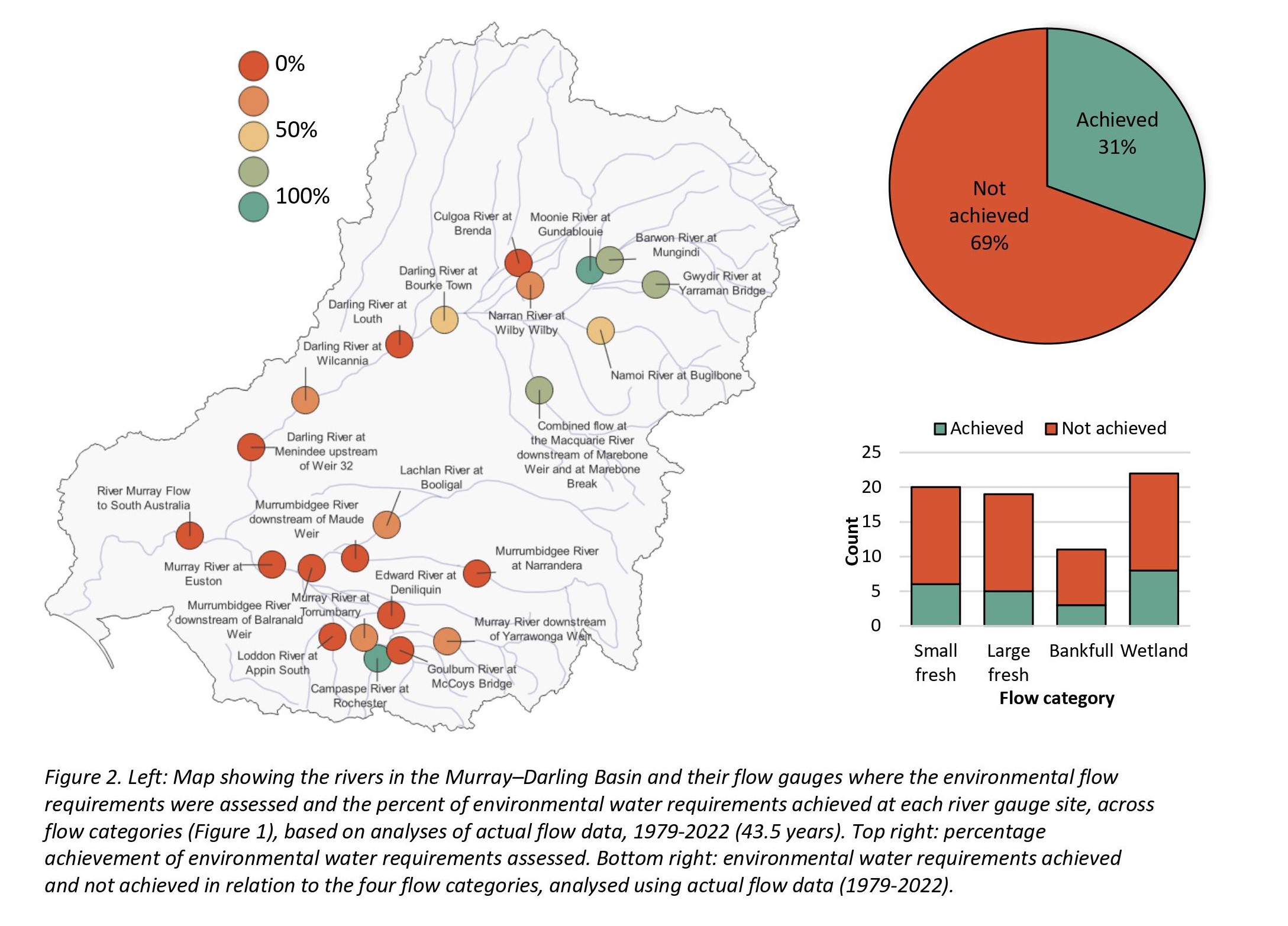
- Clean water for drinking and for growing food and fibre, with flows that flush salt, sediment and excess nutrients out of the Basin;
- Economic benefits from recreation, fishing, tourism, agriculture and education;
- Cultural and economic benefits for Aboriginal Nations;
- Reduced risk of algal blooms, hypoxic blackwater events, acidification, salinisation and erosion, which pose significant health risks and impact farming, fishing and tourism;
- Improved soil fertility and enhanced pastures in grazing landscapes as a result of the natural wetting cycles of floodplains;
- Improved water security for farmers during dry periods, improved capacity of wetlands to buffer floods and refuge for animals during droughts;
- Resilience to climate extremes with greater capacity to adapt to a changing climate in the future; and
- Habitat, food, migration pathways and breeding opportunities for native fish, waterbirds and other native wildlife that rely on water in the Basin, some of which are nationally threated and/or recognised by international agreements.
1) Deliver outstanding components of the Basin Plan, including:
a. recover 3,200 GL of environmental water or equivalent outcomes, including 450 GL agreed under the Basin Plan, and support communities through this transition.b. remove physical and operational constraints to allow for overbank watering of floodplain wetlands.
2) Link flow requirements to water management decisions, by:
a. regularly re-evaluating the environmentally sustainable level of take to ensure it is capable of achieving flow requirements under projected climate scenarios.b. Requiring flow targets to be achieved before major upstream extractions can take place.
3) Ensure a transparent, scientifically robust evidence base for implementing flow requirements, by:
a. publishing a dashboard showing real-time achievement of water requirements over a range of timescales, based on gauge data as well as hydrological models;b. fast-tracking programs to define cultural water requirements and water for essential human needs, and return water to Aboriginal Nations of the Basin to support these requirements; andc. accounting for both sides of the ledger (extractions and river flows) in water management and compliance by annually validating models using actual river flows and adjusting for model error.
Government Declares War On Feral Cats
Coal Royalties To Deliver Budget Repair; Fairer Return For NSW
- Two roundtables, attended by 13 mining companies.
- Seven individual meetings between the Treasurer, the Minister for Natural Resources and major mine operators.
- Twenty written submissions from representatives of the coal sector, including from coal mining companies and coal fired power generators.
- Detailed consultation with affected companies on price forecasts, currency assumptions, volume growth and cost curves. The Treasurer and the Minister for Finance then met with an industry delegation to discuss feedback.
- A roundtable with 4 major power companies, spanning the generation, distribution and retail sectors of the electricity industry.
- Two detailed consultations between NSW Treasury and the Consuls-General of Japan and Korea.
Further $1.8 Billion To Power NSW To A Clean Energy Future
Coal Mine Expansions To Drive Fugitive Fossil Fuel Emissions Into First Place In Sunshine State: Report
Environment Groups Welcome Progress On Murray-Darling Basin Plan, But Guarantees Needed To Ensure Real Water Reaches Rivers
Energy Market Operator Report Shows NSW Can Avoid Costly Eraring Bail-Out
10-year feral cat plan brings us a step closer to properly protecting endangered wildlife
Sarah Legge, Australian National University; Jaana Dielenberg, Charles Darwin University, and John Woinarski, Charles Darwin UniversityFederal Environment Minister Tanya Plibersek has released a draft feral cat management plan.
Its aim is to reduce the devastating impact of cats on Australian wildlife, with a focus on protecting the most at-risk species from extinction.
Cats kill over 6 million native animals in Australia each day, and are challenging to manage.
The plan released for public consultation has a ten-year horizon with an estimated cost of A$60 million in the first five years. It could be a major step towards achieving Australia’s global commitments to end extinctions.
Why Manage Cats?
Unless we control the impact of cats, many native wildlife populations will continue to decline. Some will be driven to extinction, a sad and irreversible outcome for future generations and the ecosystems these species are part of.
Cats are versatile and highly effective predators. A large male cat can kill animals up to about 4kg – nearly as big as the cat itself.
Since they arrived in Australia with Europeans, cats have spread across 99% of the country. Only some islands and specially constructed fenced conservation areas are cat-free.
Many native animal populations can’t cope with sustained hunting pressure from cats. Impacted species include more than 200 of Australia’s nationally listed threatened species and 37 migratory species.
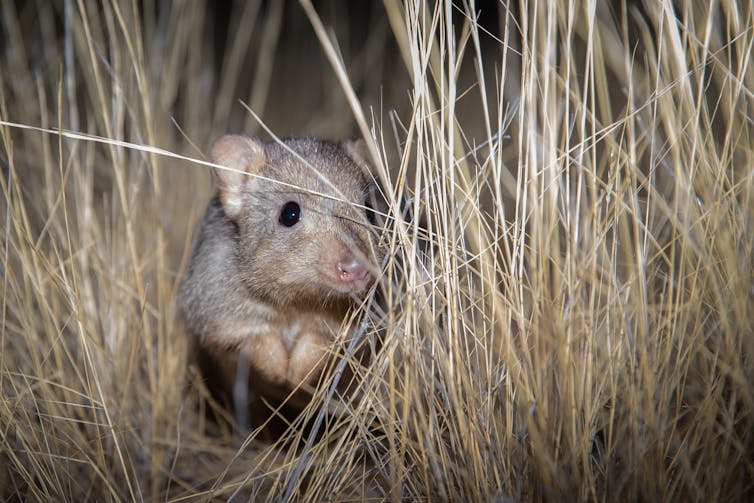
One in ten of the mammal species present when cats arrived are now extinct. Cats played a major role in most of those 34 extinctions. And they continue to drive population declines and regional extinctions of susceptible species.
Cats also carry and spread a range of diseases. One of these, toxoplasmosis, can cause sickness, behavioural impairment and death in other mammals and birds. This disease, which is entirely dependent on cats, can also have serious consequences for livestock and human health.
A Strategic Response
The government’s new Threat Abatement Plan aims to co-ordinate national efforts to reduce the impacts of feral cats on native wildlife. It follows extensive consultation with Indigenous ranger groups and First Nations organisations around the country, with members of the national Feral Cat Taskforce, and with threatened species and cat management experts.
Since cats occur just about everywhere, affect so many species and are elusive and hard to control, the plan is strategic: it prioritises the places and species for which controlling cats will have the greatest benefits.
Some significant successes have been achieved over the past decade or so, and the plan builds on those.

What Are The Priorities?
The plan’s objective is to improve outcomes for threatened and cat-susceptible native species, including numbats, bettongs, bandicoots and island-nesting seabirds.
Building from recent successes, it includes priorities for eradicating cats from islands and from within fenced conservation areas, because cats cannot quickly recolonise these areas. These projects are critical for native species, such as stick-nest rats and mala (rufous hare-wallaby), that can’t persist even with a very low density of cats.
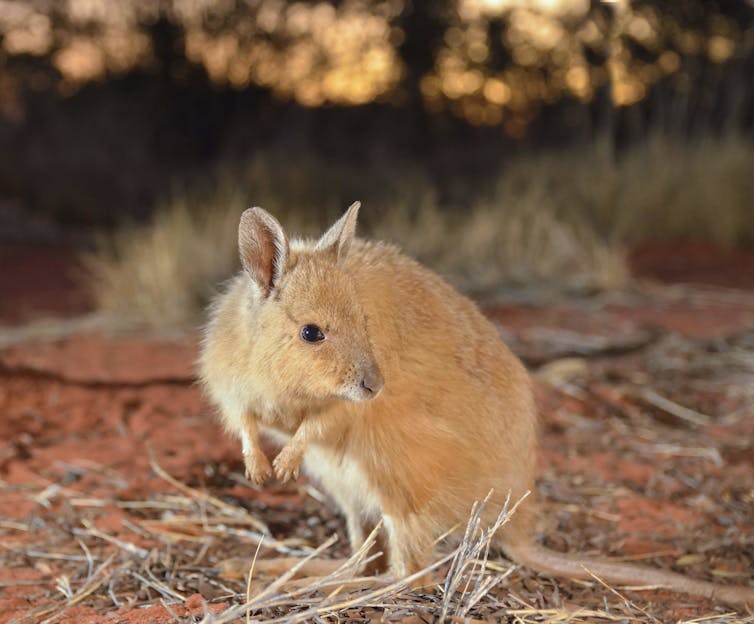
The plan also prioritises ongoing cat control in areas with important populations of threatened species that are highly vulnerable to cats, but which can persist as long as cat numbers are kept low.
This approach is valuable for species such as rock wallabies, which live in relatively small, well-defined areas, and for mammals of south-west Australia, which can be protected from cats and foxes by annual poison baiting.

Improving habitat management can also help reduce cat impacts across very large areas. For example, improving habitat in northern Australian tropical savannas, through better management of fire and livestock, can reduce cat impacts and increase native mammal populations. Cats hunt most efficiently in sparsely vegetated areas, so better cover provides more shelter for native wildlife.
In southern Australia, reducing rabbit populations also reduces cat numbers by removing an easy food source. This then relieves some of the predation pressure on native animals.

What Else Is In The Plan?
The plan proposes reforms of laws and regulations for pet and feral cats in all states and territories. For example, the plan includes actions to make laws on pet cat management more consistent across the country and to encourage responsible pet ownership. This means desexing cats and keeping cats contained so they can’t harm wildlife or produce kittens that end up as feral cats.

Many of Australia’s last strongholds for threatened species that are vulnerable to cats, such as great desert skinks, bilbies and night parrots, are in Indigenous Protected Areas and other Indigenous-managed land. The plan outlines practical support that Indigenous rangers want to help them manage cats.
Over the past few decades, we have learned much about the impacts of cats and how best to manage them. But we are still a long way from cost-effective, continent-scale solutions to protect native wildlife. The plan identifies the need for new applied research and the development and testing of effective control tools.
Who’s Responsible?
Success will depend on focusing and enhancing the already significant efforts of governments, Indigenous and non-Indigenous land managers, environmental non-government organisations, industry, community groups, researchers and the public.
The Australian government will help to deliver the plan by co-ordinating actions and making strategic investments in management and research activity.
Be Part Of The Solution
Every Australian who cares about our unique wildlife has an interest in cat management.
Cat owners can help by desexing their pet and keeping it indoors or in a cat run at all times.
Landowners can help by removing refuse that helps support feral cat colonies and by managing habitat so native animals can thrive.
And make sure your local, state and federal government members know how much you care about native wildlife.
The plan is available for public comment until December 11. Have a look, and have your say.![]()
Sarah Legge, Professor of Wildlife Ecology, Australian National University; Jaana Dielenberg, University Fellow, Charles Darwin University, and John Woinarski, Professor of Conservation Biology, Charles Darwin University
This article is republished from The Conversation under a Creative Commons license. Read the original article.
Whales stop singing and rock lobsters lose their balance: how seismic surveys can harm marine life
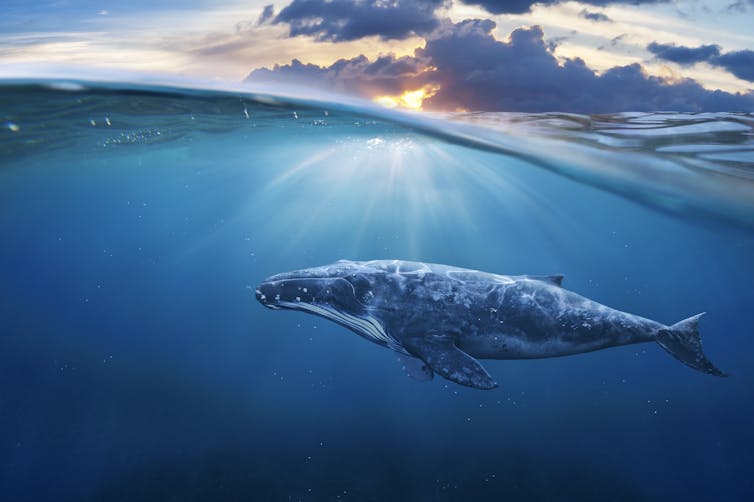
Woodside Energy this week announced it would start seismic testing for its Scarborough gas project off Australia’s west coast, before reversing the decision in the face of a legal challenge from Traditional Owners.
Seismic testing is highly controversial in marine environments. The federal regulator (the National Offshore Petroleum Safety and Environmental Management Authority) is currently examining a proposal for seismic testing in the Otway Basin in Bass Strait, which conservationists say has attracted more than 30,000 public submissions.
Seismic testing is also mooted as part of the “PEP11” (Petroleum Exploration Permit 11) off the coast of New South Wales, from Manly to Newcastle.
As marine biologists with research expertise in this field, here we give a roundup of the latest evidence on the effects of seismic surveys. It shows there are many potential harms to marine life, and many unanswered questions.
What Are Seismic Surveys?
Marine seismic surveys are used to search for oil and gas, places to stash greenhouse gases, and potential locations for wind farms.
The surveys use air guns to generate sound signals. These sound signals are intense (loud, at high decibel levels) and “impulsive” (sharp, like a balloon popping). In the open ocean, sound waves can be detected thousands of kilometres from the source.
The sound can penetrate more than ten kilometres into the earth beneath the seafloor. The way the signals reflect off different layers of the seabed can identify geological structures, including those that contain mineral deposits such as oil and gas. The sound signals bounce back to acoustic receivers (hydrophones) towed behind the survey vessel on cables known as streamers.
During a survey, sound signals are generated every four to ten seconds, 24 hours a day, seven days a week. Surveys can last for weeks or months, and cover thousands of square kilometres of ocean. The proposal to study the Otway Basin, for example, covers 45,000 square km.
Seismic Surveys And Marine Life
The ability to fully examine the effects of seismic surveys in mammals is limited, because invasive methods are not logistically possible or ethically acceptable.
But there is a long history of research on whales and dolphins, given their reliance on sound to communicate, find food and navigate.
Observations of marine mammals show intense sound signals such as those from seismic surveys can affect hearing ability, either temporarily or permanently, depending on the intensity, range and duration of exposure.
Noise pollution can mask communications, causing whales either to sing more loudly or to stop singing altogether, which can affect social structure and interaction. Seismic surveys can also alter the presence and abundance of marine mammal prey.
What About Fish?
Fish also show a range of responses to seismic testing. Some fish exhibit physical damage to hearing organs and signs of stress.
Fish behaviour may also change. Some leave regular feeding or breeding areas, which raises concerns over effects to fishing grounds or impacts on important prey species. It’s also uncertain whether the fish will be able to find suitable alternative habitats if they are displaced in the long term.
Others may “habituate” or become accustomed to exposure, raising the risk of more extensive damage by spending more time in the survey area.
Scallops, Lobsters And Plankton
Despite invertebrates making up around 92% of marine species, the impact of marine noise on these creatures has only recently been studied. This has shown a potential for harm.
In the valuable southern rock lobster fishery, off the coasts of Victoria, South Australia and Tasmania, seismic air gun exposure damaged the sensory organ that provides a sense of gravity and balance, similar to the human inner ear. Affected lobsters also had impaired ability to right themselves when placed upside down, a reflex that underpins important behaviours such as escaping predators.
Scallops showed more severe impacts, with up to four times higher death rates and a range of other sub-lethal effects including altered behaviour, impaired physiology and a disrupted immune system. As this animal already suffers high levels of mortality naturally and due to fishery activity, this extra pressure could be of considerable concern.
Invertebrates also make up a large proportion of the zooplankton community, a broad group of very small animals carried by ocean currents. They are food for a wide range of marine life, from other zooplankton to small fish and whales.
In the first experimental exposure to a seismic air gun, a large proportion of zooplankton died. Overall abundance decreased significantly, at distances up to 1.2km from the air gun.
Confirming this result, another recent study of zooplankton found exposure to seismic air guns 50 metres away resulted in increased mortality immediately after exposure. The plankton continued to die off or suffer impaired development for several days. These effects, particularly in the case of exposure that is repeated over the course of months within a single area, have the potential to severely impact the plankton populations that underpin marine food webs.
Difficulties In Predicting Impacts
While the handful of available studies shows exposure to seismic surveys can harm animals, our ability to understand or predict what happens in the wild is still very limited.
Part of the problem is conflicting results. For example, in one case, seismic survey exposure had no impact on the types of fish found in an area or their behaviour. And a separate study of scallops found no mortality after seismic exposure. These studies conflict with the results we described earlier, which happens commonly in science and highlights the need for ever more detailed research.
Only a few animal species have so far been investigated, making it hard to tell how other animals might be affected by seismic testing. There are also limitations to the methods of studies that reduce our ability to understand the real-world impacts, such as housing animals in captivity after exposure.
Sound behaves very differently in water than in air. Water is more dense, allowing sound to travel faster, farther and with less of a drop in intensity. Comparisons between the “loudness” of sounds in air and water are not straightforward.
While mounting evidence shows seismic surveys can harm a range of marine animals, there is so much still to learn. ![]()
Ryan Day, Senior research fellow, University of Tasmania; Jayson Semmens, Professor, Sustainable Marine Research Collaboration, University of Tasmania, and Robert McCauley, Professor at the Centre for Marine Science and Technology, Curtin University
This article is republished from The Conversation under a Creative Commons license. Read the original article.
The illegal killing of 265 trees on Sydney’s North Shore is not just vandalism. It’s theft on a grand scale
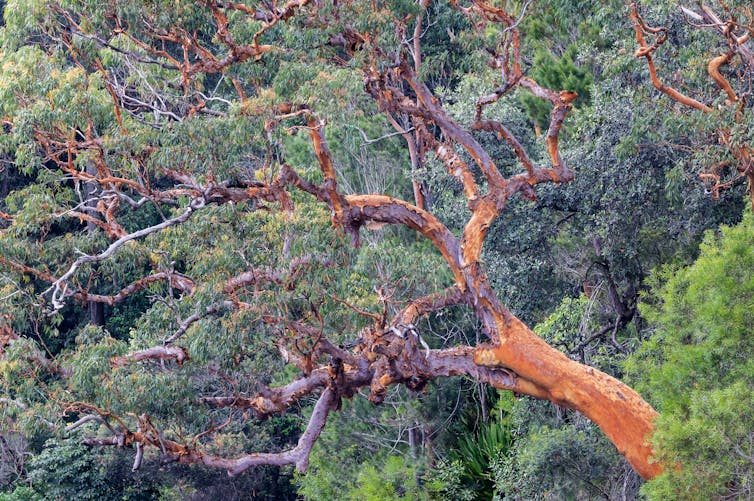
In most illegal tree removals, you might see perhaps a handful of trees removed or poisoned. That’s why the recent felling and poisoning of 265 old trees in Sydney’s Castle Cove has been so breathtaking and appalling.
This act – perpetrated by persons unknown – was not vandalism but theft of valuable community assets.
Future generations have been robbed of the benefits these trees – some of which were more than 80 years old – provided to our environment, the climate and as habitat for other plants and animals. It was theft on a grand scale.
Tree Loss Will Cost Us As The Climate Changes
In contrast to Indigenous people, most Australians have undervalued large old trees for nearly two centuries. But many of the ecological and environmental benefits these trees provide increase as they age over decades and perhaps centuries. These benefits are crucial to urban liveability and sustainability.
A global movement is gaining momentum in urban forestry to preserve old trees for as long as we can to maximise the benefits they provide.
It is not about preservation at all cost, but a recognition that in a proper cost/benefit analysis, large old trees outperform younger trees. Unnecessary removal of large old trees is unsustainable both environmentally and economically.
This does not mean we should not replace dangerous trees or those that are rapidly declining.
It does mean, however, there should be no removal of large old trees without significant and demonstrably sound reasons.
Too many large, old, urban trees are being removed unnecessarily because other management options are not considered.
Whether via theft or bureaucratic-sanctioned tree removals, the general loss of old trees will cost us and our society dearly as the climate changes.
Old Trees Do Things That Young Trees Simply Cannot
One of the significant benefits that trees provide over other vegetation types is that their leaf area is often more than double their canopy cover. This creates a great cooling effect via both shade and evapotranspiration (the movement of water into the atmosphere, some of which comes through leaves).
Large trees are unequalled in cooling the environment around them. Old trees simply do things on a scale that small young trees cannot.
This means a slow-growing old tree can take in and store more carbon than a quick-growing young seedling. Every gram of carbon stored in this way is carbon saved from going into the atmosphere as greenhouse gas emissions.
Both carbon stores and shade are crucial to mitigating future climate change.
All of this is lost when trees are illegally or unnecessarily removed. The impact is felt not just now but for decades into the future.
The Loss Of Even A Single Tree Comes At A Huge Price
The loss of so many trees in Sydney’s Castle Cove represents theft of environmental benefits and services from at least two, if not more, future generations of Australians. The trees lost were largely native coastal species that had decades (and in some cases more than a century) of growth before them.
We have known for many decades trees are often associated with between 30 and 50 other species – birds, mammals, reptiles, insects, fungi, algae and others. The removal of a tree affects most, if not all, of these other species. Some of these plants and animals will die as a result.
The number of associated species increases as the tree ages, and we have probably been underestimating species lost with large old tree removals in urban and natural forests.
Oaks in the UK, for example, are associated with over 2,300 other species. One can only wonder how many other species will be affected by the felling and poisoning of the trees at Castle Cove. The illegal loss of even a single tree comes at a huge price.
Simply Planting New Trees Doesn’t Fix The Problem
We tend to undervalue the shade provided by trees when considering urban development, or even road works. But tree removals lead to more urban heat, which usually means higher electricity bills (as people crank up the air conditioner).
Large old trees are seen by some as an expendable nuisance. Some local council laws aim to protect trees of a certain size, but fines for illegal removals are small.
In some instances, a one-for-one tree replacement is offered. But to replace the carbon stored in one large, mature tree would require a vast number of seedlings, many of which fail to survive the first few years.
And it can take many years before planted trees reach carbon neutrality. The production, planting and maintenance processes all use resources, energy and fossil fuels, which means it can take decades before a tree is carbon positive.
This situation is unsustainable environmentally and ludicrous economically, but it seems to go largely unnoticed. We accrue all of the costs of these plantings and recoup precious little benefit.
It would be far more sensible and sustainable if we retained our large old trees, making every effort to maximise and prolong their life spans.![]()
Gregory Moore, Senior Research Associate, School of Ecosystem and Forest Sciences, The University of Melbourne
This article is republished from The Conversation under a Creative Commons license. Read the original article.
3,200 deaths a year: 1 of many reasons air pollution in Australia demands urgent national action
Deren Pillay, University of Tasmania; Bill Dodd, University of Tasmania, and Bin Jalaludin, UNSW SydneyAustralia is holding its collective breath ahead of a bushfire season that may bring a return of the smoke linked to 400 deaths and 4,500 hospitalisations and emergency department visits during the 2019–20 Black Summer fires.
Air pollution is the world’s single greatest environmental cause of preventable disease and premature death. In Australia, it’s linked to more than 3,200 deaths a year at an estimated cost of A$6.2 billion.
These impacts are increasing due to climate change and an ageing population, among other factors. Scientists at the Centre for Safe Air (an NHMRC Centre for Research Excellence) have launched a report today on the many benefits of safer air for Australians, to mark the United Nations’ International Day of Clean Air.
The report summarises the extensive evidence on the health impacts of air pollution for Australians. This pollution consists of both airborne particles (also called particulate matter) and gases such as carbon monoxide, nitrogen dioxide and sulphur dioxide. The report also explains why co-ordinated national leadership is needed to make our air safer.
Why Invest In Clean Air?
Here are ten reasons Australia should invest in safer air.
1. Air pollution increases non-communicable diseases
Heart disease, stroke, dementia, type 2 diabetes, lung diseases and cancer are all leading causes of illness and death for Australians. Air pollution increases the risk of all these conditions in the community.
2. Air pollution makes communicable diseases worse
Air pollution increases the risk of respiratory infections such as influenza and COVID-19, and may increase their severity.
3. Air quality affects our health throughout life
Air pollution can affect the growth, development and overall health of unborn babies. Later in life it adds to the risk of developing non-communicable diseases.
4. It adds to health inequities
Action on air pollution represents a powerful opportunity to reduce health inequities in Australia. Some of the most vulnerable people in our society are at higher risk of worse health outcomes from air pollution exposure. They include older adults, pregnant people and unborn babies, children, people with pre-existing chronic conditions, socially disadvantaged populations and Aboriginal and Torres Strait Islander people. Lessening air pollution reduces inequity.
5. Climate change and pollution make each other worse
Climate change is leading to more frequent and severe bushfires. In turn, severe bushfires are influencing the global climate and weather systems. Reducing air pollution is vital for mitigating climate change because they share common drivers such as fuel combustion.
6. Clean-air policies have many co-benefits
Policies to reduce air pollution from burning fossil fuels have many health, environmental and social benefits. Measures range from decarbonising our energy and transport systems, greening our cities and improving urban and housing design to bushfire prevention strategies. Reducing air pollution improves social, environmental and economic wellbeing.
7. The impacts are increasing
Population growth and ageing, urbanisation and increasing transport and energy demands add to the risks for air quality, climate change and population health. This is why timely interventions are needed.
8. Economic costs are high and underestimated
Australian estimates to date have placed annual mortality costs of fine particulate matter (PM2.5) air pollution at A$6.2 billion. However, existing economic analyses of air pollution largely fail to account for the costs of other air pollutants, such as nitrogen dioxide from vehicle traffic, and non-health costs like labour, productivity, welfare and other societal impacts.
9. Return on investment is high
Every dollar spent generates returns in the forms of lower health costs, healthier people and longer lives. Soon-to-be-published research at the Centre for Safe Air has found reducing the average population exposure to fine airborne particles (PM2.5) by a modest and highly achievable 5% could save more than 360 lives and A$1.6 billion a year.
10. Small improvements produce large gains
The rate of increase of many air-pollution-related health outcomes is steeper at lower concentrations, tapering off at higher levels of pollution. For Australia, this means any small improvements, even to levels below current national air quality standards, will deliver measurable health and economic benefits.
All Of Us Have A Right To Clean Air
Air pollution and its adverse health effects are linked to how we generate energy, how we heat our homes, our transport systems and our climate. No single policy will adequately tackle the problem of air pollution. Therefore, effective policy measures and regulation must take into account the diverse sources, settings and populations that are more at risk from air pollution.
Currently, responsibility for air pollution policy falls between the health and environment portfolios. Policies are often needed in the environment, planning and transport sectors where health expertise and input are limited, whereas air pollution impacts and public health responses reside in the health sector.
Safe air is a shared resource and a fundamental human right. Air pollution affects everyone - co-ordinated national leadership on safe air will benefit all Australians.![]()
Deren Pillay, Researcher and Advanced Trainee in Public Health Medicine, Menzies Institute for Medical Research, University of Tasmania; Bill Dodd, Knowledge Broker, Centre for Safe Air (NHMRC CRE), and Adjunct Researcher, Media School, University of Tasmania, and Bin Jalaludin, Conjoint Professor, School of Population Health, UNSW Sydney
This article is republished from The Conversation under a Creative Commons license. Read the original article.
Marine heatwaves don’t just hit coral reefs. They can cause chaos on the seafloor
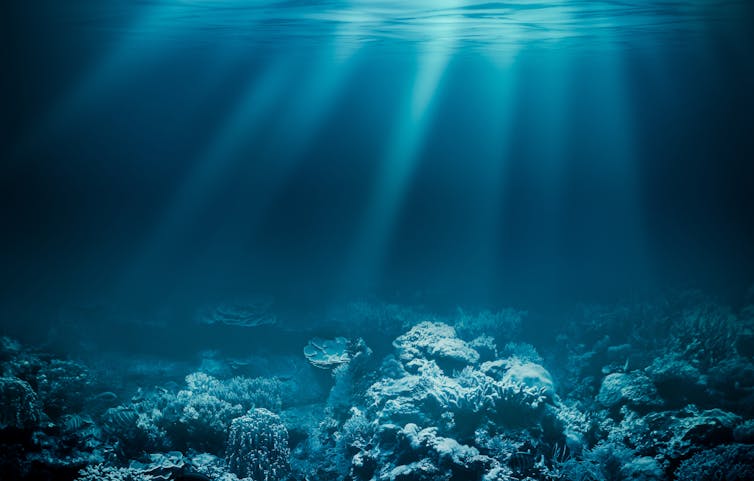
Most of us know what a heatwave feels like on land – sweltering heat for days. But oceans get heatwaves too. When water temperature goes over a seasonal threshold for five days or more, that’s a marine heatwave. They do their worst damage in summer, when the ocean is already at its warmest, but they can occur any time of year.
Over 90% of the heat trapped by greenhouse gases has gone into our oceans. So it’s no surprise marine heatwaves are getting much more intense and more frequent. This year has been off the charts. From April this year, the world’s average ocean temperature has been the highest ever recorded.
Since the 1980s, satellites have revolutionised ocean science by making it possible to take daily measurements of ocean temperatures. But satellites watch from above. They can’t see what’s happening below the surface.
Our new research explores what’s happening in deeper waters. It turns out, marine heatwaves aren’t just on the surface. In the most devastating marine heatwaves, heat can penetrate right down to the sea bed. Remarkably, some heatwaves only affect the seafloor.
Why Do Deep Marine Heatwaves Matter?
While we usually only see sea creatures at the surface of the ocean, there’s life all the way down. In the shallower seafloors of the continental shelf – the sunken parts of our continents – live fish, kelp beds, sponges, cold water corals, shellfish and crustaceans.
These shallow oceans are, on average, less than 100 metres deep. When the shelf ends, there’s usually an abrupt slope into the deep ocean, where there are kilometres of water between surface and seabed.
Marine heatwaves are damaging to life in the seas covering the continental shelf. Creatures here are sensitive to extreme temperatures, just like those at the surface. But “extreme” to them is different to what we think of as extreme. If you’re used to water at 12℃, a heatwave of 15℃ can be devastating.
When marine heatwaves strike, they can kill. More than a billion sea creatures died during a single heatwave off the coast of the western United States and Canada in 2021. This year, extreme heatwaves have hit large parts of the oceans during the northern summer.
Fish and other creatures that can move do so, heading towards the poles or down deeper in search of cooler water. Those that can’t have to endure it or die. Heatwaves can trigger migration. New species arrive, seeking refuge and can alter the ecosystem.
We Don’t Know Much About Deeper Marine Heatwaves
The seas covering the continental shelf are relatively shallow compared to the kilometres of water in the deep oceans. But even so, it’s impossible to see what’s going on below using satellites or high-frequency radar.
The sea is a hostile environment. Instruments are subject to high pressure, corrosive salt water and marine organisms like oysters and sponges settling on them. This is one reason why we only have very limited data on long-term trends in temperatures under the surface. But these records are vital to calculate typical temperatures for the time of year and to figure out what constitutes an extreme.
Australia is one of the few places generating this kind of valuable data long-term. Off the coast of the southeast lie many oceanographic moorings – a floating collection of sensors anchored to the bottom. One of these has been measuring daily temperatures from the surface to the seafloor 65 metres down since 1993.
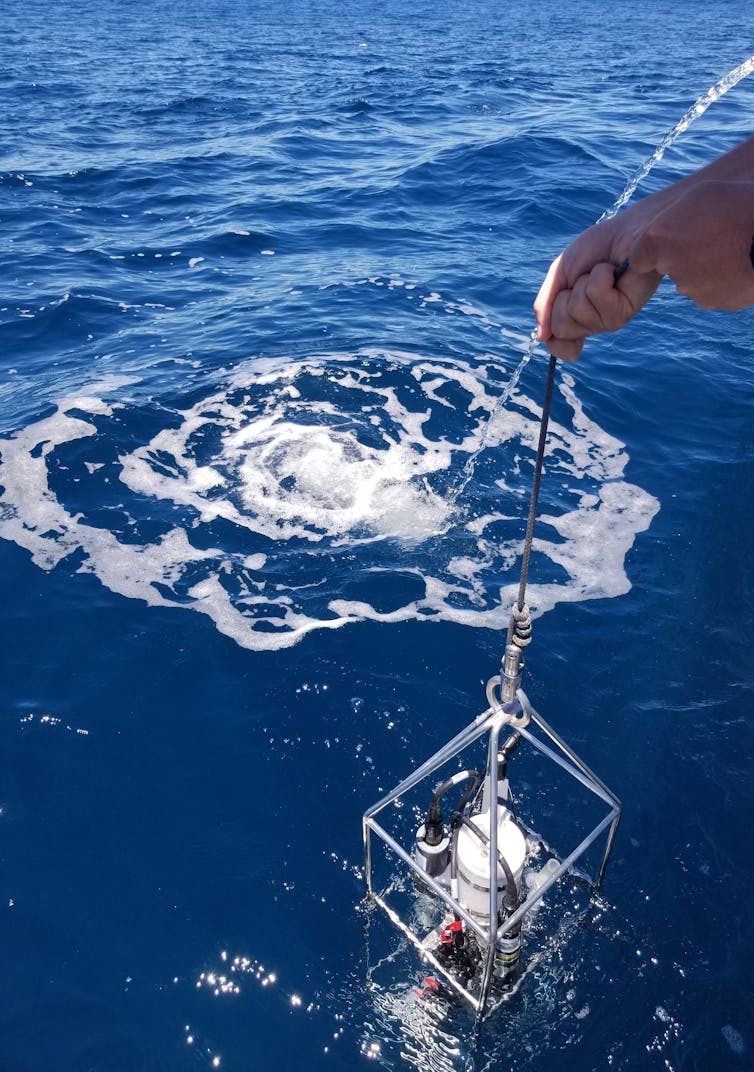
Our earlier research found marine heatwaves at depth can actually be more intense and last longer compared to the surface. But why?
In our new research, we looked at the temperature data closely. We found marine heatwaves come in a variety of types and have different causes. We also found some types of marine heatwave are more likely during particular seasons.
For instance, winter marine heatwaves often run from surface to seafloor. They occur when the powerful, deep and warm East Australian Current snakes westward towards the coast. As the current swings over the continental slope, it drags warm water over the shelf and close to the coast.
In summer, Australia gets two very different types of heatwave in our oceans. The first occur when we get blue-sky weather. With few clouds, more heat from the sun gets into the oceans. They can also occur when there are weaker winds and less ocean cooling from evaporation. These heatwaves are confined to the surface and a few metres below.
Then there’s the second, a very weird heatwave system that only appears close to the seafloor. These are produced when strong wind creates currents driving warm, shallower water down to the bottom. On the east coast, these currents come from cold winds from the south. So even while you’re shivering through cold winds from the Southern Ocean, the ocean seafloor may be sweltering through a heatwave. These may be the most destructive to ecosystems but go all but unnoticed.
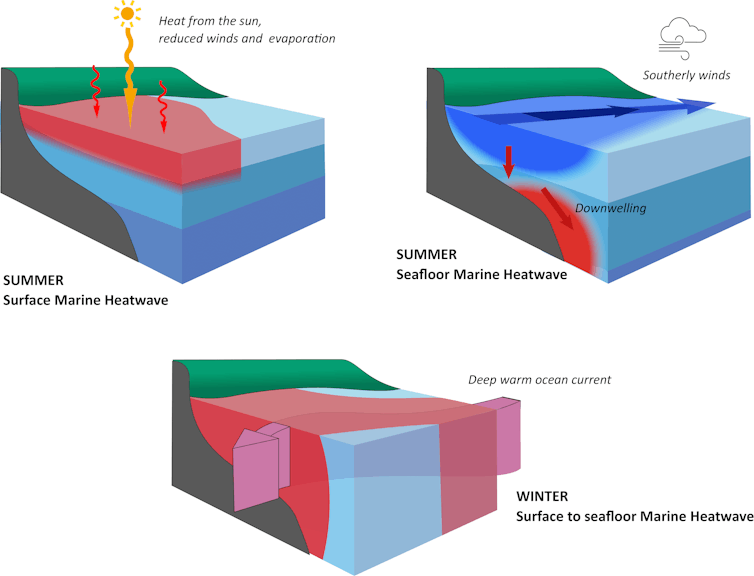
Marine Heatwaves Are Not Created Equally
Our research has shown marine heatwaves come in different flavours. That matters, because it will allow us to get better at predicting if a heatwave is about to strike our oceans. And it will let us anticipate which parts of the water column are about to be hit, and which ecosystems.
Of course, slowing ocean warming and preventing marine heatwaves from damaging ecosystems means slashing carbon emissions. But while we work on that, this knowledge could give us time to find strategies to reduce the undersea death toll – and the damage to tourism and fishing which rely on these ecosystems surviving. ![]()
Amandine Schaeffer, Senior lecturer, UNSW Sydney; Alex Sen Gupta, Senior Lecturer, School of Biological, Earth and Environmental Sciences, UNSW Sydney, and Moninya Roughan, Professor in Oceanography, UNSW Sydney
This article is republished from The Conversation under a Creative Commons license. Read the original article.
How one student forced the government to admit the economic risks of climate change
Arjuna Dibley, The University of MelbourneLast month, a significant victory for climate change was won behind closed doors. In 2020, Katta O’Donnell, then a 23-year-old university student in Melbourne, launched a world-leading class action lawsuit against the Commonwealth government.
O’Donnell alleged that she and other investors in Australian-issued bonds had been misled because the government failed to disclose how climate change might impact their investments.
Sovereign bonds allow governments to borrow money, from which, on top of taxes, they can fund expenditures and programs. Historically, investors consider sovereign bonds issued by stable economies such as Australia a safe bet.
Because our economy is large and our economic, political and legal institutions stable and mostly free from corruption, investors can be fairly certain that Australian governments will repay their debts.
This has created steady demand for Australian sovereign bonds, making them a reliable way for our governments to fund policy programs and respond to economic shocks. But O’Donnell’s lawsuit broadly questioned whether sovereign bonds were really safe for investors once the economic impacts of climate change were taken into account.
Her lawyers argued that the Commonwealth government should disclose the way climate change posed both “physical” and “transition” risks to the economy.
The first are financial risks that climate scientists say will impact Australia’s economy due to changes to the climate and the rise in extreme weather events. The second kind of risk emerges from changes in global demand for our fossil fuel exports.
O’Donnell’s lawyers also suggest that investors increasingly expect governments to try to manage their climate risks.
They point to the 2019 decision by Sweden’s Central Bank, Sveriges Rijksbank, to divest its holdings in Queensland and Western Australian bonds, because they are “not known for good climate work”, as an example of investors taking these risks seriously.
In March 2021 the Commonwealth sought to have the claim struck out, alleging it was not clear what risks should be disclosed.
At that time, few government bond prospectuses issued around the world referred to climate risks. However, Justice Murphy of the Federal Court decided to keep the legal action on foot because he saw an “informational asymmetry” between the government and investors regarding the nature of climate risks.
Following the election of the Albanese government, the Commonwealth decided not to contest the case in court, but to seek mediation.
Under the terms of the settlement, agreed on August 7 and to be approved by the court next month, the government will likely acknowledge on the Treasury website that climate change presents a risk to the country’s “economy, regions, industries, and communities”, and that there is uncertainty around the global transition to net zero emissions.
The government’s decision to disclose climate risks is no surprise. It is already taking steps to better understand and report on how climate change will affect the economy. Beyond taking policy measures to support the transition to a “net zero” economy, it has tasked Treasury with developing a national sustainable finance strategy.
It has also asked some large listed companies to analyse and disclose their climate-risk exposure, and is developing a legal framework – called a “taxonomy” – to better regulate sustainable finance.
The Reserve Bank of Australia’s new governor, Michele Bullock, also said in a recent speech that the economic implications of climate change could affect the stability of the financial system.
The settlement is significant because, for the first time, an AAA-rated government will recognise climate change as a systemic risk that can affect the value of its bonds. Large sovereign investors and credit-rating agencies are already focusing on how climate change impacts a country’s ability to repay, and pricing this information into its loans.
All this is creating pressure for governments like ours to better understand and disclose climate risks when they borrow money.
But climate risk disclosure in sovereign bonds is not enough. Governments are qualitatively different entities to companies, from which these disclosure practices evolved.
Companies are more able than governments to rid themselves quickly of polluting assets, acquire new clean resources, or change the location of their operations. Investors can engage with companies on climate change through annual general meetings, but they struggle to influence governments on climate change (although some are trying to develop strategies for doing so).
So while the recent case is a reminder for government issuers to consider how climate change will impact government bond repayment obligations, their challenge isn’t solved by better disclosure practices.
Nevertheless, Australian governments should continue their plans to better understand and disclose climate risks.
Moreover, under instruments such as Sustainability Linked Sovereign Bonds, governments can set climate-related performance targets, such as lowering carbon emissions by 10% by 2025. A government that does not meet these predetermined targets could be subject to an increase in its interest rate, or another penalty.
These instruments create an incentive for governments to achieve real emission reductions, which is the only activity that will ultimately address climate risk in the economy.
Correction: this article originally stated Katta attended the University of Melbourne.![]()
Arjuna Dibley, Head of Sustainable Finance Hub, The University of Melbourne
This article is republished from The Conversation under a Creative Commons license. Read the original article.
Exposing Australia’s online trade in pest plants – we’ve found thousands of illegal advertisements

Do you buy plants online? You might be breaking the law without even knowing it.
We found hundreds of different invasive plants and prohibited weeds advertised on a popular online marketplace.
For the first time, our research has exposed the frequent, high volume trade in pest plants across Australia.
State and territory governments are adopting our automated surveillance approach to help regulate the online trade in plants and other wildlife. Biosecurity officers can receive automatic alerts for suspected illegal trade, rather than manually monitoring websites or relying on reports from the public.

What’s The Problem And Why All The Fuss?
Certain plants are prohibited in Australia because they are harmful to our unique natural environment and agricultural industries. These weeds can threaten native species, fuel severe fires and choke rivers.
Weeds are also a social and cultural threat for First Nations people, because they can compete with traditional food and medicine plants, causing them to decline.
Overall, invasive plants are estimated to have cost Australia A$200 billion since 1960.
Weeds that are controlled under state and territory laws are referred to as “noxious” or declared plants. Each state and territory has different laws prohibiting the sale and cultivation of these declared plants.
Compliance is generally high within the horticultural industry, save for the occasional high profile blunder. The main problem for Australia is the widespread invasive plant trade on public online marketplaces.
Trade of ornamental plants, which are the kinds popularly grown in homes and gardens, is the major current pathway enabling invasion and spread of weeds into new areas. They’re travelling long distances, to homes in new places.
Invasive cacti and ornamental pond plants are among the most frequently advertised plants, but many are banned from sale and distribution in Australia.
Internet trade has historically been tricky to monitor and regulate, which has led to a variety of invasive species being widely traded.

Scraping The Web
We used specialised software called “web scrapers” to monitor trade on a public classifieds website. These automated web tools can be used to rapidly harvest information from advertisements. This allowed us to detect thousands of advertisements for weeds over a 12-month period.
We found 155 declared plant species traded on one website, and we suspect there could be more.
Prickly pear cacti were among the most frequently traded declared plants. This is concerning given their history in Australia. In the 1920s, about 25 million hectares of land became unusable due to prickly pear invasion.

Aquatic weeds were another popular group. That includes water hyacinth, which is the world’s most widespread invasive alien species according to a recently published global assessment.
We found some sellers advertised uses for the declared plants they were trading, including for food and medicinal properties.
Aquatic weeds were often stated to have water-filtering properties and provide habitat for fish. Those traits make Amazon frogbit a popular choice for aquariums and ponds, but if the weed enters creeks and rivers it can have devastating consequences.
Everyone Can Do Their Bit
Better surveillance is not the only solution. Public awareness is key to reducing invasive plant trade. We can all make informed decisions about the plants we buy.
A significant hurdle is a phenomenon called “plant blindness”. People tend to find plants harder to recognise than animals. We found many weeds sold using generic names such as lily, cactus or pond plant. Some people may not even know the true identity of a plant they are selling, let alone that it is a weed and illegal to trade.
Another complication is the fact that laws differ between states. Plants that might be legal for an interstate trader, might still be illegal for you to buy. This is why caution should be taken when sending or receiving plants by post. Always check your local regulations before buying or selling a plant online. You can find out what is declared on your state or territory’s biosecurity website or on Weeds Australia.
Online marketplaces must also cooperate with local policies. These platforms should be enforced to self-regulate trade and include measures to prevent illegal advertisements from being posted in the first place. Failure to act may result in significant penalties from governments. Last year the Brazilian government fined Meta for failing to remove illegal wildlife trade from Facebook and WhatsApp.
For now, monitoring tools such as the web scrapers we have developed will help to prevent some weeds escaping backyards and into bushland. As plant lovers, it’s important to be mindful of the plants we choose to buy and keep. ![]()
Jacob Maher, PhD Candidate, University of Adelaide and Phill Cassey, Australian Research Council Industry Laureate Fellow, University of Adelaide
This article is republished from The Conversation under a Creative Commons license. Read the original article.
Australia’s least wanted – 8 alien species and diseases we must keep out of our island home

This week’s landmark report on the impact of invasive alien species revealed costs to the global economy exceeded US$423 billion (A$654 billion) a year in 2019. Costs have at least quadrupled every decade since 1970 and that trend is set to continue.
Prevention is better than a cure. Stopping pests and diseases arriving and establishing in Australia is not only better for the environment, it’s much cheaper too.
The biosecurity system is our front line against invasion. Species that pose a significant risk to agriculture have historically received more attention, but we also need to defend our borders against threats to nature.
Here we take a closer look at some pests and diseases we need to keep out at all costs, to protect our biodiversity.
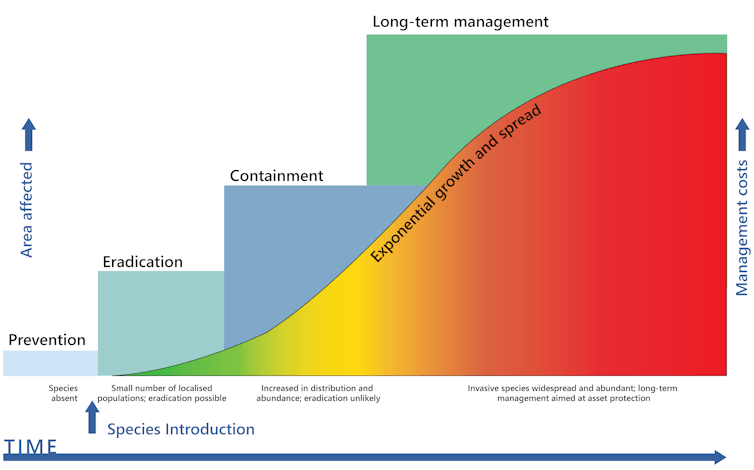
One Of The Biggest Threats To Biodiversity
Alien species are those deliberately or accidentally introduced to areas where they are not native. If they cause problems, we call them invasive.
Invasive alien species include weeds, feral animals, exotic pests and diseases.
Those that have already arrived have taken a huge toll. Introduced predators were largely responsible for most of Australia’s mammal extinctions. And introduced diseases have decimated our frogs.
Invasive species are pushing most (82%) of Australia’s 1,914 nationally listed threatened species closer to extinction.
Imagine if those invasive species had been kept out of Australia. Here are eight of the pests and diseases we really need to keep out.
1. Giant African Land Snail
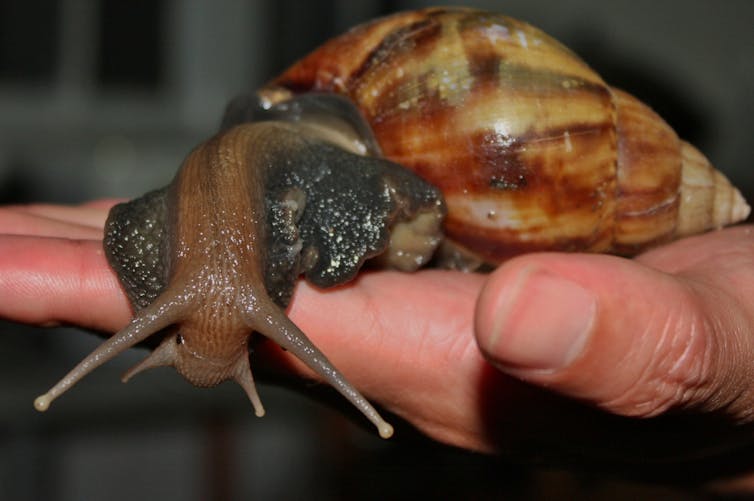
Giant African snails have a ferocious appetite. They feed on more than 500 species of plants including agricultural crops and eucalyptus trees. The shells of these giants can be 20cm long and females typically lay 1,200 eggs a year. Adult snails could sneak into shipping containers or machinery and their eggs could be transported in soil or goods. They are now present on Christmas Island.
2. Avian Influenza
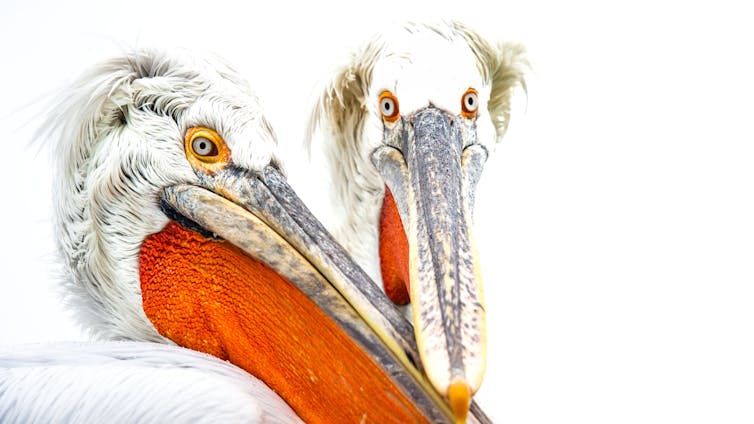
Avian influenza or bird-flu is a viral disease found in birds. Some strains can kill farmed poultry and susceptible wild birds. Such highly pathogenic strains are thought to have killed millions of wild birds globally in the past few years. The virus can also jump across to mammals, recently knocking off 3,500 sea lions Peru.
Migratory birds could bring the virus here but it could also be carried in imported birds and poultry products, including contaminated eggs, feathers, poultry feed and equipment. Our biosecurity system is responsible for surveillance and early detection, preparedness and management to protect our vulnerable wildlife. In California, preparation includes vaccinating endangered condors.
3. New Tramp Ants
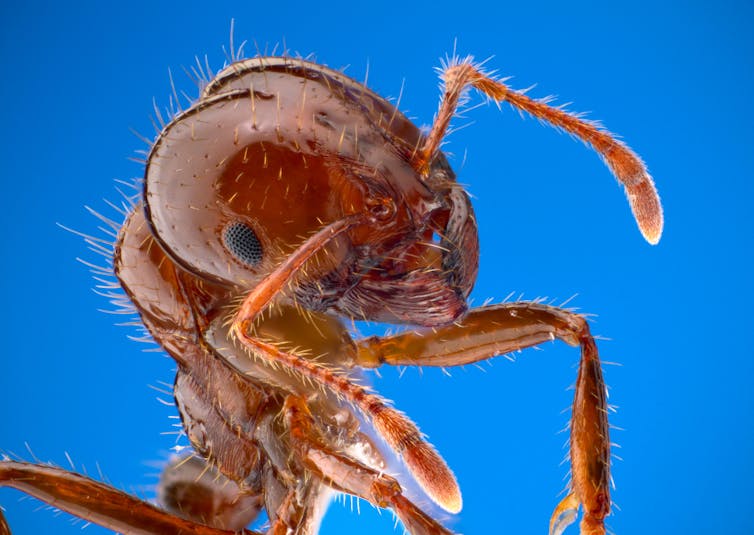
We’re already battling some species of tramp ants, but there’s more where that came from - there are at least 16 different species. So far six species including red imported fire ants have been detected, with efforts underway to contain or eradicate them at their incursion points. On Christmas Island, another tramp ant species (yellow crazy ants) formed “super colonies”, killing every animal in their path, including tens of millions of the island’s iconic red and robber crabs. Ants are easily transported to new areas in dirt, plants and cargo. Tramp ants threaten Australian ecosystems, agriculture and human health.
4. Bat White Nose Syndrome
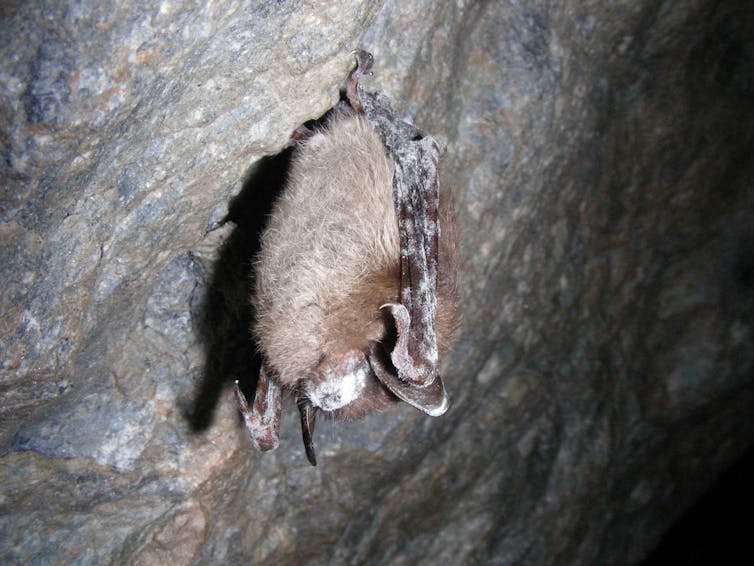
White nose syndrome is a bat disease caused by a fungus. In less than 20 years it has killed more than five million bats across North America, causing local extinctions and reducing the beneficial services performed by bats such as eating harmful insects. The fungus could be introduced to Australian caves on the shoes, clothing and equipment of people who had previously visited caves in Europe or North America.
5. Crayfish Plague
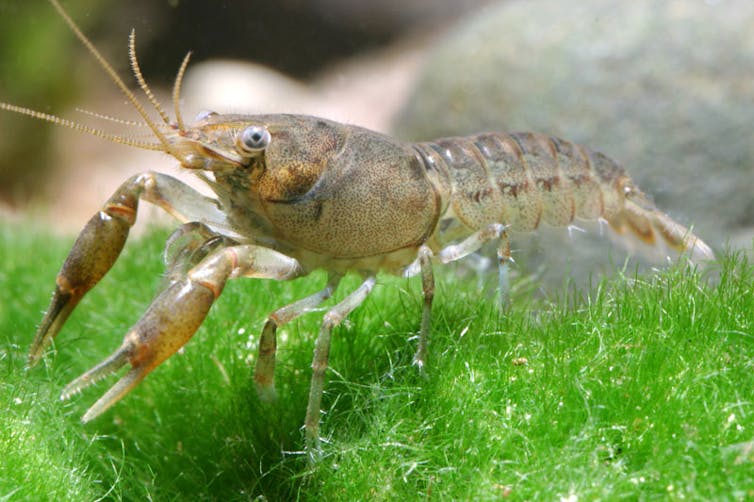
A highly infectious fungal disease, crayfish plague is the main cause of crayfish declines across Europe. It has the potential to devastate Australian freshwater crayfish populations. North American crayfish can be carriers of the disease and the illegal trade of crayfish, such as the dwarf Cajun crayfish for aquariums, also threatens to introduce the disease.
6. New Myrtle Rust Strains
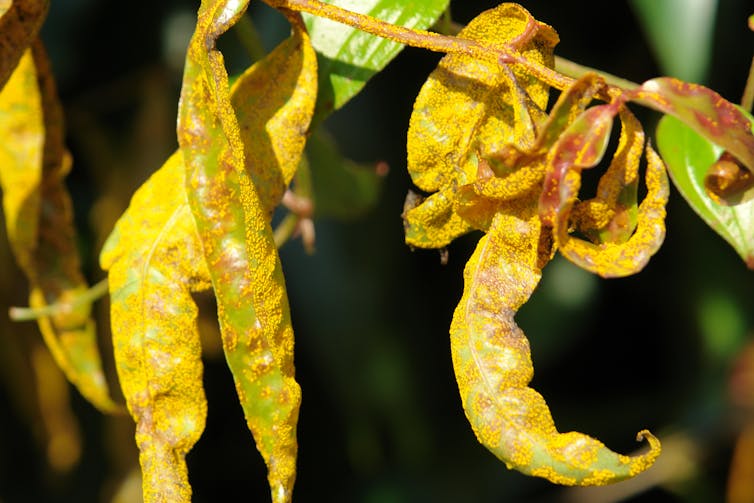
When a strain of myrtle rust arrived in Australia in 2010, it spread quickly along the east coast, infecting 358 different native plant species including eucalypts, bottle brushes and lilly pillies. It has caused major declines and local extinctions of many species. Other exotic myrtle rust strains occur outside Australia. These present serious threats to Australia’s natural environment and to commercial native forest plantations. Importing infected plant material is the main risk of introduction.
7. Savannah Cats

Savannah cats are two to three times the size of domestic cats. In 2008 the federal government banned the importation of savannah cats. A scientific assessment found pet savannah cats had the potential to establish and roam across 97% of the country if they escaped or were released. They can take down prey twice as large as feral cats, so 90% of Australia’s native land mammals would be at risk. Demand for the species from the pet trade raises the risk of smuggling or illegal trade.
8. Black Spined Toad
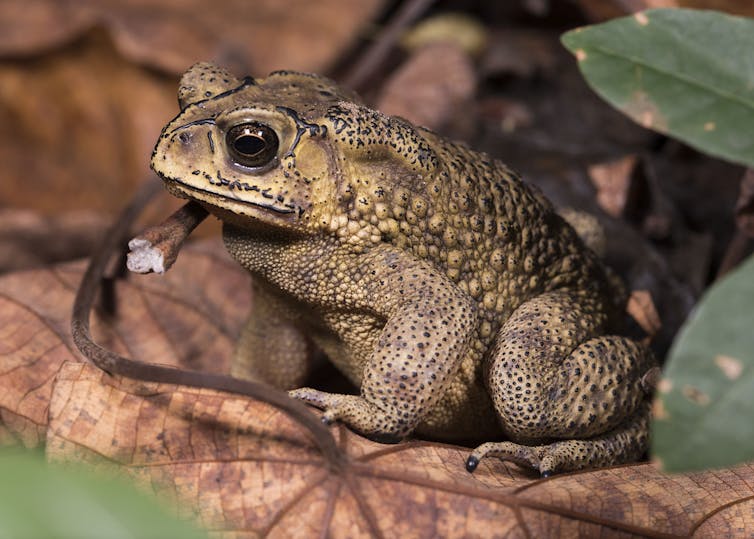
The black spined toad is potentially more damaging than the cane toad because it could survive across a bigger region including in the colder parts of Australia. It would prey on native frogs and other small animals, be toxic to larger animals, and probably carry exotic parasites or disease. It is a common stowaway in shipping cargo.
Prioritising Nature
Australia’s biosecurity system has generally served our country well, but it is under constant and growing strain. Historically, the environment has also been the poor cousin of agriculture at the biosecurity table.
Preparedness and responses for environmental threats remain chronically underfunded, especially when compared to those developed for industry.
A well-resourced independent body focused on the prevention and early elimination of new environmental pests and diseases would be a major step toward achieving our global commitments to end extinction.![]()
Jaana Dielenberg, University Fellow, Charles Darwin University and Patrick O'Connor, Associate Professor, University of Adelaide
This article is republished from The Conversation under a Creative Commons license. Read the original article.
UN invasive species report reveals scale of threat to nature and people – and how to manage it
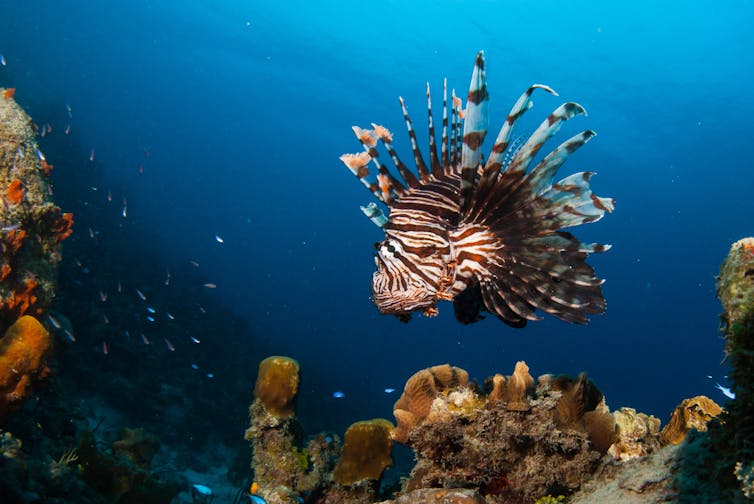
More than 3,500 invasive alien species are seriously compromising human wellbeing and causing irreversible damage to ecosystems, according to the Intergovernmental Science-Policy Platform on Biodiversity and Ecosystem Services (IPBES). While some alien species actually benefit humans, the UN organisation estimates 10% threaten nature and people.
Alien species are plants, animals or other organisms that are introduced to new regions by human activities. A subset of them, known as invasive alien species, can make native species go extinct, spread diseases such as malaria, Zika and West Nile fever, and damage food crops.
The IPBES, a body of experts tasked with assessing the state of nature and its contributions to society, has identified invasive alien species as a significant cause of the declining variety of lifeforms on Earth. Other threats include the loss and degradation of habitats, pollution, climate change and the overharvesting of species for food, their body parts and the pet trade.
A new report by the IPBES, created by 86 experts from 49 countries over four years, drawing on over 13,000 scientific studies and including contributions from indigenous peoples, highlights the particular threat of invasive species.
Growing Threat
Invasive alien species affect all world regions, including Antarctica. The IPBES assessment says that 34% of the impacts are reported in the Americas, 31% in Europe and Central Asia, 25% in Asia and the Pacific, and 7% in Africa.
Most impacts are reported on land (75%), with fewer in freshwater (14%) and marine (10%) habitats. Islands are particularly vulnerable, with alien plants outnumbering natives on more than 25% of the world’s islands.

The assessment highlights that indigenous peoples, who are more likely to have deep cultural ties to the lands on which they live, are particularly vulnerable. More than 2,300 invasive alien species occur in indigenous territories, threatening the quality of life and cultural identities of millions of people.
The report also reveals that invasive alien species are linked to 60% of global plant and animal extinctions. Their implicit economic cost exceeded US$423 billion (£361 billion) annually in 2019 and has quadrupled each decade since 1970.
The threat of invasive alien species will loom larger in future due to increasing trade and travel. Their impacts could be amplified as they interact with other drivers of biodiversity loss, such as climate change.
Taking Control
An effective response to each invasive species will depend on where it is happening and how it is spreading. But it should combine efforts across countries and sectors. Raising awareness among the public will also be necessary.
Although 80% of countries have targets for managing invasive alien species, only 17% have specific national laws or regulations. The IPBES assessment also highlights that 45% of countries do not invest in the management of biological invasions, which puts their national neighbours at risk.
The assessment calls for effective management to address the growing threat. Its recommendations include:
increasing preparedness and prevention through pre-border quarantines and strict import controls, which are generally the most cost-effective solutions
early detection of invasions and rapid responses through general surveillance strategies, especially in aquatic environments
eradicating invasive species where possible – this is most feasible for small, slow-spreading species (for example, feral cats) and particularly in isolated ecosystems such as islands
containment, which can be effective for invasive alien species that cannot be eradicated.
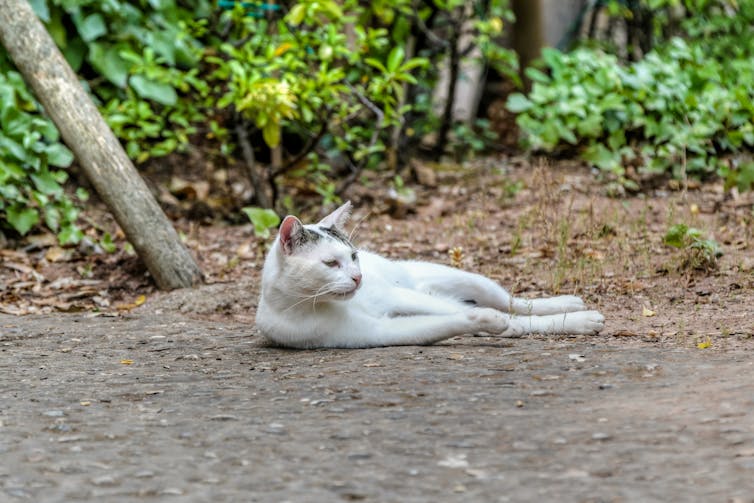
Invasive Aliens Can Be Beneficial
Alien species can also benefit people. The recent assessment acknowledged that perceptions of their threat can vary depending on who you ask, which can complicate their management. The report does not offer guidance for these cases, but assessing the benefits and costs of each alien species is a good place to start.
For example, feral cattle, sheep, goats and pigs on the Caribbean island of Montserrat provide meat for local cuisines. Another assessment by the Montserrat Department of Environment (which I helped with) found that discontinuing management of these feral animals could halve the island’s nature-based tourism revenue. This ongoing control programme provides a steady supply of wild meat, which would fall by 36% in its absence.
Having an accurate understanding of the damage caused by invasive species, as well as their potential benefits and the cost of controlling them, is essential for properly tackling one of the biggest threats to Earth’s biodiversity.
Don’t have time to read about climate change as much as you’d like?
Get a weekly roundup in your inbox instead. Every Wednesday, The Conversation’s environment editor writes Imagine, a short email that goes a little deeper into just one climate issue. Join the 20,000+ readers who’ve subscribed so far.![]()
Kelvin S.-H. Peh, Associate Professor of Conservation Science, University of Southampton
This article is republished from The Conversation under a Creative Commons license. Read the original article.
On hot days, up to 87% of heat gain in our homes is through windows. On cold days, it’s 40% of heat loss. Here’s how we can fix that
Trivess Moore, RMIT University; Lisa de Kleyn, La Trobe University, and Tom Simko, RMIT UniversityClimate change and energy costs mean we need to rethink how we design and build our homes. The updated National Construction Code has lifted the required energy performance of new housing from 6 stars to 7 stars (10 stars being the best). Windows are an obvious focus for improving the energy efficiency of Australian homes.
On hot days, most of the heat that gets into our homes is through the windows. On cold days, windows account for almost half the heat loss. High-performance insulating windows have been installed in Australian homes at a fraction of the rates for New Zealand, the United States and the United Kingdom.
In our newly published report, we found the local window industry can produce the high-performance windows we need for thermally efficient homes. These homes will cost less to heat and cool, with lower greenhouse gas emissions.
But the industry is complex, with several obstacles to greater uptake of these windows. We identified a range of government policies and industry actions that could help drive change.
How Much Difference Do Windows Make?
Single-glazed windows are common in Australian housing. Heat travels easily through these windows so they are a thermal weak spot.
In Australian homes, up to 87% of heat gain in summer and 40% of heat loss in winter is through the windows. This makes it harder to maintain a comfortable temperature inside.
Around 40% of household energy use in the average Australian home is for heating and cooling. The result is high power bills.
High-Performance Windows Can Solve This Problem
Better windows are available. Double-glazed and triple-glazed windows offer much better performance, reducing the need to use energy for heating and cooling. In some climate zones, they’re one of the most cost-effective investments in energy efficiency you can make.
These windows have insulating layer(s) of air between the glass panes. Other elements can also improve performance. These include thermal breaks (an insulating barrier that reduces heat flow through the window frame) and films that can be applied to the panes.
These approaches can be used in new window units, or with retrofit options such as secondary glazing, which can be cheaper than replacing the whole window unit. It involves installing a glazed panel in a frame inside an existing window. This can be a great solution for apartments as it might not require owners corporation approval.
High-performance windows offer many benefits beyond greater thermal comfort. These include better physical and mental health as a result of homes no longer being too hot or too cold, improved control of ventilation and natural light, and reduced noise from outdoors.
Australia is trailing far behind other countries in installing high-performance windows. Just over 10% of windows in new housing in Australia are high-performance – versus around 80% in the United Kingdom, the United States and New Zealand.
Scaling Up Use Of High-Performance Windows
We explored the window and residential building industry in Victoria on behalf of Sustainability Victoria. Our aim was to understand the industry and its readiness to scale up the manufacture, sale and installation of high-performance windows. We also wanted to understand what support might be needed to achieve this transition.
The people we spoke to, drawn from across the sector, said they are ready to scale up once demand is there. They clearly said there isn’t any technological barrier to doing this.
The time from ordering to receiving windows has increased in recent years as part of wider supply-chain issues. We were told this was almost resolved. However, a rapid scaling up of demand for high-performance windows could create short-term supply challenges.
The builders we spoke to identified some issues around understanding the various window products, such as the relative benefits of different frame materials. For example, uPVC and timber frames typically conduct less heat than aluminium. However, a thermal break can greatly improve aluminium frame performance.
They also noted that high-performance windows cost more. This can be a challenge in an industry already struggling to provide housing at affordable prices.
In addition, high-performance windows are heavier. Extra equipment could be needed to install them.
How Can Policy Help Improve Uptake?
We found the industry is complex. A range of measures will likely be needed to encourage the uptake and delivery of more high-performance windows. Our research proposes the following interventions:
regulation – further improve regulations to nudge use of high-performance windows, which could include setting minimum performance requirements for windows as New Zealand has done
education – better educate builders and consumers with easy-to-understand, transparent information to bust myths about high-performance windows and encourage people to consider their wider benefits
finance – there is a need to reduce capital costs (economies of scale will help) and improve access to government support, which could include rebates for home owners, similar to those for rooftop solar systems
quality assurance – the range of high-performance window options means we need to ensure key intermediaries like energy assessors provide well-informed advice. Support tools such as the Window Energy Rating Scheme can help with decision-making. There is also a need to ensure quality installation practices.
Windows For The Future
Given the key role of windows in housing quality, performance and emissions, installing high-performance windows needs to become business as usual. In many other countries, double-or-triple-glazed windows are now standard. If we don’t do the same, we will lock households into lower-quality, poorly performing housing for decades.
Making high-performance windows standard building practice in Australia is achievable. However, some support for the window industry, builders and households will be needed.![]()
Trivess Moore, Senior Lecturer, School of Property, Construction and Project Management, RMIT University; Lisa de Kleyn, Research Fellow, Climate Change Adaptation Lab, La Trobe University, and Tom Simko, Senior Lecturer, School of Property, Construction and Project Management, RMIT University
This article is republished from The Conversation under a Creative Commons license. Read the original article.
The US is spending billions to reduce forest fire risks – we mapped the hot spots where treatment offers the biggest payoff for people and climate
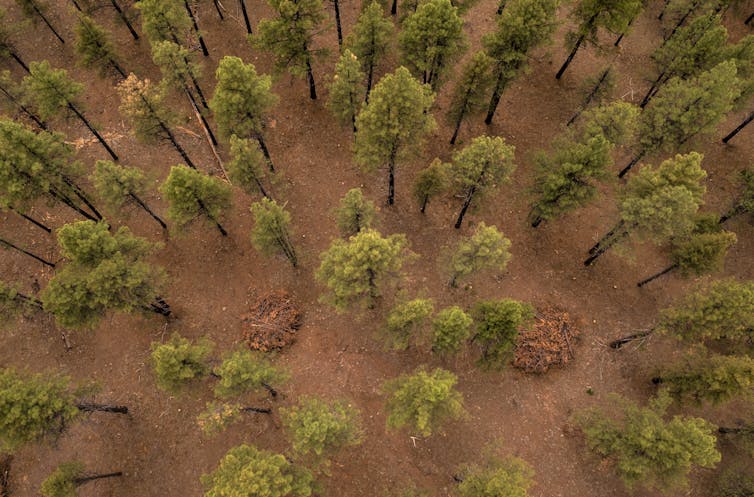
The U.S. government is investing over US$7 billion in the coming years to try to manage the nation’s escalating wildfire crisis. That includes a commitment to treat at least 60 million acres in the next 10 years by expanding forest-thinning efforts and controlled burns.
While that sounds like a lot – 60 million acres is about the size of Wyoming – it’s nowhere close to enough to treat every acre that needs it.
So, where can taxpayers get the biggest bang for the buck?
I’m a fire ecologist in Montana. In a new study, my colleagues and I mapped out where forest treatments can do the most to simultaneously protect communities – by preventing wildfires from turning into disasters – and also protect the forests and the climate we rely on, by keeping carbon out of the atmosphere and stored in healthy soils and trees.
Wildfires Are Becoming More Severe
Forests and fires have always been intertwined in the West. Fires in dry conifer forests like ponderosa pine historically occurred frequently, clearing out brush and small trees in the understory. As a result, fires had less fuel and tended to stay on the ground, doing less damage to the larger, older trees.
That changed after European colonization of North America ushered in a legacy of fire suppression that wouldn’t be questioned until the 1960s. In the absence of fire, dry conifer forests accumulated excess fuel that now allows wildfires to climb into the canopy.
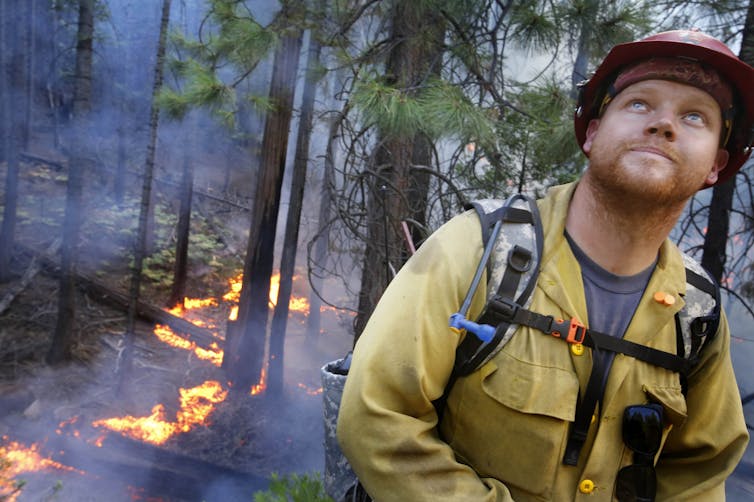
In addition to excess fuels, all forest types are experiencing hotter and drier wildfire seasons due to climate change. And the expanding number of people living in and near forests, and their roads and power lines, increases the risk of wildfire ignitions. Collectively, it’s not surprising that more area is burning at high severity in the West.
In response, the U.S. is facing increasing pressure to protect communities from high-severity wildfire, while also reducing the country’s impact on climate change – including from carbon released by wildfires.
High-Risk Areas That Meet Both Goals
To find the locations with greatest potential payoff for forest treatments, we started by identifying areas where forest carbon is more likely to be lost to wildfires compared to other locations.
In each area, we considered the likelihood of wildfire and calculated how much forest carbon might be lost through smoke emissions and decomposition. Additionally, we evaluated whether the conditions in burned areas would be too stressful for trees to regenerate over time. When forests regrow, they absorb carbon dioxide from the atmosphere and lock it away in their wood, eventually making up for the carbon lost in the fire.
In particular, we found that forests in California, New Mexico and Arizona were more likely to lose a large portion of their carbon in a wildfire and also have a tough time regenerating because of stressful conditions.
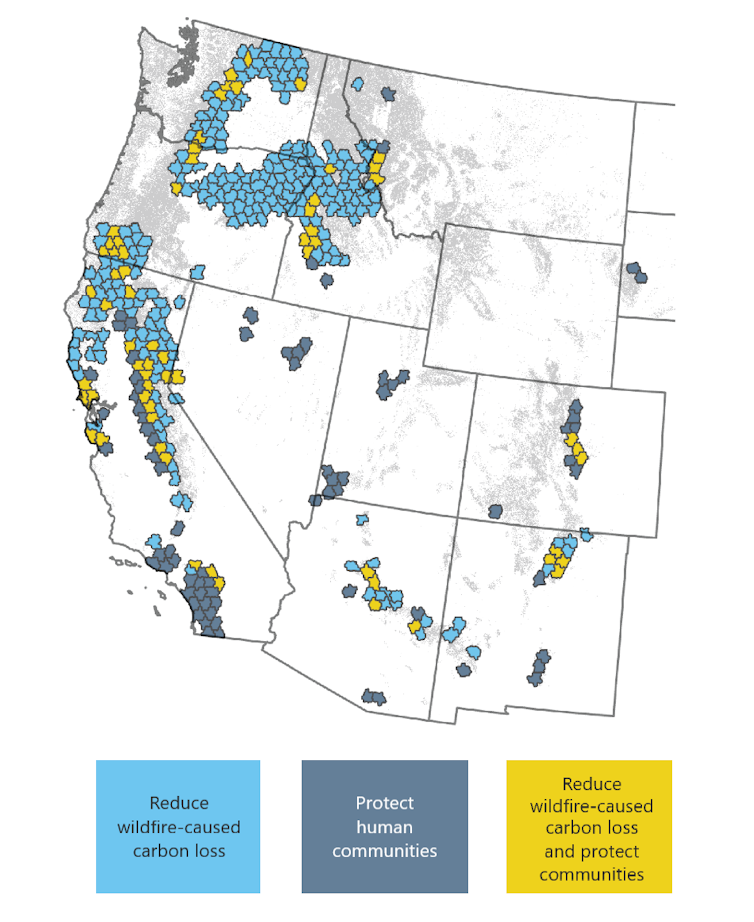
When we compared those areas to previously published maps detailing high wildfire risk to communities, we found several hot spots for simultaneously reducing wildfire risk to communities and stabilizing stored carbon.
Forests surrounding Flagstaff, Arizona; Placerville, California; Colorado Springs, Colorado; Hamilton, Montana; Taos, New Mexico; Medford, Oregon, and Wenatchee, Washington, are among locations with good opportunities for likely achieving both goals.
Why Treating Forests Is Good For Carbon, Too
Forest thinning is like weeding a garden: It removes brush and small trees in dry conifer forests to leave behind space for the larger, older trees to continue growing.
Repeatedly applying controlled burns maintains that openness and reduces fuels in the understory. Consequently, when a wildfire occurs in a thinned and burned area, flames are more likely to remain on the ground and out of the canopy.
Although forest thinning and controlled burning remove carbon in the short term, living trees are more likely to survive a subsequent wildfire. In the long term, that’s a good outcome for carbon and climate. Living trees continue to absorb and store carbon from the atmosphere, as well as provide critical seeds and shade for seedlings to regenerate, grow and recover the carbon lost to fires.
Of course, forest thinning and controlled burning are not a silver bullet. Using the National Fire Protection Agency’s Firewise program’s advice and recommended materials will help people make their properties less vulnerable to wildfires. Allowing wildfires to burn under safe conditions can reduce future wildfire severity. And the world needs to rapidly transition away from fossil fuels to curb climate change impacts that increase the risk of wildfires becoming community disasters.![]()
Jamie Peeler, Postdoctoral Research Fellow, University of Montana
This article is republished from The Conversation under a Creative Commons license. Read the original article.
The US broke global trade rules to try to fix climate change – to finish the job, it has to fix the trade system
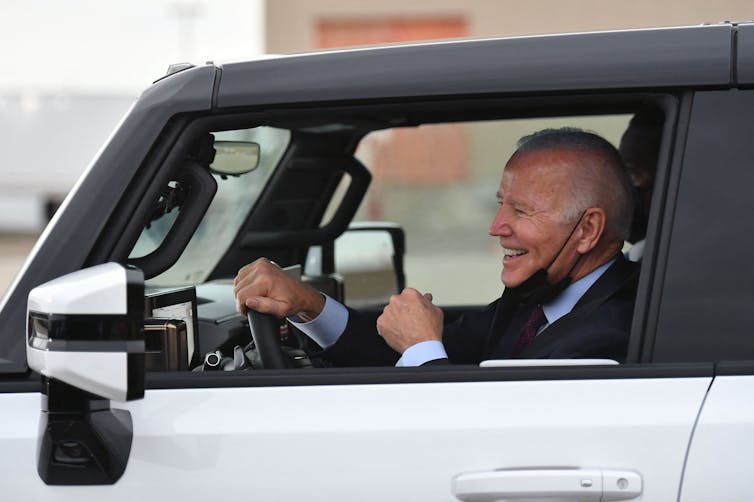
The 2022 Inflation Reduction Act, President Joe Biden’s landmark climate law, is now expected to prompt a trillion dollars in government spending to fight climate change and trillions more in private investment. But the law and Biden’s broader “buy American” agenda include measures that discriminate against imports.
One year in, these policies, such as the law’s electric vehicle subsidies, appear to be succeeding at growing domestic clean energy industries – consider the US$100 billion in newly announced battery supply chain investments. But we believe the law also clearly violates international trade rules.
The problem is not the crime but the cover-up. Today’s trade rules are ill-suited for the climate crisis. However, simply tearing them down could hinder economic growth and climate progress alike.
If U.S. leaders instead take responsibility for forging an improved international trade system – rather than denying the violations of trade rules or pointing fingers at similar transgressions by trade partners – they could help put the global economy in a better position to weather increasing climate-related trade tensions.
Building, Then Violating WTO Rules
The United States has shaped international trade rules more than any other country.
In the 1940s, the U.S. proposed rules that were eventually largely adopted as the General Agreement on Trade and Tariffs, or GATT, a series of multinational agreements to reduce trade barriers. The most ambitious of the GATT agreements was the U.S.-instigated Uruguay Round of the 1990s, which created the World Trade Organization.
Some WTO rules are vague, but others are crystal clear, including an unambiguous prohibition of subsidies contingent on the use of domestic products instead of imports. Certain provisions of the Inflation Reduction Act do exactly that, such as the electric vehicle subsidies that require a large percentage of parts to be produced in North America.
The choice facing U.S. policymakers was between accepting the Inflation Reduction Act, including its rule-breaking, protectionist elements, or missing the small window to pass federal climate legislation.
Sen. Joe Manchin (D-W.Va.) explicitly refused to provide the 50th vote needed to pass the law if it wasn’t to his liking, and among his asks was domestic sourcing requirements. More broadly, any meaningful climate legislation that does not support the local economies of fossil fuel-heavy regions may be dead on arrival in the U.S. Senate.
Without the Inflation Reduction Act, however, the U.S. had next to no chance of meeting its climate commitments, which would have dampened climate policy momentum across the world.
U.S. leaders might have been justified in begging for forgiveness after passing the legislation rather than asking for permission to violate trade rules. Instead, Sen. Ron Wyden (D-Ore.), who chairs the powerful Senate Finance Committee, said his team reviewed the international trade laws very carefully and found no violations.
Instead of an apology, U.S. leaders have said, “You’re welcome,” arguing that the subsidies will benefit other countries by accelerating the deployment of clean energy technologies and lowering costs.
While there is strong evidence to support this argument, it falls flat from a country that has failed to fulfill its obligations to take federal action on climate change for decades and just violated trade laws it has held others accountable to for so long. India’s power minister accused the West of hypocrisy, saying the Inflation Reduction Act’s protectionism will inhibit the energy transitions in developing economies.
The Real Concern: Rising Protectionism
The Inflation Reduction Act contains a fundamental contradiction. Its promise to reduce global greenhouse gas emissions relies on the rapid diffusion of technologies, knowledge and finance across borders. Yet, its domestic subsidies may accelerate the adoption of trade barriers that inhibit these same cross-border flows, thus slowing progress on climate change.
Moreover, the investments it catalyzes will immediately benefit the U.S. economy, while the shared benefits of technological progress and emissions reductions will unfold over many decades for other countries. In the intervening years, other countries may respond with protectionist policies of their own.
Indeed, the real concern might not be the opening salvo, but the shootout of growing protectionism that ensues. For all its drawbacks, the growth in international trade since World War II has led to immense economic progress in much of the world, including the United States. The WTO and its predecessors have been instrumental in reducing harmful tariffs and providing a consistent set of trade rules to which countries are supposed to adhere.

The Biden administration is attempting to assuage these concerns by forging agreements that make more foreign producers eligible for Inflation Reduction Act subsidies. But, in our view, bespoke agreements with a handful of countries aren’t enough. A new vision is needed for international trade rules that support low trade barriers and “green industrial policies” alike.
An Opportunity To Modernize International Trade
Global trade rules have not been updated in a generation. They are sorely in need of reform.
The usefulness of the WTO is contingent on most parties agreeing that its rules are worth following. Without a new working consensus and backing from the largest powers with effective vetoes, the organization will become irrelevant.
The first step to fixing the situation is to stop denying the problem or digging deeper holes, such as the United States’ ill-advised blocking of appointments to the WTO’s dispute settlement Appellate Body since 2017 to protest what it sees as overreach by the body.
More proactively, the U.S. can reestablish its commitment to trade rules by instigating a process to develop equitable reforms.
That could begin with a global summit to discuss the changes necessary to reflect new realities. High-level leadership from the United States would add considerable heft to the ongoing efforts to reform global trade rules.
Any fundamental rewrite of WTO rules will be a long and painstaking process. Instead, it may be sufficient to add a few clauses to existing agreements – like GATT Articles 20 and 21, which deal with exceptions to the trade rules – that clearly and transparently recognize that governments will need to nurture emerging domestic industries to cut emissions fast, ensure energy security and support vulnerable economies.
New rules could limit and define the appropriate use of green subsidies, carbon border tariffs, export and import controls and supply chain coordination. For example, the U.S. and other developed countries could agree to limit subsidies’ domestic sourcing requirements to only emerging, innovative clean technologies that require public support to commercialize. Building on this, all countries could work toward an explicit list of clean energy, transport and industrial technologies needed by all that can be traded with reduced or minimal tariffs.
Of course, these trade tools would have to be managed carefully to avoid proliferating and exacerbating tensions.
In the meantime, since U.S. leaders are already acting as if these rules exist, they’ll have to accept that other countries’ leaders may act similarly — a new Kantian Golden Rule for trade.
It may turn out that the United States did the world a favor by throwing off the shackles of outdated trade rules. That will depend on whether U.S. leaders take advantage of the opportunity to reframe the discussion around the country’s recent legislation as steps toward a modernized international trade regime that better aligns with the world’s climate goals.![]()
Noah Kaufman, Research Scholar in Climate Economics, Columbia University; Chris Bataille, Adjunct Research Fellow in Energy and Climate Policy, Columbia University; Gautam Jain, Senior Research Scholar in Financing the Energy Transition, Columbia University, and Sagatom Saha, Research Scholar in Energy Policy, Columbia University
This article is republished from The Conversation under a Creative Commons license. Read the original article.
Wildfires have wreaked havoc this summer – these plants were prepared
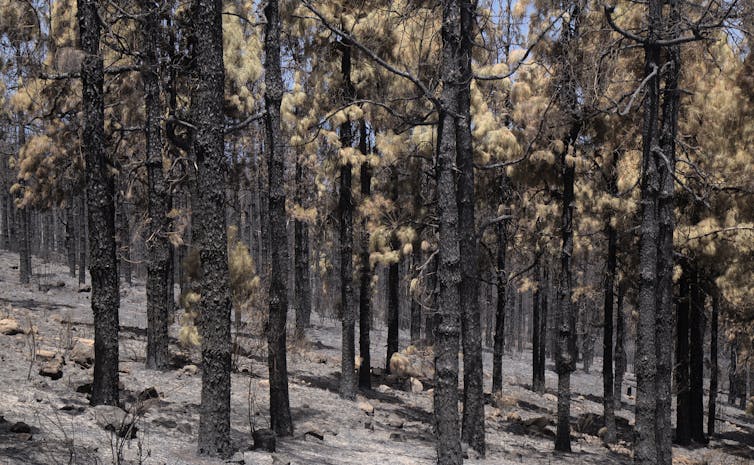
Summer 2023 has seen wildfire crews tirelessly battle forest fires worldwide. The Canary Islands, a Spanish archipelago off the Moroccan coast, have faced their worst fires in 40 years, but amid the devastation lies a remarkable tale of resilience.
The Canary Islands consist of seven islands, including the popular holiday destinations of Tenerife, Gran Canaria and Fuerteventura. Increased drought and higher temperatures driven by climate change have strained communities and wildlife here. Approximately 6% of Tenerife has been scorched by fire and more than 26,000 residents displaced by fires during 2023. But unlike people, plants cannot escape the harsh conditions.
A harsh environment is not a new phenomenon on the Canary Islands, though. Throughout their history these islands have experienced volcanic eruptions (such as the 2021 eruption of La Palma) and brutal droughts. Before people arrived, wildfires would ignite due to volcanic activity or lightning strikes. Fires were a part of a natural cycle. As such, a number of the island’s native species (which make up 40% of plants on the island today) have adapted over millions of years to weather these destructive events.
As climate change brings ever more frequent fires, can these adaptations help the island’s native flora survive?
Fire-Resistant Armour
Over millions of years evolution has come up with a few tricks to survive environmental disasters. There are two main strategies when it comes to wildfires. The first kind protects adult plants from the flames, ensuring their survival. The second aims to help forests recover quickly from a fire by producing new offspring.
One species that employs both these strategies is the endemic Canarian pine (Pinus canariensis). Pine woodlands cover 60% of the archipelago and are the vegetation most affected by wildfire. But due to its adaptive features, the Canarian pine is regarded as one of the most fire-resistant trees on Earth.
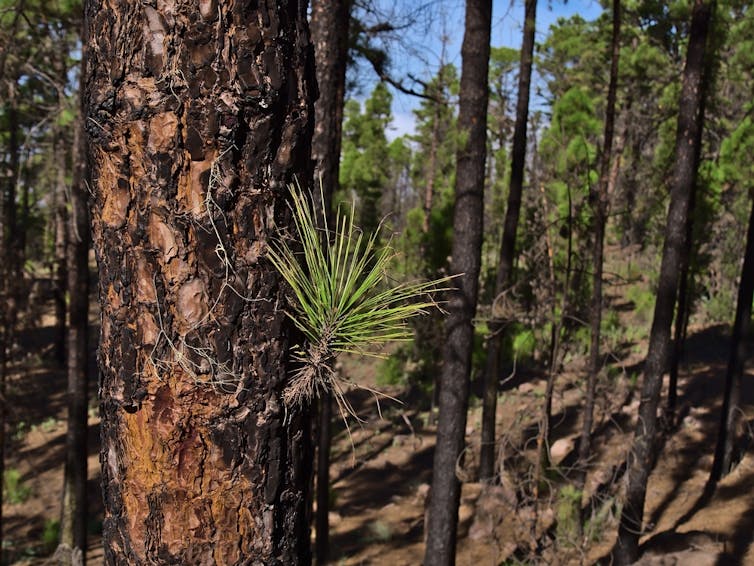
Canarian pines drop their lower branches as they age, preventing fires from climbing up their trunks. They also have thick, heat-insulating bark which acts as a shield against flames – protecting the living tissue within.
One study found that after the 2007 wildfires in Tenerife there were no dead mature trees – even those trees with more than 70% of their canopy torched had survived.
After a fire, Canarian pines swiftly regenerate. The trees reserve energy as starch within the soft living flesh of the tree specifically for these occasions and sprout buds from beneath their bark which otherwise lie dormant.
The destruction caused by wildfires creates competition between the plants that do survive to reproduce quickly and fill the scorched, empty spaces. Canarian pines achieve this with cones that contain seeds enclosed by a resin only fire can melt, at which point the seeds are released onto the bare soil below.
Many smaller plants that inhabit the floor of these pine forests have seeds that can survive wildfires too. Once the fire has passed, they rapidly grow to exploit the bare earth. A lotus plant creates a yellow canvas of flowers only a few months post-fire.

A Hotter, Drier Future
Unfortunately, these adaptations have limits. The combination of human activity, such as campsites or arson, and climate change is presenting new challenges compared with the natural fires these plants evolved with.
Prolonged droughts, driven partly by shifting weather patterns associated with climate change, have worsened conditions in the Canary Islands, increasing the frequency of fires beyond the capacity of forest ecosystems to regenerate. The pressure on forests is compounded by invasive species, ravenous goats and rabbits and the conversion of wild lands into farms and towns.
As well as burning away vegetation, wildfires harm the soil and can contaminate water, as well as destroy vegetation which helps keep water in the environment, spurring drought. With a staggering 20% of the archipelago’s native flora currently classified as “endangered” on the IUCN Red List, urgent efforts are needed to ensure the continued survival of these unique species.
Most native species do not possess the adaptations that allow some to withstand wildfires on the Canary Islands. And even those that do are struggling with fire seasons evolution never prepared them for.
Don’t have time to read about climate change as much as you’d like?
Get a weekly roundup in your inbox instead. Every Wednesday, The Conversation’s environment editor writes Imagine, a short email that goes a little deeper into just one climate issue. Join the 20,000+ readers who’ve subscribed so far.![]()
Amy Jackson, Postdoctoral Research Associate, Royal Botanic Gardens, Kew and Mark Chapman, Associate Professor, Ecology and Evolutionary Biology, University of Southampton
This article is republished from The Conversation under a Creative Commons license. Read the original article.
Chimpanzees are not pets, no matter what social media tells you
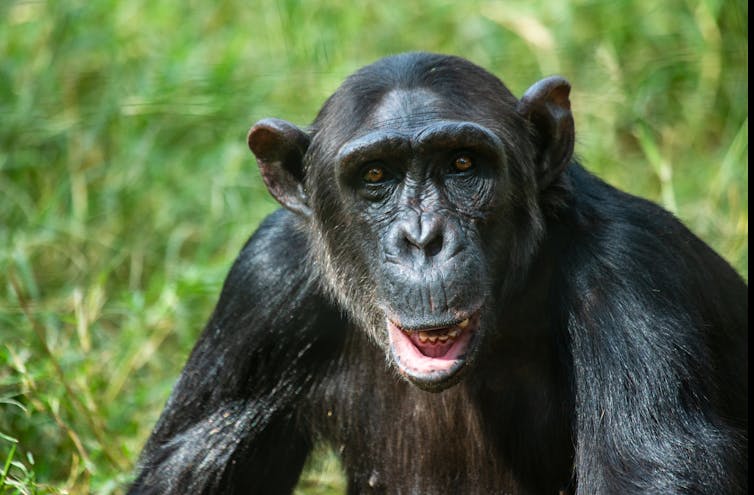
Trading wild chimpanzees, including their meat and body parts, is illegal. And yet, social media influencers and companies still reap profits from sharing “cute” images and videos of chimpanzees and other primates poached from the wild. All the while, sanctuaries worldwide continue to receive orphaned victims of this illicit trade.
As a comparative psychologist who studies the social and emotional behaviour of great apes, I have worked with chimpanzee populations both in the wild and in sanctuaries. Currently, I’m working at Chimfunshi Wildlife Orphanage Trust, a sanctuary located in Zambia. Over the past 40 years, Chimfunshi has provided sanctuary to over 100 chimpanzees rescued from the pet and bushmeat trades.
In May 2023, Chimfunshi welcomed three new rescues. Following their rehabilitation, Abbie, Francis and Vanessa* will be integrated into a small community of eight other chimps who were rescued from similar conditions in 2018.
Chimpanzees are not native to Zambia. So, why do these animals still end up in these circumstances, and how can we help to keep them in their wild homes where they belong?
Chimp Trafficking
Chimpanzees live across sub-Saharan Africa, in habitats ranging from savannah-woodland mosaics to tropical rainforests. These habitats that chimps depend on are threatened by the expansion of agricultural activities, alongside the encroachment of the logging, mining and oil industries.
The fragmentation of chimpanzee habitats makes it easier for poachers to hunt them. Chimpanzees are now listed as endangered by the International Union for the Conservation of Nature’s Red List.
Chimfunshi is home to chimpanzees stolen from the wild and sold for sums as high as US$10,000 (£7,900). Prior to their rescue, some of Chimfunshi’s chimps were forced to surf for tourists (nearly drowning in the process) and smoke cigarettes. One was even taught to masturbate on circus stages in front of families.
In these conditions, they are in an environment alien to their species. The chimpanzees’ natural inclinations are inhibited by chains or harsh training to keep them on their best behaviour for social media or tourists. Typically, “pet” chimps are unable to even interact with their own kind, preventing these incredibly social animals from knowing how to be themselves.
María Laura Cordonet Castagneto, a University of Girona researcher I have worked with at Chimfunshi, told me that one nine-year-old does not even know how to play or groom, as she was not raised among other chimps. Part of this chimp’s rehabilitation is to help her learn such crucial social behaviours from watching and engaging with her new peers.
Most of Chimfunshi’s rescues are physically or emotionally scarred from beatings by their previous captors to keep them disciplined. Many will have watched their mothers and peers try to protect them from capture, and being slaughtered in the process.
Like most primates that are imprisoned in human homes or used by the entertainment industry, chimpanzees quickly outgrow their attraction as “pets” as they age. Their canines grow, they become uncontrollably strong and their behaviour more erratic. For every chimp that is saved, many more are abandoned or killed when they can no longer be controlled.
Not So Cute
For a chimp to wear human clothing, play the piano, ride a skateboard or hang out with tourists paying US$700 (£560) for a ten-minute session, so much suffering must occur. This is the cruel reality that “cute” TikTok videos and Instagram reels neglect.
Such content is pushed virally to our newsfeeds, regardless of whether the animal is a family dog or a creature illegally poached from the wild. Research has found that depicting wild animals in human contexts can increase the desire of a viewer to buy their own exotic pet.
But social media companies ignore this problem because this type of content drives considerable online engagement. The Instagram account for Limbani, a chimpanzee who lives in Miami, has nearly 800,000 followers and a 1.5% engagement rate (a measure of how much of your audience actively engages with the content). To put this in context, Kim Kardashian’s Instagram account has an engagement rate of around 0.65%.
What Can Be Done?
We can all individually make choices towards the future we want to support. Only sharing responsible online content of wild animals in their natural habitats is one option. But you can take a more active role in wildlife conservation by avoiding unethical wildlife tourism activities.
However, the long-term survival of endangered species can only be guaranteed through a systemic shift in how we perceive and treat the natural world. First and foremost, we must start by making it socially undesirable to own wild animals as pets.
Steps have been taken in recent years to reduce and restrict the trade of exotic animals. More than 50 countries have banned (or have announced impending bans on) the use of wild animals in circuses. And the UK government has set out proposals to finally outlaw primate pet ownership in 2024.
Even Hollywood – which has a long history of using trained monkey or ape “actors” – is shifting to the use of computer-generated imagery to depict primates on screen. Social media must catch up, and recognise that holding exotic animals in human contexts represents a grizzly and exploitative industry – and thus reflects animal abuse.
Chimpanzees are our closest living relatives. They are thoughtful, emotional and have complex social needs. They belong in their wild homes where they can be themselves. Primates are not pets.
*The names of Chimfunshi’s new rescues have been changed to protect the identities of the chimpanzees and those who rescued them.![]()
Jake Brooker, Research Associate in the Department of Psychology, Durham University
This article is republished from The Conversation under a Creative Commons license. Read the original article.
Farmers are famously self-reliant. Why not use farm dams as mini-hydro plants?
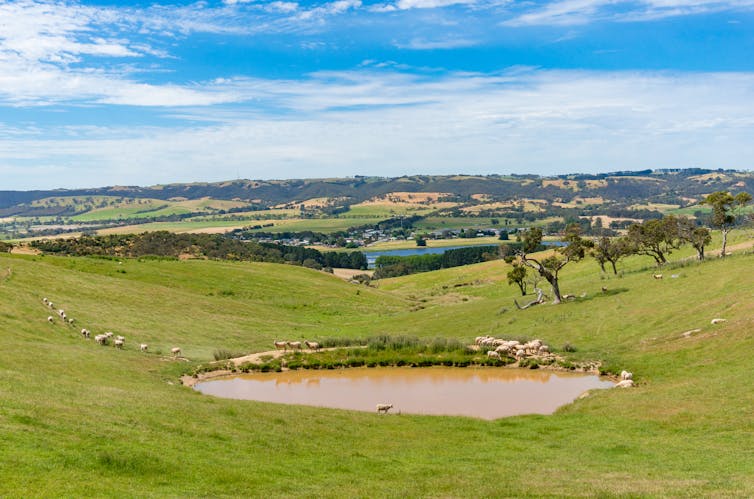
Farmers often pride themselves on their self-reliance. When you live far from the cities, it makes sense to do as much as possible yourself. Australia’s sheer size has meant many remote farms have long been off grid as it’s often simply too expensive to get a power connection. But for those still on the grid, there are now new options.
As solar gets cheaper, more and more farms are aiming to become self-reliant in power. But until now, getting fully off the grid has had a sticking point – solar intermittency. Solar power might be cheaper than ever, but if you don’t have storage or backup, you’re still reliant on the grid when the sun doesn’t shine.
Batteries are a compelling solution. But they might not offer a full day’s backup and come with concerns about fire risk and waste.
Generators offer reliable backup. But they too have downsides – they have to be resupplied and produce harmful emissions.
For farmers, there’s now another option: connect one of your dams to a river – or link two dams together – to create a small pumped hydro plant to store electricity from solar to use at night. The water in your dams could offer yet another form of self-reliance.
Our new research has identified over 30,000 rural sites where micro pumped hydro could work. A typical site could produce two kilowatts of power and store 30 kilowatt hours of energy – enough to run a typical home in South Australia for 40 hours.
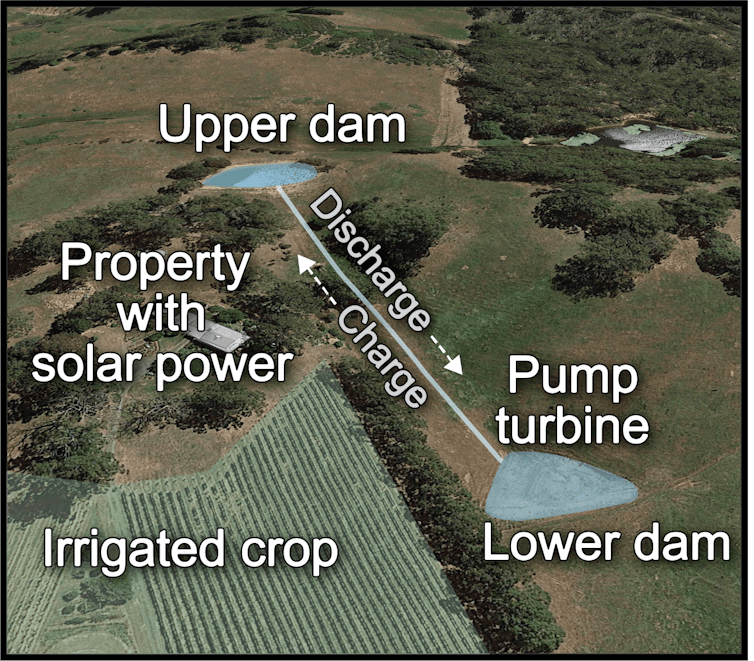
Massive To Micro? Yes, Pumped Hydro Can Work On Farms
Pumped hydro is essentially turning hydroelectric power into a battery as well.
Take two reservoirs, where one is higher than the other. When you have extra solar power, you store it. How? By using the energy to pump water uphill to the top reservoir. When you need power later on, you release water down to the lower reservoir and produce electricity with a turbine.
At large scale, these plants are an established and efficient way to store energy, though they can suffer from cost blowouts, as in the Snowy 2.0 scheme. Queensland’s government is planning massive pumped hydro schemes to act as batteries.
Until recently, small-scale pumped hydro hasn’t made much economic sense.
But the steadily falling cost of solar means the numbers have changed. It’s now more cost effective to get larger arrays. And that opens up opportunities to find ways to store surplus electricity generated in daytime.
For farmers, another opportunity is the ability to use existing dams and reduce pumped hydro construction costs.
If it’s cheaper, it’s much more viable. Early research on solar-powered irrigation systems using pumped hydro suggests the payback period for this kind of energy storage could be up to four times shorter than for batteries.
What’s the catch? As you might have guessed, this solution depends on the size of existing farm dams and rivers, and topography of the land.
The steeper the slope between the two water bodies, the more useful the system will be as energy storage. To get the most out of these systems means finding the sites with the most potential value. And it’s likely the solution won’t work for farms on flat ground – you need a drop of at least 20 metres.
You’re probably wondering how this stacks up financially. We compared a micro pumped hydro system with 42.6kWh capacity and able to discharge 3.6kW to a commercial lithium-ion battery, the Tesla Powerwall, able to store 13.5kWh and discharge 5.0kW.
We found micro pumped hydro storage was 30% cheaper than a battery if locally generated solar was regularly needed overnight – such as to power a 24/7 irrigation system.
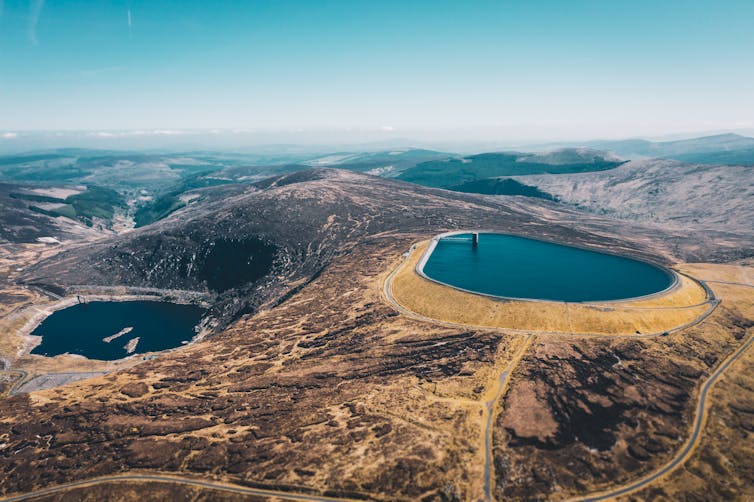
Australia Has Thousands Of Potential Sites
Our research is the first continent-wide assessment of potential pumped hydro farm dam sites.
How did we figure out how many sites would suit micro pumped hydro? The magic of maths. We used algorithms from graph theory, as these are used to model networks, and set them loose on a 2021 survey of 1.7 million Australian farm dams. We didn’t want to raise people’s hopes if their dams weren’t suitable, so we set the minimum capacity at 24kWh (similar to a typical home battery after efficiency losses) and with a minimum slope of 17%, to make it price competitive with a battery.
That’s how we came up with our figure of 30,000 promising sites, including dam-to-dam and dam-to-river sites. Dam-to-river sites are a good option if you have a dam at a reasonable elevation above a river – you can pump water uphill from the river and return it later to make power.
What’s Next For This Approach?
You can make this approach more efficient by using new all-in-one hardware, such as combined turbines and water pumps, as well as integrating it with smart irrigation management.
To be clear, this solution won’t work for every landholder. If you’re farming wheat on flat plains, you’re unlikely to have the slope needed to make it work.
If you’re considering getting storage to go off grid, it’s essential to consider the pros and cons of each technology and how it would suit your local conditions.
For instance, if you’re in a drought-prone area with limited groundwater, it may not make sense to install pumped hydro. During a drought, you may well need the water on the farm. Our research assumes 70% of the water in the dams is available for use, which does not account for droughts or irrigation needs.
But for some landholders, this may be the missing part of the puzzle. Wind and solar installation is skyrocketing [around the world]. This, in turn, is boosting demand for cost-effective energy storage. Given there are 30,000 suitable farm dams in Australia alone, it’s likely this technology could play a valuable role around the world – especially for farmers in remote areas or where grid connection is too expensive. ![]()
Nicholas Gilmore, Lecturer in Engineering Design, UNSW Sydney; Martino Malerba, ARC DECRA Fellow, Deakin University, and Thomas Britz, Senior Lecturer, UNSW Sydney
This article is republished from The Conversation under a Creative Commons license. Read the original article.
California and Florida grew quickly on the promise of perfect climates in the 1900s – today, they lead the country in climate change risks

Images of orange groves and Spanish-themed hotels with palm tree gardens filled countless pamphlets and articles promoting Southern California and Florida in the late 19th century, promising escape from winter’s reach.
This vision of an “American Italy” captured hearts and imaginations across the U.S. In it, Florida and California promised a place in the sun for industrious Americans to live the good life, with the perfect climate.
But the very climates that made these semitropical playgrounds the American dream of the 20th century threaten to break their reputations in the 21st century.

In California, home owners now face dangerous heat waves, extended droughts that threaten the water supply, and uncontrollable wildfires. In Florida, sea level rise is worsening the risks of high-tide flooding and storm surge from hurricanes, in addition to turning up the thermostat on already humid heat. Global warming has put both Florida and California at the top of the list of states most at risk from climate change.
My books and research have explored how these two states were sold to the U.S. public like twin Edens. Today, descendants of those early waves of residents are facing a different world.
Selling Semitropical Climates
As railroads first reached Southern California and the Florida peninsula in the 1870s and 1880s, land, civic and newspaper boosters in each state worked to overturn beliefs that people only thrived in colder climes. In the decades after the Civil War, white Americans living in the North and Midwest had to be persuaded that sun-kissed climates would not do them more harm than good.
Employed by the transcontinental railroads, influential writers like Charles Nordhoff contested eastern notions of Southern California as barren desert where “Anglo-Americans” would inevitably succumb to the “disease” of laziness.
Challenging persistent ideas of a malarial swampland, promoters in Florida, including the state’s own Bureau of Immigration, similarly put a growing emphasis on climate as a vital resource for fruit growers and health seekers.

Climate became integral to California’s and Florida’s growing reputation as idealized U.S. destinations. Moreover, it was deemed unlike other natural assets: an inexhaustible resource.
Tourists and settlers gave weight to these claims. “The drawing card of Southern California,” a tourist from Chicago visiting Pasadena wrote in the Chicago Tribune in 1886, “is the beautiful, even climate.” Peninsula Florida was “blessed by nature with a semi-tropical climate,” a visitor wrote in the Atlanta Constitution in 1890. He saw its destiny to attract those who would “bask in the sunlight of a genial clime.”
This proved a compelling vision. In the 1880s, both Southern California and eastern Florida saw booms in settlement and tourism. Southern California’s population more than trebled during the decade to over 201,000, while peninsular Florida’s doubled to over 147,000.
Affluent white Americans weighed up the merits of each: for citrus-growing, winter recuperation, land investment. The differences were, of course, numerous. One state was western, the other southern; one more mountainous, the other flat. Some boosters critiqued their subtropical rival’s climate.
Southern California was too arid, a writer in the Florida Dispatch claimed, a desert “parched for want of water.” Florida, meanwhile, had too much of the stuff, editorials in California replied: a wetland fit for reptiles but potentially deadly to new residents who would wilt in its torrid summers.
Yet Southern California and Florida became connected through economic futures founded upon climate promotion and related industries of citrus, tourism and real estate. If rivals, they shared distinct market ambitions.
“California and Florida can [together] control the citrus trade,” the Los Angeles Times declared in 1885, arguing for mutual benefits in the promotion of oranges. The pair had much to gain from persuading Americans to eat their fruit.

Developers in both also changed the landscape by rerouting water to create communities in once-inhospitable places. In California, the spread of irrigation to turn “desert into garden” enabled the growth of citrus towns such as Riverside, while vast aqueducts conveyed water to thirsty cities like Los Angeles.
In Florida, flawed schemes sought to “reclaim” – essentially drain – wetlands, including the Everglades, where boosters like Walter Waldin sold Americans on a once-in-a-lifetime “opportunity to secure a home and a livelihood in this superb climate.”
An Inexhaustible Resource
The roaring ‘20s saw a new influx of sun-seeking, automobile-driving Americans drawn by boosters to the beaches and orange groves of Los Angeles County and South Florida.

Comparing Florida and California had become a national pastime as popular as mahjong and crossword puzzles, according to Robert Hodgson, a subtropical horticulturist at the University of California, in 1926.
Hodgson traveled to Florida to act as a judge at an agricultural show in Tampa where, the Los Angeles Times reported in a dig at Florida, he visited everything “from the dizziest pink stucco shore subdivision to the latest aspiring farming colony reclaimed from the alligators.”

Snipes aside, climate and the lifestyle they offered to middle-class Americans set Southern California and Florida apart. Hodgson wrote that they were similarly “blessed by the gods” through a “joint heritage of something like 90% of the subtropical climatic areas of the United States.”
Climate, moreover, was unlike other natural resources. Whereas precious metals or forests could be mined or cut down, climate was different: an infinite resource. It “can never be exhausted by man in his ignorance or cupidity,” he explained.
Climate As Crisis
This history of climate-based advertising puts into stark relief the challenges faced by California and Florida in the era of climate crisis.
Today, both confront recurring natural disasters that are exacerbated by human-caused climate change: wildfires in California, hurricanes and flooding in Florida, and increasingly dangerous heat in both.

Extensive home-building in wildfire and coastal zones has compounded these risks, with insurance companies now refusing coverage for properties at risk of fires or storm damage, or making it prohibitively expensive.

Once marketed successfully as the United States’ two semitropical paradises, Southern California and Florida now share disturbing climate-influenced futures.
These futures bring into question how historic visions of economic growth and the sun-kissed good life that California and Florida have promised can be reconciled with climates that are no longer always genial or sustainable.![]()
Henry Knight Lozano, Senior Lecturer in American History & Director of Liberal Arts, University of Exeter
This article is republished from The Conversation under a Creative Commons license. Read the original article.
Pittwater Reserves: Histories + Notes + Pictorial Walks
A History Of The Campaign For Preservation Of The Warriewood Escarpment by David Palmer OAM and Angus Gordon OAM
A Stroll Through Warriewood Wetlands by Joe Mills February 2023
A Walk Around The Cromer Side Of Narrabeen Lake by Joe Mills
America Bay Track Walk - photos by Joe Mills
An Aquatic June: North Narrabeen - Turimetta - Collaroy photos by Joe Mills
Angophora Reserve Angophora Reserve Flowers Grand Old Tree Of Angophora Reserve Falls Back To The Earth - History page
Annie Wyatt Reserve - A Pictorial
Avalon's Village Green: Avalon Park Becomes Dunbar Park - Some History + Toongari Reserve and Catalpa Reserve
Bairne Walking Track Ku-Ring-Gai Chase NP by Kevin Murray
Bangalley Headland Bangalley Mid Winter
Banksias of Pittwater
Barrenjoey Boathouse In Governor Phillip Park Part Of Our Community For 75 Years: Photos From The Collection Of Russell Walton, Son Of Victor Walton
Barrenjoey Headland: Spring flowers
Barrenjoey Headland after fire
Bayview Baths
Bayview Wetlands
Beeby Park
Bilgola Beach
Botham Beach by Barbara Davies
Bungan Beach Bush Care
Careel Bay Saltmarsh plants
Careel Bay Birds
Careel Bay Clean Up day
Careel Bay Playing Fields History and Current
Careel Creek
Careel Creek - If you rebuild it they will come
Centre trail in Ku-ring-gai Chase National Park
Chiltern Track- Ingleside by Marita Macrae
Clareville Beach
Clareville/Long Beach Reserve + some History
Coastal Stability Series: Cabbage Tree Bay To Barrenjoey To Observation Point by John Illingsworth, Pittwater Pathways, and Dr. Peter Mitchell OAM
Cowan Track by Kevin Murray
Curl Curl To Freshwater Walk: October 2021 by Kevin Murray and Joe Mills
Currawong and Palm Beach Views - Winter 2018
Currawong-Mackerel-The Basin A Stroll In Early November 2021 - photos by Selena Griffith
Currawong State Park Currawong Beach + Currawong Creek
Deep Creek To Warriewood Walk photos by Joe Mills
Drone Gives A New View On Coastal Stability; Bungan: Bungan Headland To Newport Beach + Bilgola: North Newport Beach To Avalon + Bangalley: Avalon Headland To Palm Beach
Duck Holes: McCarrs Creek by Joe Mills
Dunbar Park - Some History + Toongari Reserve and Catalpa Reserve
Dundundra Falls Reserve: August 2020 photos by Selena Griffith - Listed in 1935
Elsie Track, Scotland Island
Elvina Track in Late Winter 2019 by Penny Gleen
Elvina Bay Walking Track: Spring 2020 photos by Joe Mills
Elvina Bay-Lovett Bay Loop Spring 2020 by Kevin Murray and Joe Mills
Fern Creek - Ingleside Escarpment To Warriewood Walk + Some History photos by Joe Mills
Iluka Park, Woorak Park, Pittwater Park, Sand Point Reserve, Snapperman Beach Reserve - Palm Beach: Some History
Ingleside
Ingleside Wildflowers August 2013
Irrawong - Ingleside Escarpment Trail Walk Spring 2020 photos by Joe Mills
Irrawong - Mullet Creek Restoration
Katandra Bushland Sanctuary - Ingleside
Lucinda Park, Palm Beach: Some History + 2022 Pictures
McCarrs Creek
McCarr's Creek to Church Point to Bayview Waterfront Path
McKay Reserve
Mona Vale Beach - A Stroll Along, Spring 2021 by Kevin Murray
Mona Vale Headland, Basin and Beach Restoration
Mona Vale Woolworths Front Entrance Gets Garden Upgrade: A Few Notes On The Site's History
Mount Murray Anderson Walking Track by Kevin Murray and Joe Mills
Mullet Creek
Narrabeen Creek
Narrabeen Lagoon Catchment: Past Notes Present Photos by Margaret Woods
Narrabeen Lagoon State Park
Narrabeen Lagoon State Park Expansion
Narrabeen Rockshelf Aquatic Reserve
Nerang Track, Terrey Hills by Bea Pierce
Newport Bushlink - the Crown of the Hill Linked Reserves
Newport Community Garden - Woolcott Reserve
Newport to Bilgola Bushlink 'From The Crown To The Sea' Paths: Founded In 1956 - A Tip and Quarry Becomes Green Space For People and Wildlife
Pittwater Reserves: The Green Ways; Bungan Beach and Bungan Head Reserves: A Headland Garden
Pittwater Reserves, The Green Ways: Clareville Wharf and Taylor's Point Jetty
Pittwater Reserves: The Green Ways; Hordern, Wilshire Parks, McKay Reserve: From Beach to Estuary
Pittwater Reserves - The Green Ways: Mona Vale's Village Greens a Map of the Historic Crown Lands Ethos Realised in The Village, Kitchener and Beeby Parks
Pittwater Reserves: The Green Ways Bilgola Beach - The Cabbage Tree Gardens and Camping Grounds - Includes Bilgola - The Story Of A Politician, A Pilot and An Epicure by Tony Dawson and Anne Spencer
Pittwater spring: waterbirds return to Wetlands
Pittwater's Lone Rangers - 120 Years of Ku-Ring-Gai Chase and the Men of Flowers Inspired by Eccleston Du Faur
Pittwater's Parallel Estuary - The Cowan 'Creek
Resolute Track at West Head by Kevin Murray
Resolute Track Stroll by Joe Mills
Riddle Reserve, Bayview
Salvation Loop Trail, Ku-Ring-Gai Chase National Park- Spring 2020 - by Selena Griffith
Seagull Pair At Turimetta Beach: Spring Is In The Air!
Stapleton Reserve
Stapleton Park Reserve In Spring 2020: An Urban Ark Of Plants Found Nowhere Else
Stony Range Regional Botanical Garden: Some History On How A Reserve Became An Australian Plant Park
The Chiltern Track
The Chiltern Trail On The Verge Of Spring 2023 by Kevin Murray and Joe Mills
The Resolute Beach Loop Track At West Head In Ku-Ring-Gai Chase National Park by Kevin Murray
Topham Track Ku-Ring-Gai Chase NP, August 2022 by Joe Mills and Kevin Murray
Towlers Bay Walking Track by Joe Mills
Trafalgar Square, Newport: A 'Commons' Park Dedicated By Private Landholders - The Green Heart Of This Community
Tranquil Turimetta Beach, April 2022 by Joe Mills
Turimetta Beach Reserve by Joe Mills, Bea Pierce and Lesley
Turimetta Beach Reserve: Old & New Images (by Kevin Murray) + Some History
Turimetta Headland
Warriewood Wetlands - Creeks Deteriorating: How To Report Construction Site Breaches, Weed Infestations + The Long Campaign To Save The Warriewood Wetlands & Ingleside Escarpment March 2023
Warriewood Wetlands and Irrawong Reserve
Whale Beach Ocean Reserve: 'The Strand' - Some History On Another Great Protected Pittwater Reserve
Wilshire Park Palm Beach: Some History + Photos From May 2022
Winji Jimmi - Water Maze

Pictures From The Past: Broken Bay Customs Station, Barrenjoey
Why it is called 'Station Beach' on the Pittwater side. More in Broken Bay Customs Station At Barrenjoey
Some photos and one drawing:
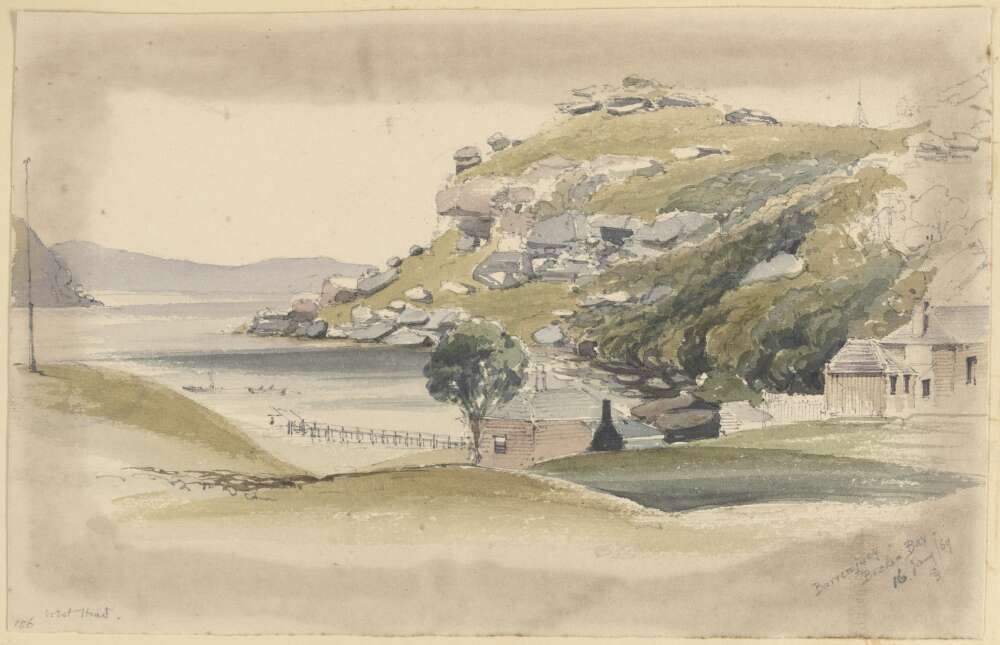
Barrenjuey [i.e. Barrenjoey], Broken Bay 1869 Jan. 16 by George Penkivil Slade. nla.pic-an6454687, courtesy National Library of Australia.
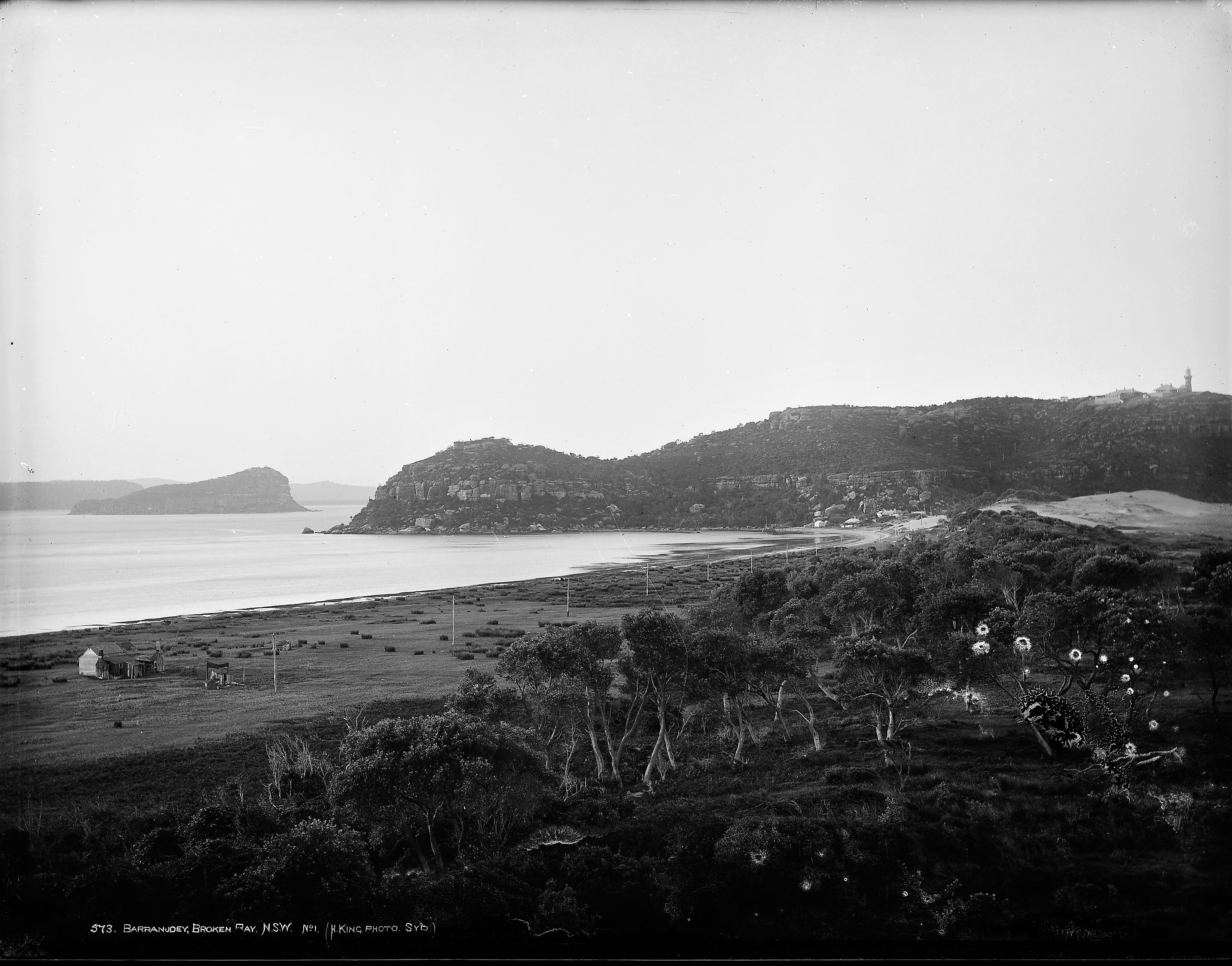
'Barranjoey' by Henry King, circa 1880, photo courtesy Powerhouse Museum - and section from:
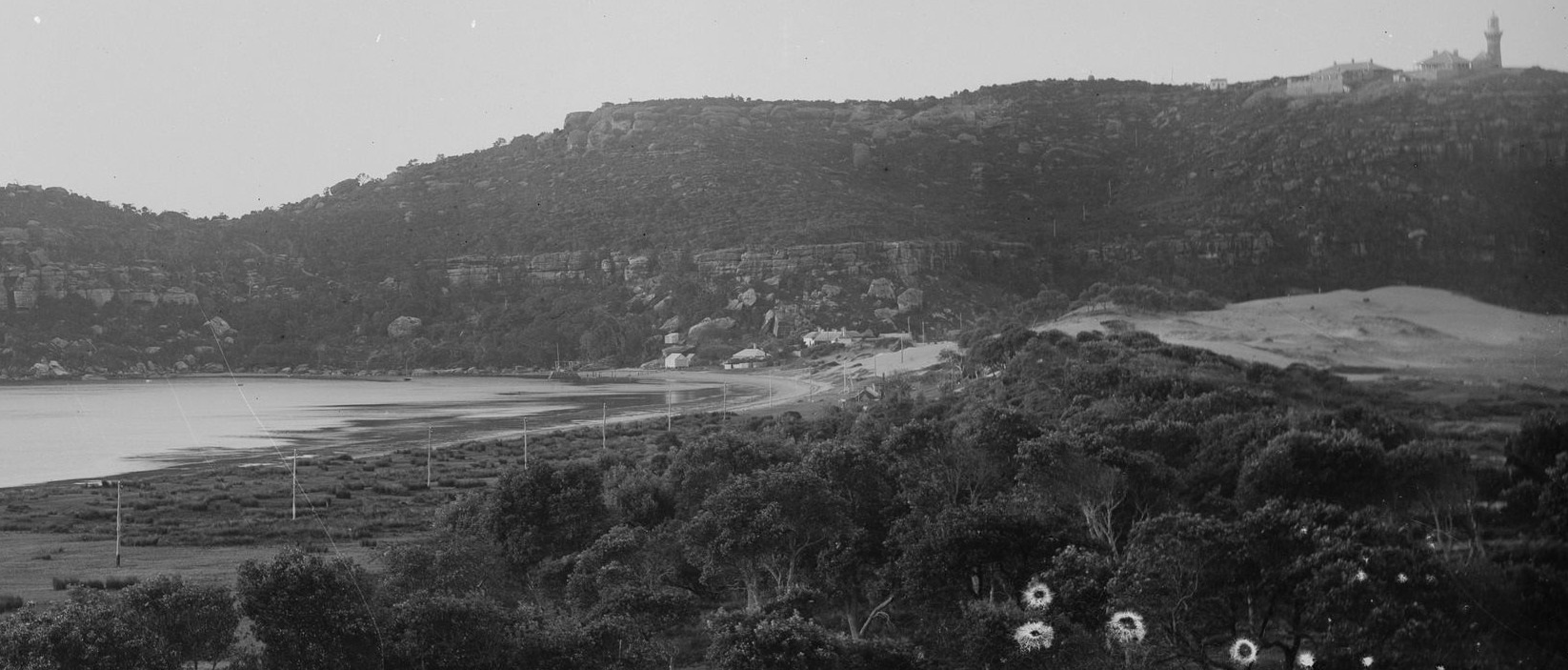
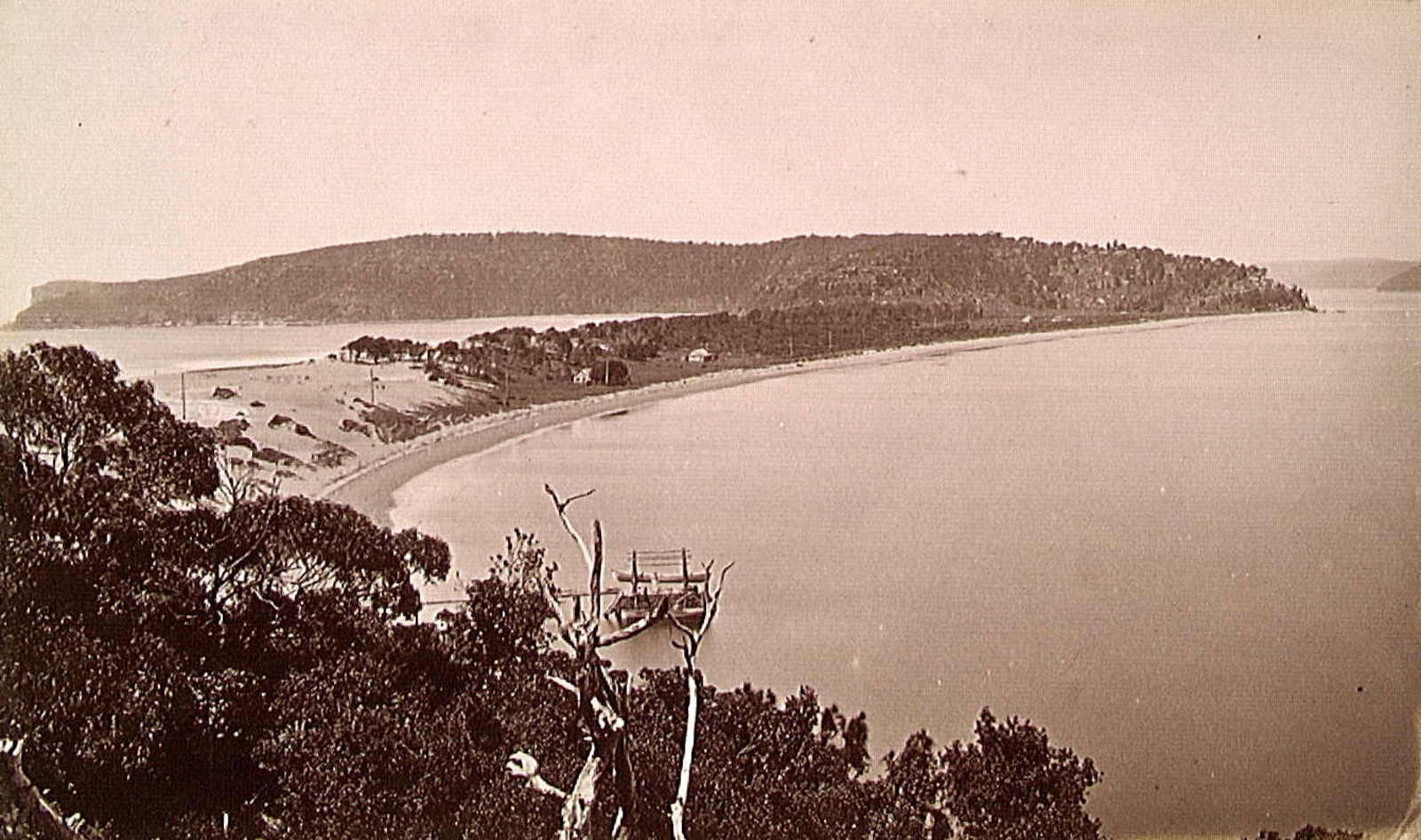
Broken Bay. Date(s) of creation:1889. Charles Potter 1889. Image No: mp000367. Courtesy State Library of Victoria
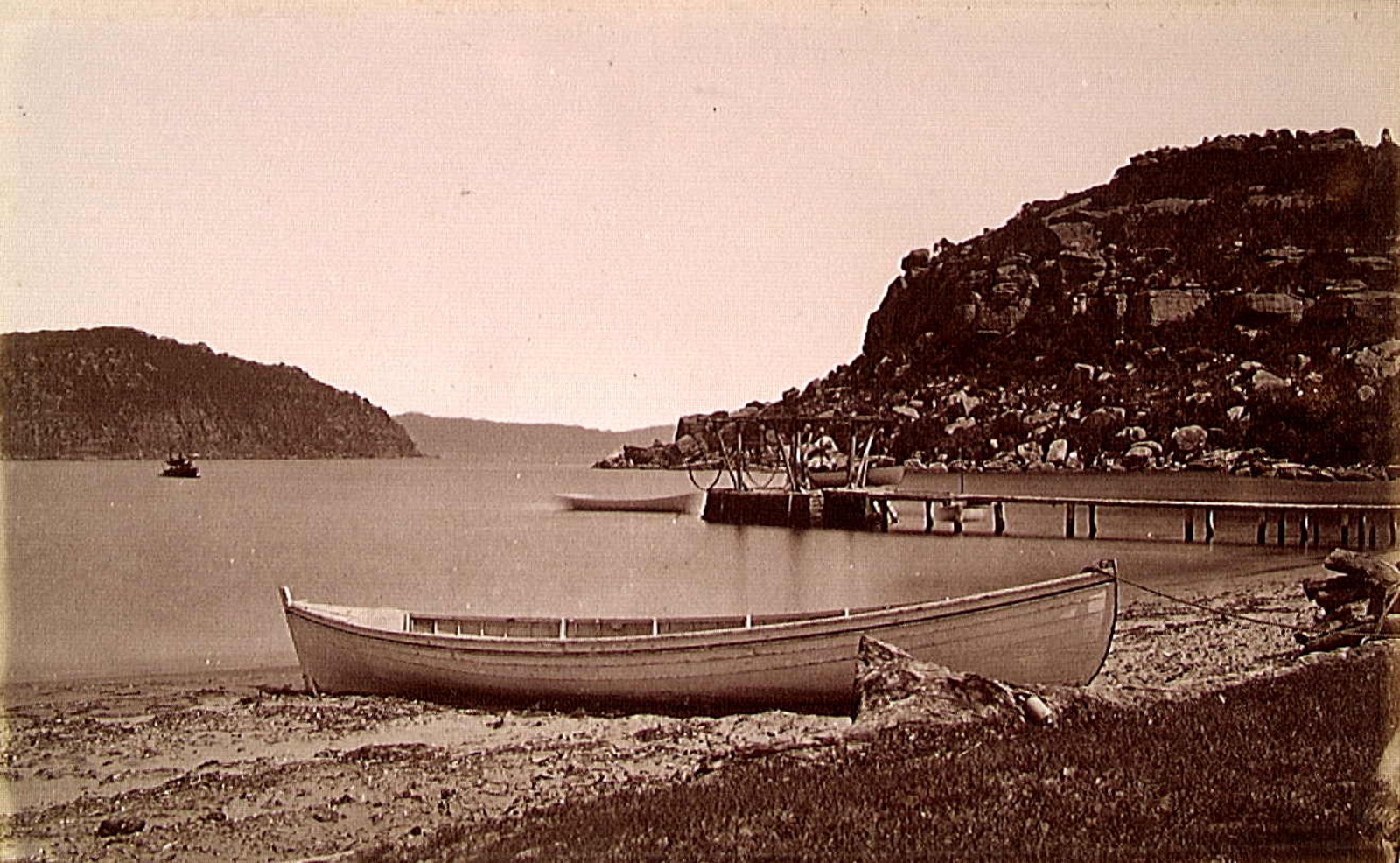
Broken Bay. Date(s) of creation:1889. by Charles Potter 1889. Image No:FL15796563. Courtesy State Library of Victoria

Broken Bay Customs Station at Barrenjoey, circa 1900, photo courtesy Australian National Archives

Barrenjoey headland circa 1900-1910, photo courtesy NSW State Records and Archives.

Barren Joey Lighthouse (Burrin Ju) [picture]. A. J. Vogan (Arthur James), 1859-1948,[ca. 1910 - ca. 1915] Image H82.254/8/34, courtesy State Library of Victoria.
Government Opens Up Sydney New Year's Eve Premium Vantage Points For The Public
.jpg?timestamp=1694157614358)
Celebrating Excellence And Achievement In NSW Public Education 2023
- Minister’s Award for Excellence in Student Achievement
- Minister’s Award for Excellence in Teaching
- Secretary’s Award for Excellent Service
- Secretary’s Award for an Outstanding School Initiative
- Secretary’s School Achievement Award
- Public School Parent of the Year.
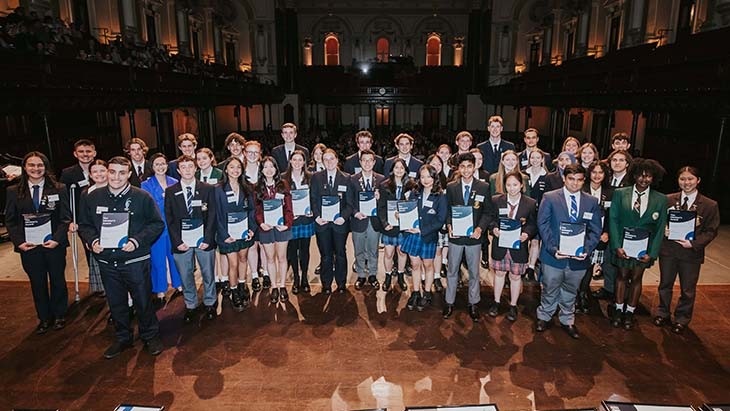
Local Recipients Of Awards:
8 Student-Backed Study Tips To Help You Tackle The HSC
By University of Sydney: Last updated 6 July 2023
Our students have been through their fair share of exams and learned a lot of great study tactics along the way. Here they share their top study tips to survive and thrive during exam time.
1. Start your day right
Take care of your wellbeing first thing in the morning so you can dive into your day with a clear mind.
“If you win the morning, you can win the day,” says Juris Doctor student Vee Koloamatangi-Lamipeti.
An active start is a great way to set yourself up for a productive day. Begin your morning with exercise or a gentle walk, squeeze in 10 minutes of meditation and enjoy a healthy breakfast before you settle into study.
2. Schedule your study
“Setting up a schedule will help you organise your time so much better,” says Master of Teaching student Wesley Lai.
Setting a goal or a theme for each study block will help you to stay focused, while devoting time across a variety of subjects will ensure you've covered off as much as possible. Remember to keep your schedule realistic and avoid over-committing your time.
Adds Wesley, “Make sure to schedule in some free time for yourself as well!”
3. Keep it consistent
“Make studying a habit,” recommends Alvin Chung, who is currently undertaking a Bachelor of Arts and Bachelor of Laws.
With enough time and commitment, sitting down to study will start to feel like second nature rather than a chore.
“Do it every day and you’ll be less likely to procrastinate because it’s part of your life’s daily motions,” says Alvin.
4. Maintain motivation
Revising an entire year of learning can seem like an insurmountable task, which is why it’s so important to break down your priorities and set easy-to-achieve goals.
“I like to make a realistic to-do list where I break down big tasks into smaller chunks,” says Bachelor of Arts and Advanced Studies student Dannii Hudec.
“It’s also really important to reward yourself after you complete each task to keep yourself motivated.”
Treat yourself after each study block with something to look forward to, such as a cup of tea, a walk in the park with a friend or an episode of your latest Netflix obsession.
5. Minimise distractions
With so many distractions at our fingertips, it can be hard to focus on the task at hand. If you find yourself easily distracted, an “out of sight, out of mind” approach might do the trick.
“What helps me is to block social media on my laptop. I put my phone outside of my room when I study, or I give it to my sister or a friend to hide,” says Bachelor of Commerce and Bachelor of Laws student Caitlin Douglas.
While parting ways with your phone for a few hours may seem horrifying, it can be an incredibly effective way to stay on task.
“It really helps me to smash out the work and get my tasks done,” affirms Caitlin.
6. Beware of burnout
Think of the HSC period as a marathon rather than a sprint. It might be tempting to cram every single day but pacing out your study time will help to preserve your endurance.
“Don’t do the work for tomorrow if you finish today’s work early,” suggests Daniel Kim, who is currently undertaking a Bachelor of Commerce and Advanced Studies.
“Enjoy the rest of your day and save the energy for tomorrow,” he recommends.
Savouring your downtime will help you to avoid burning out before hitting the finish line.
7. Get a good night's sleep
Sleep is one of your greatest allies during exam season.
“I’ve found that a good night’s sleep always helps with concentration and memory consolidation,” says Bachelor of Science (Medical Science) student Yasodara Puhule-Gamayalage.
We all know we need to be getting around 8 hours of sleep a night to perform at our best, but did you know the quality of sleep also matters? You can help improve the quality of your sleep with some simple tweaks to your bedtime routine.
“Avoid caffeine in the 6 hours leading up to sleep, turn off screens an hour before going to bed, and go to bed at the same time every night,” suggests Yasodara.
8. Be kind to yourself
With exam dates looming and stress levels rising, chances are high that you might have a bad day (or a few!) during the HSC period.
According to Bachelor of Arts and Advanced Studies student Amy Cooper, the best way to handle those bad days is to show yourself some kindness.
“I know that if I’m in a bad state of mind or having a bad day, I’m not going to be able to produce work that I’m proud of,” she says.
For Amy, the remedy for a bad day is to take some time to rest and reset.
“It’s much more productive in the long run for me to go away, do some things I love, and come back with a fresh mind.”
Immerse yourself in a mentally nourishing activity such as going for a bushwalk, cooking your favourite meal, or getting stuck into a craft activity.
If you feel completely overwhelmed, know you're not alone. Reach out to a friend, family member or teacher for a chat when you need support.
There are also HSC Help resources available at: education.nsw.gov.au/student-wellbeing/stay-healthy-hsc
Wednesday 11 October, 2023: HSC written exams start.
School Leavers Support
- Download or explore the SLIK here to help guide Your Career.
- School Leavers Information Kit (PDF 5.2MB).
- School Leavers Information Kit (DOCX 0.9MB).
- The SLIK has also been translated into additional languages.
- Download our information booklets if you are rural, regional and remote, Aboriginal or Torres Strait Islander, or living with disability.
- Support for Regional, Rural and Remote School Leavers (PDF 2MB).
- Support for Regional, Rural and Remote School Leavers (DOCX 0.9MB).
- Support for Aboriginal and/or Torres Strait Islander School Leavers (PDF 2MB).
- Support for Aboriginal and/or Torres Strait Islander School Leavers (DOCX 1.1MB).
- Support for School Leavers with Disability (PDF 2MB).
- Support for School Leavers with Disability (DOCX 0.9MB).
- Download the Parents and Guardian’s Guide for School Leavers, which summarises the resources and information available to help you explore all the education, training, and work options available to your young person.
School Leavers Information Service
- navigate the School Leavers Information Kit (SLIK),
- access and use the Your Career website and tools; and
- find relevant support services if needed.
Word Of The Week: Irrefutable
Adjective
1. impossible to deny or disprove. 2. impossible to prove wrong
From early 17th century 1610's: from late Latin irrefutabilis, from in- ‘not’ + refutabilis (from refutare ‘repel, rebut’).
Compare Refute (verb) from 1510s, "refuse, reject" someone or something, a sense now obsolete, from French réfuter (16c.) and directly from Latin refutare "to drive back; rebut, disprove; to repress, repel, resist, oppose," from re- "back" (see re-) + futare "to beat"
Virtual reality is helping Olkola Traditional Owners get back on Country
Hannah Robertson, The University of Melbourne; Deb Symonds, Indigenous Knowledge; Melissa Iraheta, The University of Melbourne; Rochus Urban Hinkel, The University of Melbourne, and Uncle Mike Ross, Indigenous KnowledgeThe Olkola people from Queensland’s very remote Cape York Peninsula gained their land back through a native title claim in 2014. Since then, they have undertaken land management using traditional fire techniques, habitat protection and restoration and cultural tourism.
The Olkola are in the process of building a Cultural Knowledge Centre on their Country. The centre will support the Olkola people’s practices and showcase their culture to the world. During the Cultural Knowledge Centre design process, the Olkola identified the need to find, repatriate, document and share their cultural stories and archives.
In support of this vision, they formed the Traditional Owner-led project, Getting Back on Country. The project is led by the Olkola Aboriginal Corporation and the Olkola Rangers in collaboration with researchers at the University of Melbourne, including authors Hannah Robertson and Rochus Urban Hinkel.
In partnership with the researchers, the Olkola are using digital technologies including virtual reality and augmented reality to capture their cultural stories. These digitised stories, as well as Olkola artefacts, are to be kept and shared at the Cultural Knowledge Centre.
These digital technologies will also help to bring Country to Olkola Traditional Owners with dementia or disabilities who are unable to travel to Country.
Nukakurra: A New Way To Visit Country
This is important work for Olkola people. Today we have a lot of people who can’t move, are in hospital or can’t get back on Country. We want to take Country back to them, so if they’re lying in a hospital bed, they’re lonely and nobody’s visiting, they’ve got something there that can take them back on Country and remind them where they came from. We believe this will be a healing medicine for people.
To realise this vision, we decided to create the Getting Back on Country Project. We began our collaboration by focusing on the Nukakurra Walking Trail as a pilot process for creating a digital cultural story.
Nukakurra is a cultural story place with a loop walk that passes several Olkola significant sites. Some of the sites in Nukakurra include the Blue Tongue Lizard dreaming site, an old Olkola campground and the Crocodile dreaming site. These dreaming sites are sacred to Olkola people because they are the creation places of these animal spirits which continue to walk across Olkola Country.
Author Melissa Iraheta and University of Melbourne researcher Mitch Ransome travelled to Olkola Country with the Olkola Rangers to document Nukakurra. Using 360-degree microphones and cameras, Lidar scanners (a laser used for determining distances between objects that can be used to create 3D landscapes), photogrammetry (which involves collecting overlapping images to build 2D or 3D models) and drones, they spent a week documenting the key sites.
Robertson and Uncle Mike Ross then travelled to Olkola Country with Olkola Elder Uncle Jack Lowdown and other senior elders to document the cultural story audio for Nukakurra in both English and Olkol using a 360-degree microphone.
This process highlighted the power of yarning and the connections between the sites of significance. Uncle Mike created a new story of a grandfather and grandmother walking the Country and passing the sites with their grandchildren and sharing their knowledge as they did – just as it would have happened in the old world prior to colonisation.
The process also highlighted the limitations of the technologies in the remote context, with cameras overheating and the 360-degree microphone struggling to capture audio while walking. Now we have these stories, the final stitching of the Nukakurra cultural story place experience is being developed as a 360-degree film experience.
The Importance Of Preserving Story
The pilot digital experiences for the Nukakurra Olkola cultural story place are still in development. In May, three generations of Olkola people shared their experiences of working with the University of Melbourne on the Getting Back on Country and Olkola Cultural Knowledge Centre projects.
During this yarn, Olkola woman and project manager for the Olkola Aboriginal Corporation, Katherine Samuel, reflected on the data collection process:
[Uncle Mike] saying welcome [to Nukakurra] in English and Uncle Jack saying it in [Olkol] language and Mitch holding the 3D camera and collecting all that data, it was so much. And when they came up March this year, Grandad Mike put on the VR goggles, wow it was so cool. To be able to sit in the office and feel like you were there. It was really cool; we were able to collect data with multiple technologies.
There are hopes to continue to expand the collaboration with the Olkola in a larger project. We aim to encompass multiple cultural story sites and find and repatriate Olkola cultural archives. It is our hope this can provide a process for other traditional owner groups to explore and preserve their respective stories on their own Country.
We wish to acknowledge the contributions of all of the Olkola people involved in this project. In particular, we would like to acknowledge Olkola woman Katherine Samuel of the Olkola Aboriginal Corporation, Olkola elder Uncle Jack Lowdown and Mitch Ransome from the University of Melbourne for their contributions.![]()
Hannah Robertson, ARC DECRA Fellow & Senior Lecturer in Construction Management, Faculty of Architecture, Building and Planning, The University of Melbourne; Deb Symonds, Senior Olkola woman and the CEO of the Olkola Aboriginal Corporation, Indigenous Knowledge; Melissa Iraheta, Melbourne School of Design, The University of Melbourne; Rochus Urban Hinkel, Associate Professor in Architecture and Design, The University of Melbourne, and Uncle Mike Ross, Olkola elder and Chairman of the Olkola Aboriginal Corporation, Indigenous Knowledge
This article is republished from The Conversation under a Creative Commons license. Read the original article.
Ever wonder how your body turns food into fuel? We tracked atoms to find out

Inside our bodies at every moment, our cells are orchestrating a complex dance of atoms and molecules that uses energy to create, distribute and deploy the substances on which our lives depend.
And it’s not just in our bodies: all animals carry out this dance of metabolism, and it turns out none of them do it quite the same way.
In new research published in Science Advances, we analysed specific carbon atoms in amino acids – the building blocks of proteins – to discover distinctive fingerprints of the metabolism of different species.
These fingerprints reveal how different creatures meet the demands of survival, growth and reproduction – and offer a whole new way to understand metabolism in unprecedented detail.
A More Detailed Picture
We have developed a new way to study metabolism – the chemical processes inside your body that keep you alive and functioning – that reveals much more detail than previous methods. Our new technique looks at isotopes inside amino acids to see how metabolism is working.
Isotopes are versions of the same chemical element with different masses. For example, the most common kind of carbon is carbon-12, but there is also an isotope called carbon-13 that is a little heavier. We can measure the ratio of heavy to light isotopes in biological molecules such as proteins to learn about the organism that produced them.
Traditionally, scientists would analyse the overall isotope ratio of the entire protein. This can reveal some information, particularly about what kinds of things an animal eats, but it is like averaging out a complex TV image into a single pixel of light – you lose all the detailed information.
More recently, scientists have been able to measure isotopes in each of the 20 individual amino acids that make up proteins. This is like having 20 dots of light – better, but still not very nuanced.
Our new method goes even further, by measuring isotopes in a particular carbon atom on each amino acid. It’s like seeing every pixel in the TV image, which gives us amazingly detailed metabolic info.
Finding The Right Carbon
We used a chemical called ninhydrin to chop off and isolate the carbon atom we wanted from each amino acid. We then sent these carbon atoms – from a very metabolically active part of the amino acid called the carboxyl group – through a machine called a mass spectrometer to read their isotope fingerprints.
This research began more than a decade ago, and developed into a collaborative project between Griffith University and Queensland Health. In 2018, working with colleagues in Japan, we were able to demonstrate that we could indeed use nihydrin to isolate the carbon atoms we wanted from amino acids.
The next stage was to combine our nihydrin technique with a process called high-performance liquid chromatography, which can separate out different kinds of amino acids.
In 2019, we were able to report position-specific isotope analysis for several different mammals. We found we could distinguish a clear metabolic “fingerprint” of each mammal.
The Four Phases Of Metabolism
In our latest work, we tested a broader range of animals including oysters, scallops, prawns, squid and fish. We found the patterns of isotopes in the amino acids could be tracked back to the biochemistry of mitochondria, the tiny energy-providing powerhouses in the cells of all animals and plants, as well as many other organisms.
We identified four distinct phases of metabolism: creating fats, destroying fats, creating proteins, and destroying proteins. Animals combine these phases in distinct ways to accomplish growth and reproduction.
For example, adult mammals use fats as a pantry to regulate their temperature, whereas adult prawns cannibalise their own proteins to make the fats they need for reproduction.
We also found that the humans we studied showed a very balanced, steady state metabolism, which is perhaps unsurprising given our generally stable and nutritious diets. Interestingly, this was quite similar to what we found in an oyster sample.
In this work, we studied individuals with generally normal metabolisms. Future applications might include studies of groups with abnormal metabolism such as cancer, obesity and starvation.
By peering deep into the isotopes of amino acids, we will be able to understand eukaryote metabolism like never before, in animals, plants and fungi.![]()
James Carter, Adjunct Research Fellow, Griffith University; Brian Fry, Emeritus Professor, Griffith University, and Kaitlyn O'Mara, Research Fellow, Australian Rivers Institute, Griffith University
This article is republished from The Conversation under a Creative Commons license. Read the original article.
Google turns 25: the search engine revolutionised how we access information, but will it survive AI?

Today marks an important milestone in the history of the internet: Google’s 25th birthday. With billions of search queries submitted each day, it’s difficult to remember how we ever lived without the search engine.
What was it about Google that led it to revolutionise information access? And will artificial intelligence (AI) make it obsolete, or enhance it?
Let’s look at how our access to information has changed through the decades – and where it might lead as advanced AI and Google Search become increasingly entwined.

1950s: Public Libraries As Community Hubs
In the years following the second world war, it became generally accepted that a successful post-war city was one that could provide civic capabilities – and that included open access to information.
So in the 1950s information in Western countries was primarily provided by local libraries. Librarians themselves were a kind of “human search engine”. They answered phone queries from businesses and responded to letters – helping people find information quickly and accurately.
Libraries were more than just a place to borrow books. They were where parents went to look for health information, where tourists requested travel tips, and where businesses sought marketing advice.
The searching was free, but required librarians’ support, as well as a significant amount of labour and catalogue-driven processes. Questions we can now solve in minutes took hours, days or even weeks to answer.
1990s: The Rise Of Paid Search Services
By the 1990s, libraries had expanded to include personal computers and online access to information services. Commercial search companies thrived as libraries could access information through expensive subscription services.
These systems were so complex that only trained specialists could search, with consumers paying for results. Dialog, developed at Lockheed Martin in the 1960s, remains one of the best examples. Today it claims to provide its customers access “to over 1.7 billion records across more than 140 databases of peer-reviewed literature”.

Another commercial search system, The Financial Times’ FT PROFILE, enabled access to articles in every UK broadsheet newspaper over a five-year period.
But searching with it wasn’t simple. Users had to remember typed commands to select a collection, using specific words to reduce the list of documents returned. Articles were ordered by date, leaving the reader to scan for the most relevant items.
FT PROFILE made valuable information rapidly accessible to people outside business circles, but at a high price. In the 1990s access cost £1.60 a minute – the equivalent of £4.65 (or A$9.00) today.
The Rise Of Google
Following the world wide web’s launch in 1993, the number of websites grew exponentially.
Libraries provided public web access, and services such as the State Library of Victoria’s Vicnet offered low-cost access for organisations. Librarians taught users to find information online and build websites. However, the complex search systems struggled with exploding volumes of content and high numbers of new users.
In 1994, the book Managing Gigabytes, penned by three New Zealand computer scientists, presented solutions for this problem. Since the 1950s researchers had imagined a search engine that was fast, accessible to all, and which sorted documents by relevance.
In the 1990s, a Silicon Valley startup began to apply this knowledge – Larry Page and Sergey Brin used the principles in Managing Gigabytes to design Google’s iconic architecture.
After launching on September 4 1998, the Google revolution was in motion. People loved the simplicity of the search box, as well as a novel presentation of results that summarised how the retrieved pages matched the query.
In terms of functionality, Google Search was effective for a few reasons. It used the innovative approach of delivering results by counting web links in a page (a process called PageRank). But more importantly, its algorithm was very sophisticated; it not only matched search queries with the text within a page, but also with other text linking to that page (this was called anchor text).
Google’s popularity quickly surpassed competitors such as AltaVista and Yahoo Search. With more than 85% of the market share today, it remains the most popular search engine.
As the web expanded, however, access costs were contested.
Although consumers now search Google for free, payment is required to download certain articles and books. Many consumers still rely on libraries – while libraries themselves struggle with the rising costs of purchasing material to provide to the public for free.
What Will The Next 25 Years Bring?
Google has expanded far beyond Search. Gmail, Google Drive, Google Calendar, Pixel devices and other services show Google’s reach is vast.
With the introduction of AI tools, including Google’s Bard and the recently announced Gemini (a direct competitor to ChatGPT), Google is set to revolutionise search once again.
As Google continues to roll generative AI capabilities into Search, it will become common to read a quick information summary at the top of the results page, rather than dig for information yourself. A key challenge will be ensuring people don’t become complacent to the point that they blindly trust the generated outputs.
Fact-checking against original sources will remain as important as ever. After all, we have seen generative AI tools such as ChatGPT make headlines due to “hallucinations” and misinformation.
If inaccurate or incomplete search summaries aren’t revised, or are further paraphrased and presented without source material, the misinformation problem will only get worse.
Moreover, even if AI tools revolutionise search, they may fail to revolutionise access. As the AI industry grows, we’re seeing a shift towards content only being accessible for a fee, or through paid subscriptions.
The rise of AI provides an opportunity to revisit the tensions between public access and increasingly powerful commercial entities.![]()
Mark Sanderson, Professor of Information Retrieval, RMIT University; Julian Thomas, Distinguished Professor of Media and Communications; Director, ARC Centre of Excellence for Automated Decision-Making and Society, RMIT University; Kieran Hegarty, Research Fellow (Automated Decision-Making Systems), RMIT University, and Lisa M. Given, Professor of Information Sciences & Director, Social Change Enabling Impact Platform, RMIT University
This article is republished from The Conversation under a Creative Commons license. Read the original article.
Fireflies, brain cells, dancers: new synchronisation research shows nature’s perfect timing is all about connections

Getting in sync can be exhilarating when you’re dancing in rhythm with other people or clapping along in an audience. Fireflies too know the joy of synchronisation, timing their flashes together to create a larger display to attract mates.
Synchronisation is important at a more basic level in our bodies, too. Our heart cells all beat together (at least when things are going well), and synchronised electrical waves can help coordinate brain regions – but too much synchronisation of brain cells is what happens in an epileptic seizure.
Sync most often emerges spontaneously rather than through following the lead of some central timekeeper. How does this happen? What is it about a system that determines whether sync will emerge, and how strong it will be?
In new research published in Proceedings of the National Academy of Sciences, we show how the strength of synchronisation in a network depends on the structure of the connections between its members – whether they be brain cells, fireflies, or groups of dancers.
The Science Of Sync
Scientists originally became interested in sync to understand the inner workings of natural systems. We have also become interested in designing sync as a desired behaviour in human-made systems such as power grids (to keep them in phase).
Mathematicians can analyse sync by treating the individuals in the system as “coupled oscillators”. An oscillator is something that periodically repeats the same pattern of activity, like the sequence of steps in a repetitive dance, and coupled oscillators are ones that can influence each other’s behaviour.
It can be useful to measure whether a system of oscillators can synchronise their actions, and how strong that synchronisation would be. Strength of synchronisation means how well the sync can recover from disturbances.
Take a group dance, for example. A disturbance might be one person starting to get some steps wrong. The person might quickly recover by watching their friends, they might throw their friends off for a few steps before everyone recovers, or in the worst case it might just cause chaos.
Synced Systems Are Strong But Hard To Unravel
Two factors make it difficult to determine how strong the synchronisation in a set of coupled oscillators could be.
First, it’s rare for a single oscillator to be in charge and telling everyone else what to do. In our dance example, that means there’s neither music nor lead dancers to set the tempo.
And second, usually each oscillator is only connected to a few others in the system. So each dancer can only see and react to a few others, and everyone is taking their cues from a completely different set of dancers.

This is the case in the brain, for example, where there is a complex network structure of connections between different regions.
Real complex systems like this, where there is no central guiding signal and oscillators are connected in a complex network, are very robust to damage and adaptable to change, and can more easily scale to different sizes.
Stronger Sync Comes From More Wandering Walks
One drawback of such complicated systems is for scientists, as they are mathematically difficult to come to grips with. However, our new research has made a significant advance on this front.
We have shown how the network structure connecting a set of oscillators controls how well they can synchronise. The quality of sync depends on “walks” on a network, which are sequences of hops between connected oscillators or nodes.
Our maths examines what are called “paired walks”. If you start at one node and take two walks with randomly chosen next hops for a specific number of hops, the two walks might end up at the same node (these are convergent walks) or at different nodes (divergent walks).
We found that the more often paired walks on a network were convergent rather than divergent, the worse the synchronisation on the network would be.
When more paired walks are convergent, disturbances tend to be reinforced.
In our dancing example, one person making the wrong steps might lead some neighbours astray, who may then lead some of their neighbours astray and so on.
These chains of potential disturbances are like walks on the network. When those disturbances propagate through multiple neighbours and then converge on one person, that person is going to be much more likely to copy the out-of-sync moves than if only one of their neighbours was offbeat.
Social Networks, Power Grids And Beyond
So networks with many convergent walks are prone to poorer synchronisation. This is good news for the brain avoiding epilepsy, as its highly modular structure brings a high proportion of convergent walks.
We can see this reflected in the echo chamber phenomenon in social media. Tightly coupled subgroups reinforcing their own messages can synchronise themselves well, but may fall far out of step with the wider population.
Our results bring a new understanding to how synchronisation functions in different natural network structures. It opens new opportunities in terms of designing network structures or interventions on networks, either to aid synchronisation (in power grids, say) or to avoid synchronisation (say in the brain).
More widely, it represents a major step forward in our understanding of how the structure of complex networks affects their behaviour and capabilities. ![]()
Joseph Lizier, Associate Professor of Complex Systems, University of Sydney
This article is republished from The Conversation under a Creative Commons license. Read the original article.
How did plants first evolve into all different shapes and sizes? We mapped a billion years of plant history to find out
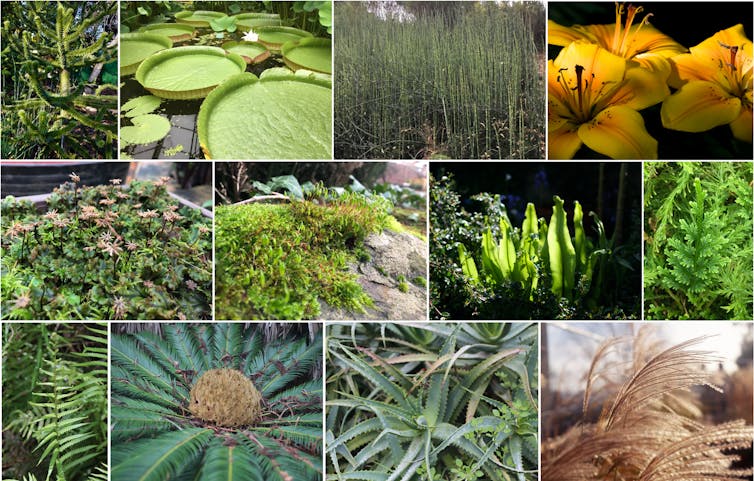
Plants range from simple seaweeds and single-celled pond scum, through to mosses, ferns and huge trees. Palaeontologists like us have long debated exactly how this diverse range of shapes and sizes emerged, and whether plants emerged from algae into multicellular and three-dimensional forms in a gradual flowering or one big bang.
To answer this question, scientists turned to the fossil record. From those best-preserved examples, like trilobites, ammonites and sea urchins, they have invariably concluded that a group’s range of biological designs is achieved during the earliest periods in its evolutionary history. In turn, this has led to hypotheses that evolutionary lineages have a higher capacity for innovation early on and, after this first phase of exuberance, they stick with what they know. This even applies to us: all the different placental mammals evolved from a common ancestor surprisingly quickly. Is the same true of the plant kingdom?
In our new study, we sought to answer this question by looking for certain traits in each major plant group. These traits ranged from the fundamental characteristics of plants – the presence of roots, leaves or flowers – to fine details that describe the variation and ornamentation of each pollen grain. In total, we collected data on 548 traits from more than 400 living and fossil plants, amounting to more than 130,000 individual observations.
We then analysed all this data, grouping plants based on their overall similarities and differences, all plotted within what can be thought of as a “design space”. Since we know the evolutionary relationships between the species, we can also predict the traits of their extinct shared ancestors and include these hypothetical ancestors within the design space, too.
For example, we will never find fossils of the ancestral flowering plant, but we know from its closest living descendants that it was bisexual, radially symmetric, with more than five spirally arranged carpels (the ovule-bearing female reproductive part of a flower). Together, data points from living species, fossils and predicted ancestors reveal how plant life has navigated design space through evolutionary history and over geological time.
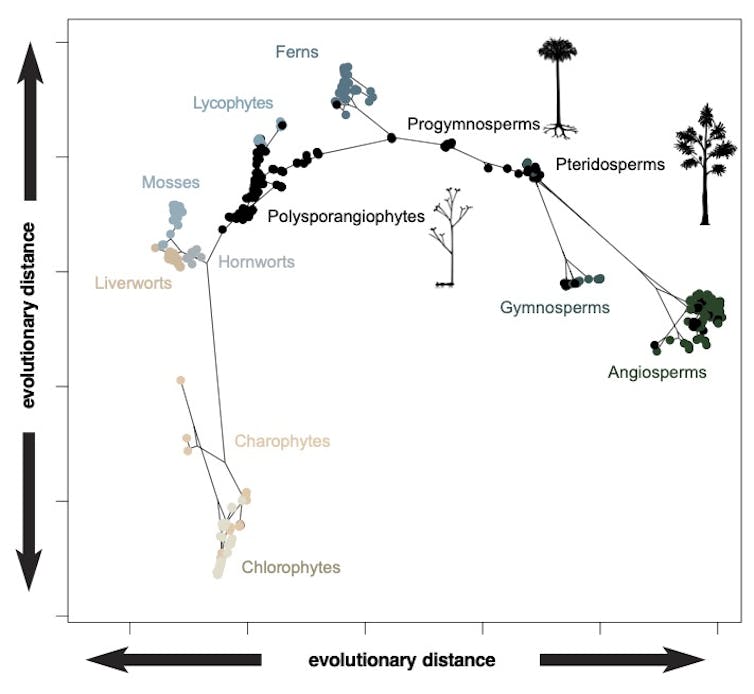
We expected flowering plants to dominate the design space since they make up more than 80% of plant species, but they don’t. In fact, the living bryophytes – mosses, liverworts and hornworts – achieve almost as much variety in their body forms.
This may not be entirely surprising since the three lineages of bryophytes have been doing their own thing for more than three times as long as flowering plants. And despite their diminutive nature, even the humble mosses are extraordinarily complex and diverse when viewed through a microscope.
The evolutionary relationships conveyed by the branching genealogy in the above plot show that there is, generally, a structure to the occupation of design space – as new groups have emerged, they have expanded into new regions. However, there is some evidence for convergence, too, with some groups like the living gymnosperms (conifers and allies) and flowering plants plotting closer together than they do to their common ancestor.
Nevertheless, some of the distinctiveness of the different groupings in design space is clearly the result of extinction. This is clear if we consider the distribution of the fossil species (black dots in the above figure) that often occur between the clusters of living species (coloured dots in the figure).
So How Did Plant Body Plan Diversity Evolve?
Overall, the broad pattern is one of progressive exploration of new designs as a result of innovations that are usually associated with reproduction, like the embryo, spore, seed and flower. These represent the evolutionary solutions to the environmental challenges faced by plants in their progressive occupation of increasingly dry and challenging niches on the land surface. For example, the innovation of seeds allowed the plants that bear them to reproduce even in the absence of water.

Over geological time, these expansions occur as episodic pulses, associated with the emergence of these reproductive innovations. The drivers of plant anatomical evolution appear to be a combination of genomic potential and environmental opportunity.
Plant Disparity Suggests That The Big Bang Is A Bust
None of this fits with the expectation that evolutionary lineages start out innovative before becoming exhausted. Instead, it seems fundamental forms of plants have emerged hierarchically through evolutionary history, elaborating on the anatomical chassis inherited from their ancestors. They have not lost their capacity for innovation over the billion or more years of their evolutionary longevity.
So does that make plants different from animals, studies of which are the basis for the expectation of early evolutionary innovation and exhaustion? Not at all. Comparable studies that we have done on animals and fungi show that, when you study these multicellular kingdoms in their entirety, they all exhibit a pattern of episodically increasing anatomically variety. Individual lineages may soon exhaust themselves but, overall, the kingdoms keep on innovating.
This suggests a general pattern for evolutionary innovation in multicellular kingdoms and also that animals, fungi and plants still have plenty of evolutionary juice in their tanks. Let’s hope we’re still around to see what innovation arises next.![]()
Philip C J Donoghue, Professor of Palaeobiology, University of Bristol; James Clark, Research Associate, School of Biological Sciences, University of Bristol, and Sandy Hetherington, Plant Evolutionary Biologist, The University of Edinburgh
This article is republished from The Conversation under a Creative Commons license. Read the original article.
How linguists are unlocking the meanings of Shakespeare’s words using numbers

Today it would seem odd to describe a flower with the word “bastard” – why apply a term of personal abuse to a flower? But in Shakespeare’s time, “bastard” was a technical term describing certain plants.
Similarly, associating the word “bad” with success and talking of a “bad success” would be decidedly odd today. But it was not unusual then, when success meant outcome, which could be good or bad.
Corpus linguistics is a branch of linguistics which uses computers to explore the use of words in huge collections of language. It can spot nuances that might be overlooked by linguists working manually, or large patterns that a lifetime of studying may not reveal. And numbers, counts of words and keeping track of where the words are occurring, are key.
In my experience at conferences and the like, talk of numbers is not unanimously well received in the world of literary studies. Numbers are sometimes perceived as being reductive, or inappropriate when discussing creative works, or only accessible to specialists.
Yet, describing any pattern involves numbers. In the first paragraph above, I used the words “normal”, “odd” and “unusual” as soft ways of describing frequencies – the numbers of occurrences (think also of, for example, “unique”, “rare”, “common”).
Even talking about “associations” involves numbers. Often associations evolve from an unusually high number of encounters amongst two or more things. And numbers help us to see things.
Changing Meanings
Along with my team at Lancaster University, I have used computers to examine some 20,000 words gleaned from a million-word corpus (a collection of written texts) of Shakespeare’s plays, resulting in a new kind of dictionary.
People have created Shakespeare dictionaries before, but this is the first to use the full armoury of corpus techniques and the first to be comparative. It not only looks at words inside Shakespeare’s plays, but also compares them with a matching million-word corpus of contemporary early modern plays, along with huge corpus of 320 million words of various writings of the period.
Of course, words in early modern England had lives outside Shakespeare. “Bastard” was generally a term for a hybrid plant, occurring in technical texts on horticulture.
It could be, and very occasionally was, used for personal abuse, as in King Lear, where Edmund is referred to as a “bastard”. But this is no general term of abuse, let alone banter, as you might see it used today. It is a pointed attack on him being of illegitimate parentage, genetically hybrid, suspect at his core.
The word “bad” is not now associated with the word “success”, yet 400 years ago it was, as were other negative words, including “disastrous”, “unfortunate”, “ill”, “unhappy” and “unlucky”.
We can tap into a word’s associations by examining its collocates, that is, words with which it tends to occur (rather like we make judgements about people partly on the basis of the company they keep). In this way we can see that the meaning of “success” was “outcome” and that outcome, given its collocates, could be good or bad.

Highly Frequent Words
We can use intuition to guess some word patterns. It’s no surprise that in early modern English, the word “wicked” occurred very frequently in religious texts of the time. But less intuitively, so did “ourselves”, a word associated with sermons and plays, both of which have in common a habit of making statements about people on earth.
Highly frequent words, so often excluded by historical dictionaries and reference works, are often short words that seem insignificant. They have a wood-for-trees problem.
Yet corpus techniques highlight the interesting patterns. It turns out that a frequent sense of the humble preposition “by” is religious: to reinforce the sincerity of a statement by invoking the divine (for example, “by God”).
Numbers can also reveal what is happening inside Shakespeare’s works. Frequent words such as “alas” or “ah” are revealed to be heavily used by Shakespeare’s female characters, showing that they do the emotional work of lamentation in the plays, especially his histories.
Infrequent Words
What of the infrequent? Words that occur only once in Shakespeare – so-called hapax legomena – are nuggets of interest. The single case of “bone-ache” in Troilus and Cressida evokes the horrifying torture that syphilis, which it applies to, would have been. In contrast, “ear-kissing” in King Lear is Shakespeare’s rather more pleasant and creative metaphor for whispering (interestingly, other writers used it for the notion of flattering).
Another group of interesting infrequent words concerns words that seem to have their earliest occurrence in Shakespeare. Corpus techniques allowed us to navigate the troubled waters of spelling variation. Before spelling standardisation, searching for the word “sweet”, for instance, would miss cases spelt “sweete”, “swete” or “svveet”.
In this way, we can better establish whether a word written by a writer really is the earliest instance. Shakespearean firsts include the rather boring “branchless” (Antony and Cleopatra), a word probably not coined by Shakespeare but merely first recorded in his text. But there is also the more creative “ear-piercing” (Othello) and the distinctly modern-sounding “self-harming” (The Comedy of Errors and Richard II).
Why are these advances in historical corpus linguistics happening now? Much of the technology to produce these findings was not in place until relatively recently.
Programs to deal with spelling variation (such as Vard) or to analyse vast collections of electronic texts in sophisticated ways (such as CQPweb), to say nothing of the vast quantities of computer-readable early modern language data (such as EEBO-TCP), have only been widely used in the last ten or so years. We are therefore on the cusp of a significant increase in our understanding and appreciation of major writers such as Shakespeare.
Looking for something good? Cut through the noise with a carefully curated selection of the latest releases, live events and exhibitions, straight to your inbox every fortnight, on Fridays. Sign up here.![]()
Jonathan Culpeper, Chair professor in English Language and Linguistics, Lancaster University
This article is republished from The Conversation under a Creative Commons license. Read the original article.
What is geospatial intelligence? A geographer explains the powerful melding of maps and data

With record-breaking temperatures across the South, smoke from Canadian wildfires across the North, historic flooding in the Northeast and a powerful hurricane in the Southeast, the summer of 2023 has presented a range of threats to the safety of the majority of Americans. The good news, through all of this: Geospatial intelligence has offered valuable insights to help governments and organizations protect communities.
Geospatial intelligence is the collection and integration of data from a network of technologies, including satellites, mobile sensors, ground-control stations and aerial images. The data is used to produce real-time maps and simulations to help identify when, where and to what extent a threat is likely to emerge. Government officials, individuals or both can use this information to make informed decisions.
Disasters Sudden And Slow
One long-standing contribution of geospatial intelligence is in emergency preparedness and response. For example, the National Hurricane Center actively monitors the location, formation and trajectory of tropical cyclones. Detailed information on the timing, location and strength of a given hurricane helps officials distribute resources and personnel, as well as issue storm warnings and evacuation orders.
Geospatial intelligence also provides valuable guidance for search-and-rescue and recovery efforts following a disaster. For example, in the immediate aftermath of the February 2023 7.8 magnitude earthquake that struck Turkey and Syria, maps and aerial images quickly identified the extent of damage and the populations affected. In addition, they helped first responders locate access points in the transportation network to rescue survivors, set up aid stations and provide emergency supplies.
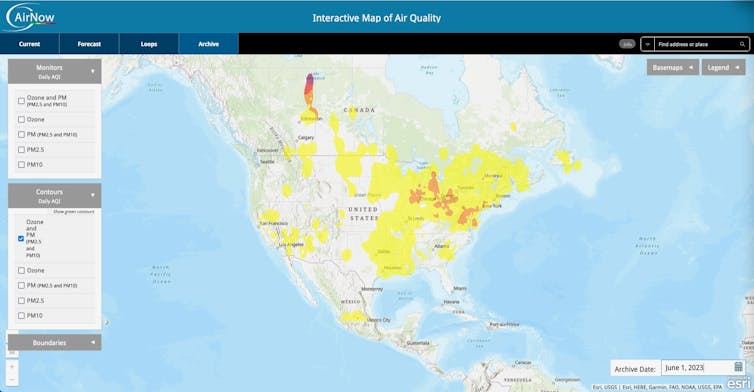
Another use of geospatial intelligence is environmental monitoring. A stable environment is essential for human health and security. Monitoring temperature, precipitation, snowpack and polar ice helps scientists and government officials anticipate and prepare for potential disturbances.
For instance, understanding temperature profiles – past, current and forecasted temperatures over an area – provides information on when, where and to what extent that area is likely to be affected by events such as heat waves. Heat waves often result in human suffering, increased energy demands and crop damage. With climate change intensifying extreme weather events, there is likely to be a corresponding increase in threats to human safety and security.
Military And Civilian Logistics
The Russian-Ukraine war is another area where geospatial intelligence has made contributions. Maxar Technologies, a commercial satellite imagery company, was the first to report the 40-mile-long convoy of Russian ground forces heading toward Kyiv in February 2022.
While governments historically could choose whether to release intelligence-related information, commercial satellite companies now play a vital role in providing this type of information to the public. In this way, geospatial intelligence represents an extension of the free press.
Another use of geospatial intelligence is in transportation, logistics and global supply chains. The global economy runs on GPS, which generates spatial data. GPS provides governments, businesses and people with detailed information on the time, location and destination of ships and cargo. This leads to greater efficiency and more consistent and reliable operations.
Geospatial intelligence is also helping with the rollout of autonomous vehicles. Using high-resolution imagery of about a foot (30 cm) per pixel, city planners and engineers are able to detect markings and features on the ground such as bicycle lanes and traffic direction. These advances help planners build safer, smarter, more efficient and better connected communities.
Yet another use of geospatial intelligence is contributing to the development, implementation and evaluation of digital twins. Digital twins are virtual representations of real systems – buildings or cities, for example – that mimic the systems’ characteristics and can be updated in real time to reflect changing conditions in the systems.
Digital twins are being used in many civilian and military settings to improve decision making. They are useful for modeling changes and predicting outcomes. Digital twins have been highly effective in conflict settings by simulating weather and terrain to help militaries and peacekeepers develop and enact strategies.
Growing Need
The need for geospatial intelligence is more important than ever. Average temperature is projected to increase between 2 to 9.7 degrees Fahrenheit (1.1 to 5.4 degrees Celsius) by the end of the century. The global population is expected to reach 11 billion by 2100, and urban areas are becoming denser and more prone to disasters. Whether reconstructing the past, describing the present or anticipating the future, geospatial intelligence provides valuable information to help keep people and communities safe.
Not surprisingly, the geospatial intelligence industry is projected to grow from a US$61 billion enterprise in 2020 to more than $209 billion in 2030. The world is rapidly transforming, and geospatial intelligence is positioned to play an increasingly important role in working toward a safe, stable and informed future.![]()
Darren Ruddell, Associate Professor of Spatial Sciences, University of Southern California
This article is republished from The Conversation under a Creative Commons license. Read the original article.
Retired Police Officers Day 2023: At Mona Vale Police Station
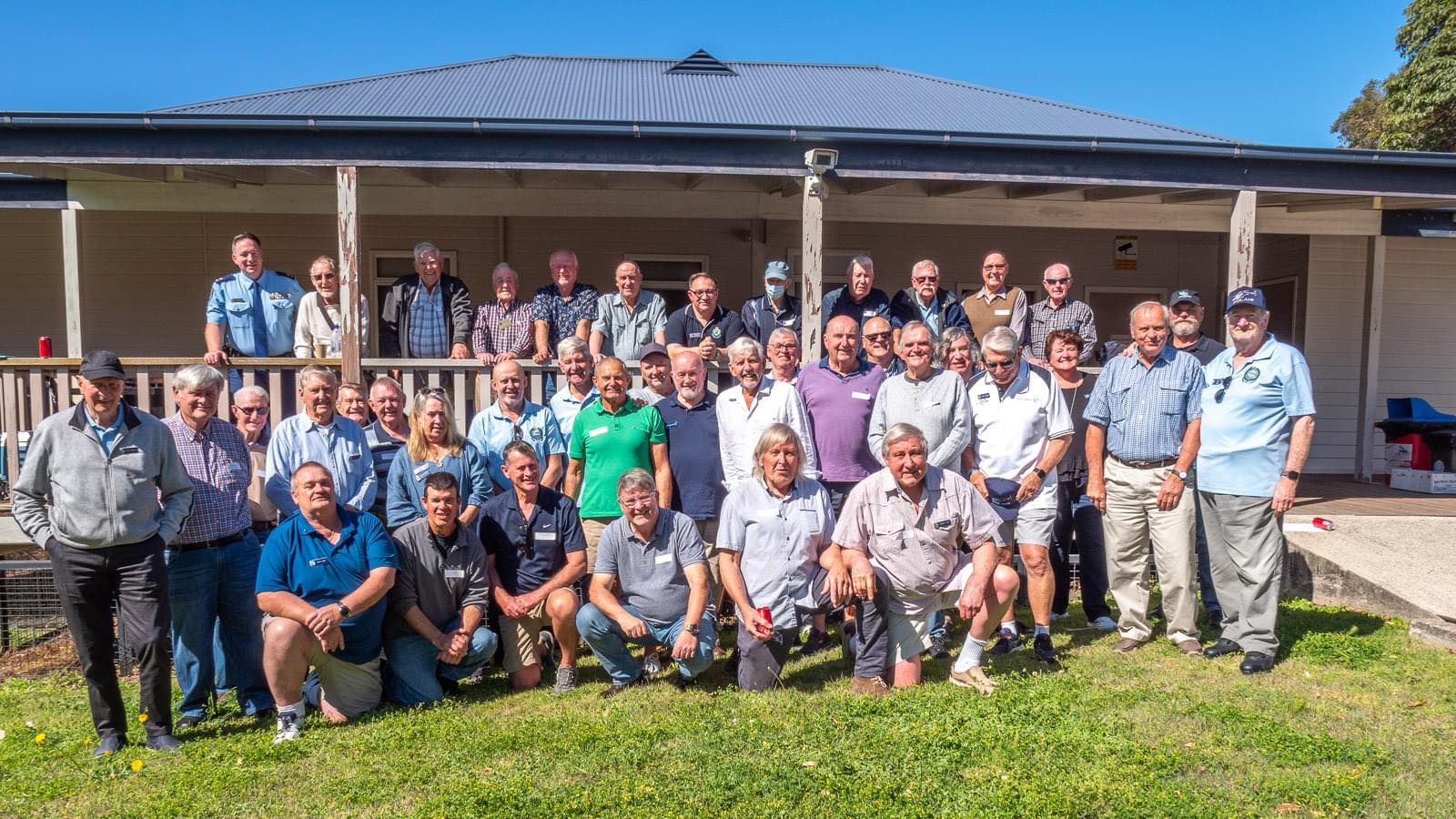
Pension Boosted But More Needed For Those In Need
Improving Quality Of Life Through Accommodation Design: Have Your Say
- accessibility
- dementia-friendly design principles
- the role of ‘small home models’ with residents living together in smaller ‘households’
- needs of diverse communities.
Exercise-Induced Hormone Irisin May Reduce Alzheimer's Disease Plaque And Tangle Pathology In The Brain
Link To A Bygone Era From The Comfort Of Home
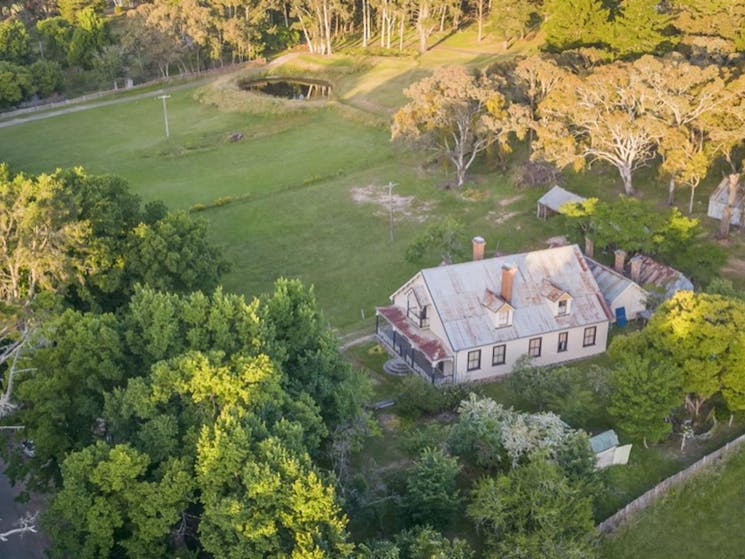
Medicare Failing To Keep Up With Rising Cost Of Care
Report Card On The Wellbeing Of Australians Looks At What’s Changed Since The COVID Pandemic Began
Act Now For A Dementia-Friendly Future This Dementia Action Week

‘An extremely serious musical comedy’ about Whitlam? Yes. The Dismissal is great fun, witty and sharply observed

The Whitlam government has a mythical status in the Australian popular imagination. While it lasted less than two full terms between December 1972 and November 1975, it has had an outsized cultural presence ever since.
This is not just because of Gough Whitlam’s transformative social democratic agenda, but because of the way his government ended: the dismissal remains one of the most shocking events in Australian political history.
Each year since, we have marked the anniversary with new stories, new angles, new details. The story has all the ingredients of high drama – indeed, the story was told in a rather ponderous television mini-series in 1983.
So almost 50 years on, what to make of a comedic musical retelling of these tumultuous events?
The Dismissal’s talented creators (Jay James-Moody, Blake Erickson and Laura Murphy) are neither Boomers who watched the dismissal from ringside seats or dewy-eyed Gen-Xers, but younger still.
For their generation, forged in a neoliberal world much harsher than the one that lifted up their parents and grandparents, the Whitlam policy agenda of free education, free healthcare and social democracy for all might seem like a distant, unattainable dream.
Crucially, the authors also don’t see the dismissal as a unique event. In their program notes, they argue the show is
the story of our political culture writ in bold, sung in harmony and danced in formation. Over, and over again.
So this show is not just a dramatisation of the events of 1975, it is also an attempt to understand our maddening political culture.
Self-Referential And Extremely Funny
Norman Gunston (a superb Matthew Whittet) guides the audience through the story and sets the tone for the show. We begin with the famous moment on the Parliament House steps. Playing Gough, Justin Smith both sounds and looks like him – no mean feat.

The Dismissal is least effective when it is striving for sincerity: the early number Maintain your Rage left me concerned the show might be too earnest to be genuinely funny.
However, my anxieties were assuaged by a very clever romp through the post-war years of Liberal rule (from Menzies to Holt to Gorton to McMahon), sung by suburban housewives and their lawn-mowing husbands. It is self-referential and extremely funny and sets a high bar for the rest of the show. Murphy’s lyrics are wonderful throughout, but they are especially brilliant here.
After Whitlam’s election, his policy achievements are dealt with in a rapid-fire slideshow, which moves things along but lowers the stakes in what follows. The real subject of the drama is the unravelling of the Whitlam government from within, thanks to the shenanigans of Jim Cairns, Rex Connor and the loans affair, and the role played by Sir John Kerr, Malcolm Fraser and Sir Garfield Barwick in undermining him from the outside.
The cast are uniformly excellent. Peter Carroll is uproarious as a Mephistophelian Sir Garfield Barwick. Octavia Barron Martin manages to invest Sir John Kerr with a touch of pathos. Monique Sallé is a showstopping Tirath Khemlani, a befuddled Billy Snedden and her Queen Elizabeth II has more than a touch of Rocky Horror about her. Joe Kosky’s Jim Cairns is both pompous and ponderous, with brilliant comic timing.

Andrew Cutcliffe’s Malcolm Fraser is stiletto-sharp and a little bit kinky. His Private School Boys is a bump-and-grind showstopper that recalls Alexander Downer’s Freaky from Casey Benetto’s 2005 musical Keating!
The song is reprised later by Lady Anne Kerr, whose purring refrain that “you’re not a match for private school girls” is a reminder that this is a story of class, mobility and social striving.
Sharp, Funny And Astute
The show’s gender-inclusive casting draws our attention to the almost all-male world of politics in the 1970s and gives many of the female performers the opportunity to behave disgracefully (Georgie Bolton as Rex Connor is spectacularly, hilariously crude).

Margaret Whitlam (Brittanie Shipway) and Junie Morosi (Shannen Alyce Quan) are voices of reason and resolve. While both are terrific, their roles in the narrative constrain their range: Margaret’s number Crash Through or Crash is an example of the ways the sincere songs don’t have the power to hold an audience in the ways that the satirical numbers do. Stacey Thomsett has much more fun with the role of Lady Kerr, who she depicts as Lady Macbeth in a Carla Zampatti suit.
It’s all great fun, witty and sharply observed. Yet perhaps the weakest part of the show is the ending. While we all know how this story ended, the creators didn’t seem to know how to draw their story to a close.
But overall, The Dismissal is sharp, funny and astute. It’s also a rare thing: an accomplished new Australian musical. I think Gough himself, with his love of Australian arts and culture, would have quite enjoyed it.
The Dismissal: An Extremely Serious Musical Comedy is at the Seymour Centre, Sydney, until October 21.![]()
Michelle Arrow, Professor of History, Macquarie University
This article is republished from The Conversation under a Creative Commons license. Read the original article.
Pittwater-Narrabeen Parkinson’s Support Group
Concession Car Parking At NSW Health Public Hospitals
- requiring treatment over an extended period
- attending hospital more than twice a week (including carers of long term patients who visit frequently).
- ongoing cancer treatment
- treatment more than twice weekly
- daily dressing changes
- cardiac rehabilitation or health promotion classes
- Transport for NSW Mobility Parking Scheme permit
- Pensioner Concession Card
- Department of Veterans' Affairs Gold Card
- Health Care Card.
- clearly displaying and publicising concessional rates
- streamlining the concession application process with designated points of access
- validating concessional parking for the duration of a course of treatment.
ACCC Calls For Views On Australia Post's Proposed Price Increase
My teen is addicted to vaping. How can I help them quit and manage their withdrawal symptoms?

The Australian government is cracking down on vaping. Recreational vapes of any type – whether they contain nicotine or not – will be banned from retail sale across Australia after legislation is introduced (though the date is yet to be set).
Rates of teen vaping have been rising rapidly in Australia, from 0.8% of 14- to 17-year-olds describing themselves as a current vaper over the past six months in 2018 to 14.5% in 2023. Among 18- to 24-year-olds, 19.8% have been a current vaper over the past six months.
Teens mainly get vaping products from their friends, retail vaping stores or the internet. Once the government restricts the distribution of vaping products, many will suddenly lose access to supplies.
In anticipation of this loss, people may start stockpiling vapes. But at some stage, they will have a drastic reduction in their use of vaping.
The majority of e-cigarettes contain nicotine, even when they’re not labelled as such. Some vapes tested in Australia contained 900 milligrams of nicotine – the equivalent of the nicotine in almost 100 cigarettes.
So we can expect teenagers who vape will experience nicotine withdrawal symptoms.
What Is Nicotine Dependence And Withdrawal?
Nicotine dependence means a person is physically and psychologically addicted to nicotine. This produces a strong desire for, and difficulty controlling, nicotine use.
Young people are at greater risk of nicotine dependence than adults and can develop dependence faster.
Once nicotine-dependent, a person will experience withdrawal symptoms if they reduce or cease their use. These symptoms can include irritability, frustration, or anger; anxiety; difficulty concentrating; increased appetite; restlessness; depressed mood; and insomnia.
The Hooked on Nicotine Checklist is helpful for teens and their parents. It’s a ten-item checklist to assess dependence on smoking cigarettes or vaping, specially designed for adolescents. The higher the score, the less control your teen will have over their nicotine addiction.
Feeling a loss of control can begin after using vapes for only a short time. Some adolescents start showing signs of becoming dependent on nicotine within days of occasionally using it – before they are smoking or vaping daily.

I Don’t Even Know If My Teen Vapes …
Nicotine exposure during adolescence can disrupt the brain’s normal development, impacting their mood, impulse control, memory and ability to focus and learn.
If your teen is unusually irritable or has an unexplained low mood, consider the possibility of nicotine withdrawal, particularly after vapes are no longer readily available. Many adolescents are vaping without the adults in the household being aware. Vapes can be hidden in plain sight, as they look like a highlighter pen or USB stick.
Initiating a conversation is sometimes easier when side-by-side, not face-to-face with a young person – for example, when walking together or if your teen is in the car with you. One way to bring the subject up is to ask whether any of their friends are vaping or if they’ve seen it at school. Then gradually move on to whether they have tried it themselves and their usage.
During the conversation listen out for hints that mean your teen could be a heavy user of vaping, such as:
- vaping alone, instead of only socially
- vaping within 30 minutes of waking up in the morning, or
- vaping through the night (this might mean keeping an e-cigarette under the pillow for night-time use).
So How Do I Help My Teen Quit?
Once you know your teen is vaping, broach the subject of quitting with them in a non-judgemental way. Try questions like “have you ever tried having a break from them?” and “how did that feel?”
If they are willing to attempt quitting, or are already withdrawing due to reduced access to vaping products, let them know you are there to support them and help is available.
First Try Counselling And Cold Turkey
The Quitline or a GP can help with goal setting, such as setting a quit date, making a quit plan and identifying triggers for vaping and strategies to address them.
There are also online tools your teen may like, such as My Quit Buddy, an app that provides practical tips, progress charts and health information to help with quitting.
Nicotine Replacement Therapy
If counselling alone is not successful, nicotine replacement therapy may help.
Nicotine-replacement therapy is available in a fast-release form (used by mouth via a nicotine inhalator, spray, gum, or lozenges) or a slow-release patch. For someone quitting vaping, fast-release forms are likely to work best.
However, sometimes a teenager might need more than one nicotine-replacement product, called “combination therapy”. Combination therapy is better when the teen is highly dependant on nicotine and has strong and frequent urges to vape.
Be sure to follow the instructions for each product and encourage regular doses so withdrawal symptoms are controlled.

Eighteen year olds can buy nicotine-replacement products without a script at a supermarket or pharmacy. A pharmacist can advise on the correct use.
If your child is aged 12–17, it’s recommended they are first assessed by their GP, who can prescribe nicotine-replacement therapy. A script from a GP may allow access to a subsidised course through the Pharmaceutical Benefits Scheme (PBS).
Aboriginal and Torres Strait Islander youth can get further help from their local Aboriginal health service, which can offer culturally safe support and may also have supplies of nicotine-replacement therapy.
When using nicotine replacement therapy, adherence is critical to successfully quitting. Use it for a minimum of eight weeks and preferably 12 weeks to avoid relapse.
GPs can also prescribe nicotine liquid (non-flavoured) for a refillable e-cigarette. But clinical guidelines recommend discouraging vaping because of their ongoing addictive nature because they’re a gateway for smoking tobacco.
Teens who vape are three times more likely to take up smoking. So addressing your teen’s vaping is an important preventative step for both smoking and vaping in future. ![]()
Gillian Sandra Gould, Professor in Health Equity, Southern Cross University; Karen McFadyen, Research Fellow, Faculty of Health, Southern Cross University, and Marilyn Clarke, Senior Research Fellow, Southern Cross University
This article is republished from The Conversation under a Creative Commons license. Read the original article.
Long COVID symptoms can improve, but their resolution is slow and imperfect

Around 5–10% of people who get infected with SARS-CoV-2 will experience symptoms that persist way beyond the initial acute period, a clinical syndrome we are learning more about, known widely as long COVID.
Shortness of breath, brain fog, lethargy and tiredness, loss of smell or taste are common features of long COVID, as is the development of new conditions such as diabetes, heart disease, stroke, depression and dementia.
But how long is the “long”? If and when do symptoms resolve?
A recent study has examined this in detail, following people for two years after their infection. This and other recently published studies on long COVID show that while symptoms do resolve in many people, their resolution is slow and imperfect.
What Did The Study Find?
The key work, led by Ziyad Al-Aly, examines the effect of SARS-CoV-2 two years after infection in a large group of US veterans. The researchers followed 139,000 people with COVID and almost six million uninfected controls for two years, tracking deaths, hospitalisations and 80 long-term impacts of COVID, categorised into ten organ systems.
They found that people who were initially hospitalised with COVID were 1.3 times more likely to die and 2.6 times more likely to be hospitalised again, compared to the control group (people without COVID), over the two years. After two years, this “hospitalised” group remained at increased risk of 50 conditions.
People who had milder COVID (who weren’t hospitalised with their initial COVID infection) had an increased risk of death for up to six months and increased risk of hospitalisation for up to 18 months. However, at two years, they remained at increased risk of 25 conditions.
So, while people who were initially hospitalised for COVID had worse outcomes over the two-year follow-up, there was still a substantial burden of illness in people who initially had milder COVID. This included a risk of clots and blood disorders, lung disease, fatigue, gut disorders, muscle and joint disorders and diabetes.

Findings From Other Recent Research Were Similar
A separate cohort study followed more than 208,000 veterans with COVID over two years. It showed that overall, 8.7% died compared with 4.1% in the uninfected control group. The risk of death was concentrated in the first six months after infection.
A third, not yet peer-reviewed and smaller cohort study of 341 people with long COVID from Spain, found only 7.6% of them recovered at two years.
Another significant (not yet peer-reviewed) study from the United Kingdom assessed diabetes risk after COVID by following 15 million people in England from 2020–21. It found a 30–50% elevated risk of new type 2 diabetes after COVID. This increased risk persisted up to two years. But the risk for type 1 diabetes risk did not persist.
An Australian (not yet peer-reviewed) study followed 31 people who developed long COVID and 31 matched controls who recovered from COVID for two years. It found that most of the concerning immunological dysfunction effects that had been present at eight months, had resolved by two years. While almost two-thirds of those with long COVID (62%) reported improved quality of life over the two years, one-third were still struggling in this regard two years after their infection.
Finally, a recent whole-body positron emission tomography (PET) imaging and biopsy study showed prolonged tissue level immune-activation and viral persistence in the gut for up to a remarkable two years after COVID.
These Studies Have Some Limitations
It’s important to note the observational studies have some inherent limitations.
The US veterans cohort studied by Al-Aly is nearly 90% men, with an average age of 61 years, which is different to groups most at risk of long COVID.
They acquired their initial infection in 2020, before Omicron, before vaccination and before therapies – all of which are protective against long COVID to a degree.
Having said that, long COVID still frequently occurs in vaccinated people infected with Omicron.
We Still Don’t Have Treatments For Long COVID
Increasing understanding about underlying mechanisms of long COVID, such as those involving persistent virus and effects on mitochondria – the powerhouse of the cells - can lead to treatment options that need to be trialled.
In July 2023, the White House established the Office of Long COVID Research and Practice. Two randomised trials are testing whether the antiviral nirmatrelvir-ritonavir (Paxlovid) can treat long COVID are currently recruiting patients.

A separate randomised, placebo-controlled trial has shown that metformin, a commonly prescribed anti-diabetic medication, taken for two weeks (and taken within three days of testing positive for COVID) reduced the chance of developing long COVID by 41%. The mechanism may involve an effect on mitochondria or directly on the virus.
But It’s Still Important To Prevent COVID (Re)Infections
Taken together, these studies on the longevity of long COVID add substantially to the case to fast-track the development of interventions and therapies to prevent and/or cure the condition.
In the meantime, it’s crucially important to prevent (re)infections in the first place to reduce the future burden of long COVID, already estimated to be greater than 65 million people globally.
Breathe clean air by ensuring indoor spaces are well-ventilated. In poorly ventilated or crowded spaces, wear a well-fitted and high-quality mask (a P2, KN95 or N95 mask), and/or use air filtration devices suitable for the space you are in.
Keep up to date with boosters. And get tested so you can get antiviral treatment if you’re eligible.
If you suspect you have long COVID, discuss this with your GP, who may refer you to specialised services or multidisciplinary care.![]()
Suman Majumdar, Chief Health Officer, Burnet Institute and Brendan Crabb, Director and CEO, Burnet Institute
This article is republished from The Conversation under a Creative Commons license. Read the original article.
Being the main breadwinner didn’t necessarily keep married mums in work during the pandemic

In the toughest days of the pandemic, many dual-income families made the difficult choice to drop down to one income.
With dads being the primary earners in many heterosexual households, it was often the mother who gave up her job to manage all the extra housework, homeschooling and childcare the pandemic brought.
But what about heterosexual households where the mother was the primary earner?
Our study, published in the Journal of Marriage and Family, involved analysis of 7,139 different-sex married parents in the United States, captured at multiple time points. We found many married mothers who earned half or more of the family’s income got knocked out of employment during the first 18 months of the pandemic.
The employment rate of fathers who earned the bulk of the money over this time dropped much less, we found. In fact, it barely changed.
Our study also found the ability to work remotely was an important lifeline for mothers to retain employment. Overall, earning more of the income couldn’t guarantee mothers would be protected from employment loss, but working remotely was crucial to mothers remaining employed.

Even Earning More, Many Mothers Were Knocked Out Of Employment
To track US mothers’ employment over the duration of the pandemic, we used data from the Annual Social and Economic Supplement of the Current Population Survey. The data are collected by the US Census Bureau.
Our sample included civilian respondents aged 25–54 who were different-sex, married parents with children 12 years or younger. In each case, both the respondent and their spouse reported working for pay in 2019, before the pandemic started.
We used this data set to follow mothers’ and fathers’ employment patterns over the first year of the pandemic (January 2020 to May 2021).
We found fathers in this group who were primary earners tended to remain employed over this period.
The employment rate for mothers, by contrast, dropped significantly in the first few months and never fully recovered. It didn’t matter if mothers were primary earners or not – their employment rate still dropped.
In fact, by the March to May period of 2021, mothers’ employment was over four percentage points lower than pre-pandemic levels – regardless of their earnings.
So, earning more of the family income didn’t necessarily shield mothers from employment loss. What did matter, however, was access to telecommuting.
Mothers who could work online had significantly higher employment rates across the period of our study than mothers who couldn’t. Additionally, the positive effect of telecommuting on employment was four times larger for mothers than for fathers.
Telecommuting was a lifeline for mothers’ employment during the pandemic.

The Pandemic-Pummelled Mothers
These findings build on our previous research showing US mothers’ employment was hit hard during the pandemic.
At the start of the pandemic, our previous research found nearly 250,000 more mothers than fathers exited employment from February to April 2020.
We also found in prior studies that US mothers with children aged five or under reduced their work time four to five times more than equivalent fathers.
We also showed that in-person learning in the latter part of 2020 was lower in US districts with higher proportions of Black and Hispanic students. Remote learning across the 2020–2021 school year led mothers’ but not fathers’ employment to drop, especially for those with less education and limited access to telecommuting.
And our earlier research revealed how US mothers stepped into more housework and childcare, causing sleep problems, anxiety and stress.
As we discussed these findings with researchers and the community, one question would keep coming up: isn’t all this just the consequence of fathers earning more?
Isn’t it a “rational” choice to shield fathers from job loss, rather than mothers, because men tend to be the primary earners?
Our recently published research shows that, no, this was not necessarily about who made more money in the household – it is often about who is expected to provide care when times get tough.
Many mothers got knocked out of employment even when they were the family’s highest earner.

Where To From Here?
US mothers have now returned to employment at pre-pandemic levels. But we can’t ignore the fact many mothers stepped into the added care of the pandemic while also trying to maintain their work lives. Many couldn’t and employment dropped. Others experienced significant earnings losses even while remaining employed.
For those with the option to work remotely – who are largely employed in professional jobs – this benefit was and remains critical to their ability to hold onto their job. Despite this, employers are increasingly removing this lifeline and demanding a return to the workplace.
These lessons also extend to other Western nations. In Australia, for example, mothers picked up more housework and childcare at the expense of their health and wellbeing (as did fathers). Australian workers want remote work to remain which has long been critical to mothers maintaining employment and to avoid burnout.
The pandemic showed care work is critical to our lives and we must support those who do it.
For married heterosexual mothers, this means acknowledging the tolls of the pandemic and ensuring access for all in relevant occupations to critical resources like telecommuting.![]()
Leah Ruppanner, Professor of Sociology and Founding Director of The Future of Work Lab, The University of Melbourne; Caitlyn Collins, Associate Professor of Sociology, Arts & Sciences at Washington University in St. Louis; Liana Christin Landivar, Faculty Affiliate, University of Maryland, and William Scarborough, Associate Professor of Sociology, University of North Texas
This article is republished from The Conversation under a Creative Commons license. Read the original article.
Study Finds Women Would Make Different Maternity Care Choices If They Had Another Baby
 New research led by Western Sydney University has found over 85 per cent of women in Australia would make different maternity care choices if they had another baby, including around advocating for themselves, the type of birth, and model of care.
New research led by Western Sydney University has found over 85 per cent of women in Australia would make different maternity care choices if they had another baby, including around advocating for themselves, the type of birth, and model of care.- ‘I want to be a better advocate for myself’ – 3958 comments, 39.2 per cent – described how women reflected on their previous experience, feeling the need to better advocate for themselves in the future to receive the care or experience they wanted.
- ‘I want a specific birth experience’ – 2872 comments, 28.5 per cent – highlighted the types of birth women would choose for their next pregnancy and this was most often a vaginal birth.
- ‘I want a specific model of care’ – 1796 comments, 17.8 per cent – highlighted the model of care women would choose for their next pregnancy and this was most often continuity of midwifery care.
- ‘I want better access’ – 294 comments, 2.9 per cent – identified financial and/or geographical constraints women experience trying to make choices for birth.
Study Confirms It: Opposites Don't Actually Attract
ACCC Takes Court Action Alleging Qantas Advertised Flights It Had Already Cancelled
- Qantas flight QF93 was scheduled to depart from Melbourne to Los Angeles on 6 May 2022. On 28 April 2022, Qantas made the decision to cancel the flight. Despite this, Qantas did not remove the flight from sale until 2 May 2022, and did not inform existing ticketholders of the cancellation until 4 May 2022 (two days before the flight).
- Qantas flight QF81 was scheduled to depart from Sydney to Singapore on 4 June 2022. On 8 February 2022, Qantas made the decision to cancel the flight. Despite this, Qantas did not remove the flight from sale until 27 March 2022, and did not inform existing ticketholders of the cancellation until 28 March 2022.
- Qantas flight QF63 was scheduled to depart from Sydney to Johannesburg on 31 July 2022. On 8 February 2022, Qantas made the decision to cancel the flight. Despite this, Qantas did not remove the flight from sale until 27 March 2022, and did not inform existing ticketholders of the cancellation until 28 March 2022.
- Qantas flight QF486 was scheduled to depart from Melbourne to Sydney on 1 May 2022. On 18 February 2022, Qantas made the decision to cancel the flight. Despite this, Qantas did not remove the flight from sale until 15 March 2022, and did not inform existing ticketholders of the cancellation until 16 March 2022.
- Qantas flight QF1785 was scheduled to depart from Gold Coast to Sydney on 1 May 2022. On 17 February 2022, Qantas made the decision to cancel the flight. Despite this, Qantas did not remove the flight from sale until 15 March 2022, and did not inform existing ticketholders of the cancellation until 16 March 2022.
- Qantas flight QF696 was scheduled to depart from Adelaide to Melbourne on 23 July 2022. On 18 June 2022, Qantas made the decision to cancel the flight. Despite this, Qantas did not remove the flight from sale until 26 June 2022, and did not inform existing ticketholders of the cancellation until 27 June 2022.
- Qantas flight QF1764 was scheduled to depart from Canberra to Gold Coast on 27 June 2022. On 16 June 2022, Qantas made the decision to cancel the flight. Despite this, Qantas did not remove the flight from sale until 19 June 2022, and did not inform existing ticketholders of the cancellation until 20 June 2022.
- Qantas flight QF513 was scheduled to depart from Brisbane to Sydney on 8 June 2022. On 27 May 2022, Qantas made the decision to cancel the flight. Despite this, Qantas did not remove the flight from sale until 30 May 2022, and did not inform existing ticketholders of the cancellation until 31 May 2022.
- Qantas flight QF45 was scheduled to depart from Melbourne to Denpasar on 1 May 2022. On 8 February 2022, Qantas made the decision to cancel the flight. Despite this, Qantas did not remove the flight from sale until 24 February 2022, and did not inform existing ticketholders of the cancellation until 23 March 2022.
- Qantas flight QF649 was scheduled to depart from Sydney to Perth on 30 July 2022. On 18 February 2022, Qantas made the decision to cancel the flight. Despite this, Qantas did not remove the flight from sale until 7 March 2022, and did not inform existing ticketholders of the cancellation until 8 March 2022.
- $10 million,
- three times the total benefits that have been obtained and are reasonably attributable, or
- if the total value of the benefits cannot be determined, 10 per cent of the corporation's annual turnover.
Will it be greener pastures for Qantas as Alan Joyce takes off?
Rico Merkert, University of SydneyA turbulent two weeks for Qantas have today culminated in its group chief executive Alan Joyce fast-tracking his retirement by two months to help the organisation and its brand accelerate its renewal.
Joyce was on the way out in any case, and was paid a board-approved bonus worth more than A$10 million on Friday, to which were to be added short-term and long-term bonuses taking the total to $24 million.
What the early retirement will do is bring forward the arrival of chief executive-designate Vanessa Hudson to Wednesday, to enable her to drive a cultural change and a new strategy.
It is not unreasonable to assume she will say that what happened in the past is Joyce’s legacy and that under her leadership the airline will transform and essentially start with a clean sheet.
The New Chief’s Key Challenges
Accelerating renewal of the fleet to improve its carbon impact is likely to be at the core of Hudson’s strategy. While the arrival of these “better for the environment” planes is expected to be expedited, the challenge for Hudson is to find the A$12 billion to A$20 billion that will enable Qantas to get to these greener and more sustainable pastures.
Taking greater care of the environment and the communities that Qantas serves, and having this as a key pillar of the renewed strategy and corporate communication, will be good for the airline. It will allow it to transform into an internationally and domestically competitive carrier, fit for the future in which climate change will become an even more pressing issue.
What many commentators are questioning is why Joyce was allowed to retire early. In fact, the board may have recommended he do so.
Regardless, this latest twist seems like an easy way out, as it saves him from fronting shareholders at the upcoming AGM, during which he would have had to respond to angry questions and account for the crisis Qantas is now in.
This will now be the board’s role and will include, among other things, fielding questions around the chief executive’s bonus (including the retirement package, which was going to be announced as part of the annual report presented to the AGM) and his performance. The ACCC allegations around selling tickets on cancelled flights, the pending court case related to COVID flight credits, the damage done to the brand and how to repair it will also be raised.
Did Qantas Sway The Government To Block Qatar?
There will likely also be questions around Qantas’s role in lobbying the Australian government to reject Qatar’s application to essentially double its air traffic rights (three more daily flights to Sydney, Brisbane and Melbourne).
This would have helped restore capacity - and thus drive down airfares - on the Europe-to-Australia sector, which is still 30% below pre-pandemic levels.
That, however, may be a question that should be directed at the government. Yesterday, Prime Minister Anthony Albanese even felt the need to declare he had not been lobbied by Qantas on the Qatar Airways decision.
When I read this, I wondered, was someone at Qantas not doing their job? As applies to any ASX listed company and airline in the world, they have an entire department that does nothing else but lobby politicians. That is how the game works and is entirely accepted.
As outlined in my analysis published on The Conversation last week, bilateral air service negotiations are a government affair akin to trade agreement negotiations.
The Australian government will, on a regular basis, negotiate with the governments of Qatar, Singapore, the United Arab Emirates, the United States and others on such matters, and airlines at both ends of the negotiating table will lobby their respective governments.
Based on what is in the best interests of the country, the government – in our case the Transport Minister Catherine King – then makes a determination. There is, therefore, opportunity for the government to revisit such decisions or come to a less restrictive determination in future rounds.
All of the above suggests there is huge potential for a fresh start and for building a better and more sustainable future for Australia’s largest airline, which will be beneficial to Australian travellers and the economy at large.![]()
Rico Merkert, Professor in Transport and Supply Chain Management and Deputy Director, Institute of Transport and Logistics Studies (ITLS), University of Sydney Business School, University of Sydney
This article is republished from The Conversation under a Creative Commons license. Read the original article.
Qantas chief Alan Joyce quits early, amid customer fury at the airline
Michelle Grattan, University of CanberraEmbattled Qantas boss Alan Joyce will quit immediately, bringing forward his retirement by two months.
A Qantas statement early Tuesday said the CEO had advised the board he was doing this “to help the company accelerate its renewal”.
Joyce has been under sustained attack over the airline’s poor service, high prices, and customers’ difficulty in retrieving flight credits. The Australian Competition and Consumer Commission has launched legal action against Qantas for continuing to sell tickets on flights already cancelled.
Last week Joyce was subjected to a ferocious grilling in the senate inquiry into the cost of living. Later in the week Qantas scrapped the expiry date for flight credits.
The spotlight on Qantas has intensified with the Albanese government’s refusal to let Qatar Airways have additional flights on the routes it requested – seen as a decision to protect Qantas, which lobbied against the extra flights. Some state Labor governments have urged the decision be reversed.
Qantas CEO-designate Vanessa Hudson will assume the role of Managing Director and Group CEO on Wednesday.
Joyce said:
In the last few weeks, the focus on Qantas and events of the past make it clear to me that the company needs to move ahead with its renewal as a priority. “The best thing I can do under these circumstances is to bring forward my retirement and hand over to Vanessa and the new management team now, knowing they will do an excellent job.
He said he left Qantas, where he has been chief executive for 15 years, with a lot to be proud of.
There have been many ups and downs, and there is clearly much work still to be done, especially to make sure we always deliver for our customers. But I leave knowing that the company is fundamentally strong and has a bright future.
Qantas Chairman Richard Goyder said: "Alan has always had the best interests of Qantas front and centre, and today shows that. On behalf of the Board, we sincerely thank him for his leadership through some enormous challenges and for thinking well-ahead on opportunities like ultra long-haul travel.”
Goyder said the transition came at “a challenging time” for the airline and for its people.
“We have an important job to do in restoring the public’s confidence in the kind of company we are, and that’s what the Board is focused on, and what the management under Vanessa’s leadership will do,” Goyder said.
On Friday Qantas notified the ASX that Joyce had been given a total of $10.8 million in shares under a COVID retention scheme and for long-term bonuses from 2020-22, which he had deferred.
Recently Joyce sold a large packet of Qantas shares.
UPDATE
Late Tuesday, the Coalition succeeded in getting Senate support for an inquiry into the Qatar affair. The Greens opposed the move but other crossbenchers supported it.![]()
Michelle Grattan, Professorial Fellow, University of Canberra
This article is republished from The Conversation under a Creative Commons license. Read the original article.
Disclaimer: These articles are not intended to provide medical advice, diagnosis or treatment. Views expressed here do not necessarily reflect those of Pittwater Online News or its staff.